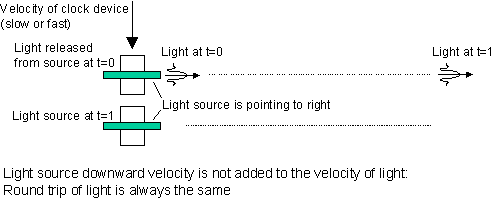|
DSSP Topics for May
'12
Movement is easy, except .. .. |
|
Background
We walk
effortlessly. We just push off and off we go. That's how the world is
to a kid. Throw a ball and the ball will hit and move something else.
By the time you grow up you find out it is not so simple. You want to
step off a canoe onto a pier -- and end up wet. The canoe just slides
off backward as its friction is low. Yes, there is the conservation
of momentum going on here. Not just for a canoe but for a rifle
bullet that must share its moving energy with the rifle. The same
also hold for the rotational motion. A helicopter needs a second
propeller that keeps it from spinning just like the main propeller.
So now we all know
that in any creation of motion we have really two opposing
motions: In the opposite directions for linear movement and in the
opposite rotations for angular movement.
What's the big deal?
The thing is that
the conservation of momentum holds for photons, too. A photon that
bounces cannot impart motion to anything it strikes if the
photon's speed after the bounce is the same as the speed before the
bounce, which is indeed the case. There would be excess energy if the
thing that is hit by a photon were to move. Waves are different but
the conservation of energy holds for waves, too. In the real world
the ball that rebounds is moving slower but such is not the case for
a photon.
The big deal is
that even if the
photon is absorbed and its energy utilized, such energy must move (or
spin) two things in the opposite direction (or in opposite rotation).
Somehow, this guy Einstein got it all wrong with the photoelectric
effect because you know that there must be two things -- and not just
one electron -- to move in the opposite direction, and that is how
the momentum is and must be conserved. Yes, kiddo, this is a test. |
|
 |
|
DSSP Topics for April
'12
Horus, after beating up Seth
good, went to the court of the gods to be declared the ruler.
One of the oft-repeated arguments
was that Horus' eye was undamaged. Are the hereditary rights based on
geometry and not on, say, blood? |
|
Background
The ancient
Egyptian story has it that Seth killed Osiris and took his kingdom.
Isis gave birth to Horus after finding the body of Osiris, Horus'
father. Yes, Isis had to do some magic to bring Osiris back to life
and conceive Horus. After Horus grew up he engaged Seth in a fight
and both scored significant victories onto each other. The case then
ended up in the court of gods that decided Horus was to get his
father Osiris' kingdom back.
The case is
closed, except
that during the
trial the argument in Horus favor was that Horus' eye was undamaged.
Another argument was that if Seth gets the kingdom, "the heavens
will touch the earth" (with destruction). This is strange
considering that "here on earth" we argue about the blood
lines when it comes to claiming the properties of the deceased. (I
know, owning people is about slavery and presently that's not
specifically enforced -- especially after the fall of the Berlin
Wall.) The eye, however, plays a pivotal role in the exercise of
power, both constructive and destructive. Although not explicitly
stated, the undamaged eye is understood as the fundamental
requirement. Yeah, the gods know this stuff but we don't.
The eye
is a geometric
construct analogous to the focus of a lens. It is not focusing the
light (e-m radiation) but focuses something else and additionally is
able to contact, interact with, and collect the infinities. This is
not terribly strange if we accept that intelligence is 'out there'
and intelligence is organized energy. There are descriptions of gods
such as Thoth using the eye to do what they need to do. More
recently, eyes appear to either create of examine the crop circles.
But, hey, this is
also the month of April and this topic is posted on, you guessed it,
April 1. |
|
|
 |
|
DSSP Topics for March
'12
The computer computes the forces
but, even so, the computer cannot move
What's the computer good for? |
|
Background
So the wonderful
computer cooks the numbers really fast, but so what? The computer can
estimate a trajectory of something moving, but then it needs to burn
fuel to get there. This is something we do not question very deeply.
It is "obvious" the computer cannot move by itself by
executing an instruction and without actually controlling an engine.
Why not?
That's how we are
programmed. The computer computes, rocket moves. So there.
Are there
structures that can actually move as a result of internal computations?
Yes there are. The
question is, really: 'Can you move without propulsion, too?' Some
free energy devices move as if by themselves, and it is then
conceivable to compute something and, as you do, you begin to move as
well. Except that the computer is no longer electronic but
geometrical. Yes, just as you can compute the SQTR(2) on a machine,
you can compute the SQRT(2) on a geometric structure and the result
is a particular and actual distance having the result of the SQRT(2).
If there are geometric structures that convert a wavelength to a
frequency, you just actually converted a wavelength to energy. So there. |
|
|
 |
|
DSSP Topics for February
'12
The real methods are those of a computer
The virtual methods are those of waves
Each bring something to the
table, but then -- what to do with it? |
|
Background
The computer is
great because we can specify the behavior of a system and then let
the machine rip. The waves come up as probability waves. If the
system is a car, there are all kinds of options, preferences and
performances one needs to consider before making the car. After the
car is made there arise new probability waves because the car is
getting old and some customers want new things -- from a coffee
holder to sat navigation and WiFi.
Real Methods
Right away we see
that the car does not get better on its own. The real method uses the
'IF-THEN' logical construct to define the system. (IF we offer a
6-cyl engine THEN our sales go up by 20% and our cost by 1%.) In
fact, our present computer works the way it does by implementing the
IF-THEN construct and a human has to fill it in.
Virtual Methods
go by our own feel
because the computer cannot handle "maybe." If you bring a
computer to a brainstorming session you could take notes so that you
don't forget the stuff, but the computer cannot suggest answers. The
brainstorming has no rules other than an objective of increasing
sales or decreasing defects, but after that the discussion points are
limitless. The virtual methods use the 'WHAT ELSE' method, which
asks: "What else is relevant to the objective?"
In summary,
the real methods
specify what is inside the box and how things inside the box could be
made more efficient. The virtual methods redefine the box itself.
So What
You always want to
ask this question because there is always a lot of noise in
everything. The thing is that the real methods are used by your left
brain whereas the virtual methods by your right. You can be dominant
in one or the other but you need both.
Then What
When you use both
methods you self-organize. So now you have to figure out how the
actual left and right brains do it. You will need geometry. Think of
the box as the context. "Left" is the finite,
"right" is the infinite. |
|
 |
|
DSSP Topics for January
'12
An electron cannot be split.
But can the electron be parted --
that is, branched, just as a photon? |
|
Background
The dual slit
experiment nicely shows what a photon does when it encounters two (or
multiple) slits. A photon parts and both branches coherently leave
the slits (yes, we've got a primer
on that). Branches then superpose to different degrees at the point
they reach a different parts of a screen and that is how the
undulating superposition pattern of light forms.
A problem, if you
can call it that, is with an electron. Our image is that of a solid
particle and, even though an electron does produce qualitatively the
same superposition pattern as a photon in a dual slit experiment, we
are kind of stumped on the explanation. We know an electron can and
does have a probabilistic distribution (that can vary, too), but
somehow the word 'particle' sits in our mind and it is tough to see
an electron becoming a wave. This is a spot the academia
reaches and here it stops for them. There is no academic (that I know
of -- and let me know if there is), who would claim an electron parts
just like a photon when encountering two slits.
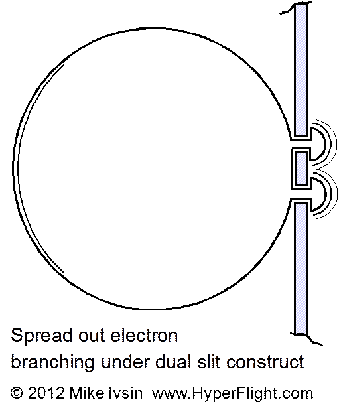 A
Wave A
Wave
is something that
has energy. Unlike a photon, an electron can be imparted with energy.
An electron can be shaped as a wave and such shapes are not confined
to 1D (straight-line velocity) à la photon, but can also be in
2D or 3D. The "big" step is the realization an electron can
spread and become a virtual electron. In such state, moreover, an
electron can become larger than the distance between the two slits.
So,
an electron can
indeed pass through a plurality of slits as one entity and you'll
observe self-superposition ("self-interference") once the
superposing waves reach the screen on the right (not shown). For
those of you who paid good money (yours or parents') for your
education, you've got to undo your work, although you would not be as
successful in getting your money back. There are the doozies the
likes of Feynman who don't understand waves and feed you particle
nonsense. Not all of academia is as screwed up as Feynman, though.
Both Schrödinger and Dirac are on track.
Now,
the question that
needs answering is what happens when the tail (leftmost part in the
illustration) of the electron reaches the slots. The thing is that
indeed the electron cannot be split -- in half or otherwise. The
answer is not that difficult and you can also find it in the upcoming
book (mid 2012). Think along the lines of a photon. |
|
|
 |
|
DSSP Topics for December
'11
A big public university doesn't
get it in more ways than one |
|
Background
I think I can say
that all of us at one time or another strongly disagreed with
statements coming from universities, usually plastered on the web as
if they were the most current and objective research results your tax
money can buy. I think of it as silly ideas one grows out of. But
then there are times I take notice because the school not only gets
the science wrong but is also totally ignorant about this country's
heritage of fairness. As if suddenly the university professors got
empowered to say anything and do it with public money to boot.
http://van.physics.illinois.edu/qa/listing.php?id=1424 site
talks and discusses the pressure a beam of light is supposed to put
on a mirror. The moderator is anonymous. Wow. The questions and
answers are one sided. No opposing views are posted. A challenge
question by the moderator puts you on a page to report sites you
think are baloney. Geez. All this on a public nickel.
Ideology
is something that
is not supposed to be questioned because it just is that way. It
seems the University of Illinois is getting money for work that could
be just plain nonsense and then they need the political arm that
would tell us we should see the world the same way as their funding.
Not bad for a nice piece of fraud. Well, okay, they hide people
behind some Mike W. who tells us we should listen to him and 'beware
of other ideas.'
References
is something used
heavily by academia. The anonymous author/moderator in response to
one of the 'light has momentum' questions says that "It's been
measured in countless experiments." Not only does he not furnish
a single reference, but in fact there is no single experiment that
would measure the light's pressure on a mirror in, say, Newton/m2.
For fifty years scientists are hiding behind equations and when they
lie about the measurements they do so anonymously and in this case
with public money as well.
Now,
if you think the
economy is bad because America is not competitive, you are right. But
before that changes you'll have to be honest. There is absolutely
nothing wrong about booting the professor, too.
As for me, I
reported their own site as baloney. My guess is that they were never
really honest about being honest and so .. |
|
Happy New Year.
Think Free Energy |
|
 |
|
DSSP Topics for November
'11
And then it disappears |
|
Background
A thing is a thing
because it stays that way. A piece of a rock, a planet.
Except
that it must have
been put together somehow. Perhaps with the help of the Pythagorean tetractys/tetrahedron.
But then
it can be unmade
as well. If it was made from nothing then it could be made back into
nothing. In a way this would be okay because there would be no trash,
no poisons.
Except
that the knowledge
that has put things together and taken them apart would not be unmade
and in fact be available.
But now,
would it be
possible to have that piece of the rock disappear and then reappear
again without being remade?
Yep, it would.
Now, how about you? |
|
|
DSSP Topics for October
'11
Clockwise and counter-clockwise
stars have always made a diff. But why? |
|
Background
Drawing a star
clockwise or counterclockwise has always made a big difference in
Wicca. Scientists don't care because it does not mean anything to
them. In Wicca, CCW is also called 'opening' while CW is 'closing' or
'banishing.' This could be nice and handy to witchcraft folk, but if
there is more to it, I'd want to know.
It turns out
there are
harmonious and disharmonious tones, and the nice thing about that is
that we can agree on which are which. The harmony in music, then, is
absolute. If you could plot the dual tones as geometric stars, you
could find out why some (dual) tones are harmonious. Correspondingly,
some stars would then be harmonious and some not. Hearing disharmony
and seeing disharmony are presently easier to percieve audially than
visually. The details and the reasons of harmony are in the Quantum
Pythagoreans book, and the idea is that the clockwise pentacle
is not harmonious while the counterclockwise pentacle is harmonious.
So now we give Wiccans a big credit, for their 'closing' is the same
as disharmonious while their 'opening' is the same as harmonious.
There is more
because any CC
star (CC star is made on Concentric Circles) can be classified as
harmonious or disharmonious, other stars -- besides the five pointed
ones -- can be also found as 'opening' or 'closing.' Indeed, there is
one ten pointed star that, if drawn counterclockwise in a particular
sequence, is harmonious. 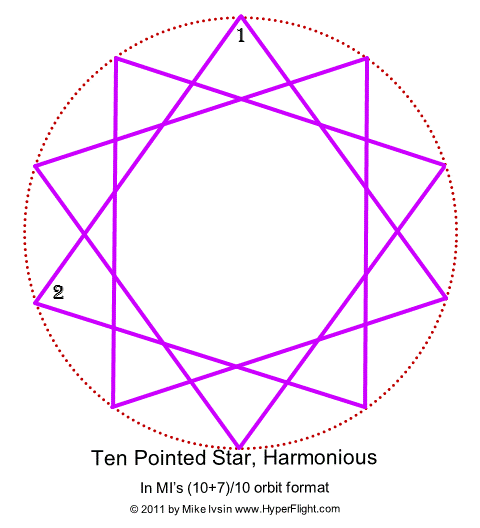 Yes,
we have a picture. I count the points in a convention that goes
clockwise starting at the top and then you have to skip six points to
get this harmonious ten pointed star. In Wicca or on this site, this
ten pointed star could also be classified as
"couterclockwise," because connecting the first two points
looks as going CCW. Yes,
we have a picture. I count the points in a convention that goes
clockwise starting at the top and then you have to skip six points to
get this harmonious ten pointed star. In Wicca or on this site, this
ten pointed star could also be classified as
"couterclockwise," because connecting the first two points
looks as going CCW.
Is the cw
or the ccw
the key?
No. A decagon is
disharmonious cw or ccw. A pentagon is harmonious cw and
disharmonious ccw [bomb them to the stone age]. The counterclockwise
octagon is harmonious but both of the ways of doing the octacle -- cw
or ccw -- are disharmonious. The octacles are used heavily in the
Muslim world and if they don't know what's going on they just thrash about. |
|
|
DSSP Topics for September
'11
Octahedron, third of the five
Platonic solids |
|
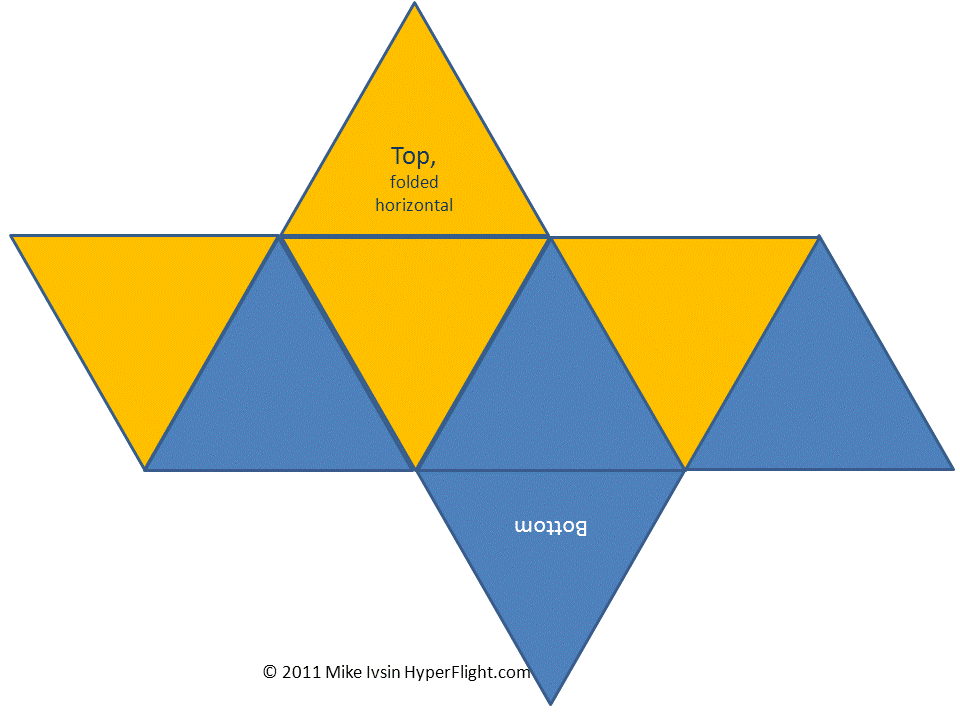 Background Background
There are five and
only five so-called Platonic solids: Tetrahedron (three sided
pyramid), Cube (six squares), Octahedron (double four sided pyramid,
base-to-base), Dodecahedron (twelve pentagons), and Icosahedron
(twenty triangles). They are called solids because they are in 3D.
Even Pythagoreans get a part coming up with some of them, according
to Proclus [and I like Proclus].
Octahedron
is a solid that,
since antiquity, has been shown as the double pyramid. But by giving
it a slight tilt a different octahedron emerges. It is made of eight
triangles that, however, make a "triangular drum." When
folded out, the sides look like the ones shown on left.
In this Octahedron
top and bottom
triangular sides are labeled as such. The other yellow triangles
connect to the top triangular side and point down. The other blue
triangles are connected to the bottom triangular side and point up.
Logically and topologically it is very similar to a cube except that
instead of squares it uses triangles for all of its sides. So I call
it the triangular cube. It can also be called a triangular
drum, much the same way a cube could be called a square drum.
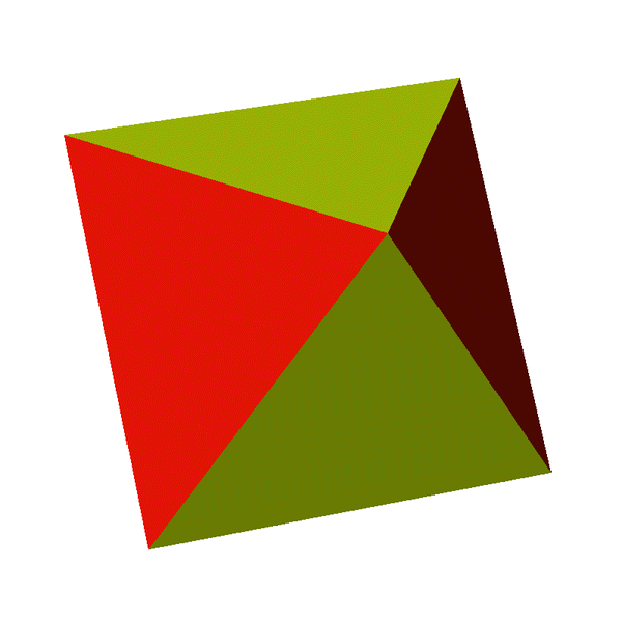 Folded
Up Folded
Up
It looks like a
pyramid on its side. It is really a double pyramid. Being solid, it
may be difficult seeing inside it, but it can be done. Drawing the
edges makes the drawing below. This topic is related to projections
and the geometric makeup of a virus. A virus has the shape of an
icosahedron but before it gets to that it goes through several
"construction stages."
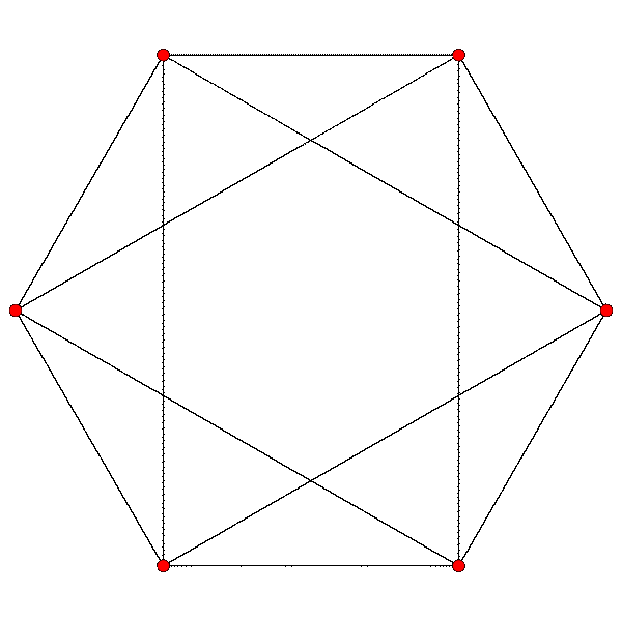
|
|
|
DSSP Topics for August
'11
Star classification --
Non-concentric Circles Star, the NC Star aka the Hyperstar aka the
Molecular Star |
|
Background
The last two
months dealt with the stars created from concentric circles, or CC
stars. These issue from orbits around a single sun. The
non-concentric star is in a different category. At this point it
would be difficult (for me) to completely describe the orbits in a
dual sun system but in the micro the situation is easier for the five
pointed star. This is all new.
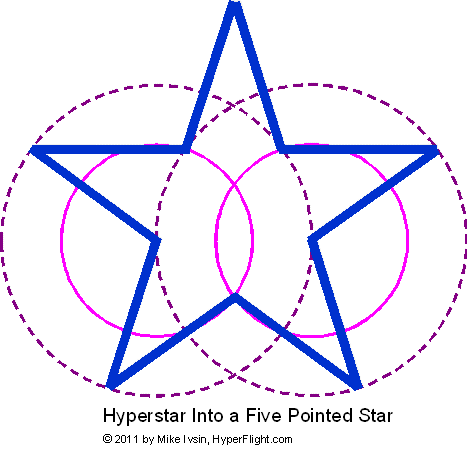 The
Hyperstar The
Hyperstar
is a five pointed
star that is created from non-concentric circles. Without the circles
it is a good ol' pentacle or a pentagon or a five pointed star. With
circles it becomes a pentacle that, however, does not have a
precedence on this planet -- mathematically or culturally. So you can
imagine why I like it very much. Details of its geometric
construction are here.
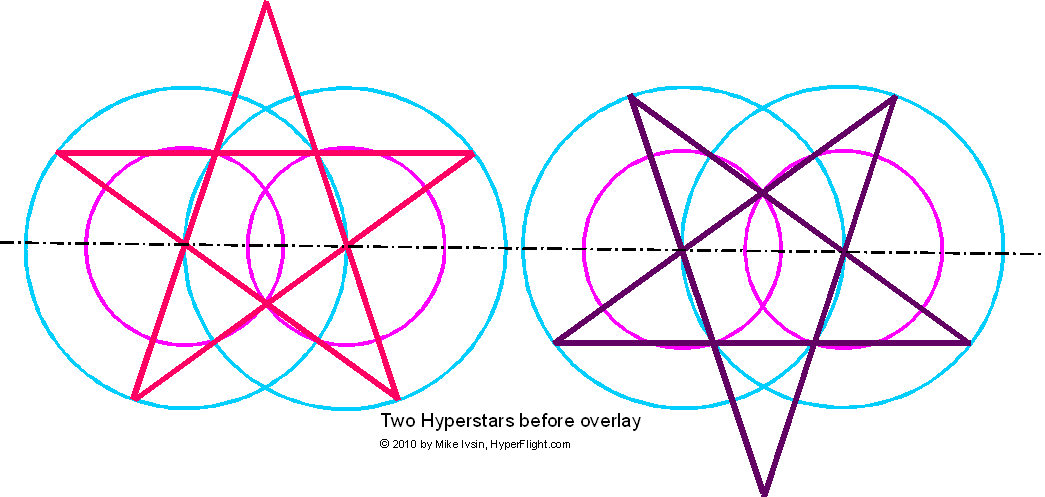 While
the basic hyperstar is five pointed, two of them can be put together
180 degrees out of phase by overlapping the circles. While
the basic hyperstar is five pointed, two of them can be put together
180 degrees out of phase by overlapping the circles. 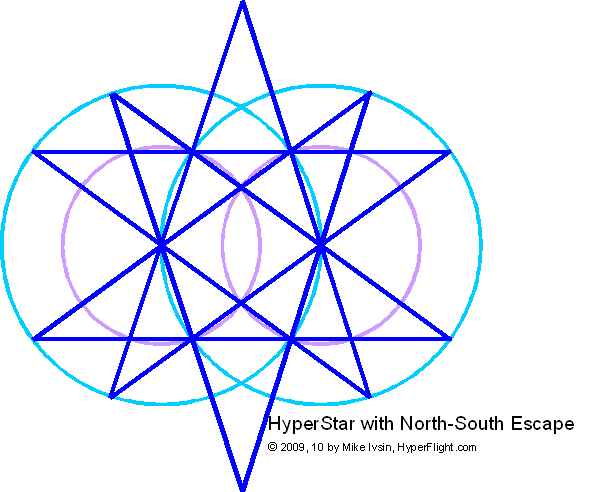 The
result is a ten pointed hyperstar. Technically, this star is not
regular. However, it is quite useful and that is one reason why I am
proposing the NC Star category here. The
result is a ten pointed hyperstar. Technically, this star is not
regular. However, it is quite useful and that is one reason why I am
proposing the NC Star category here.
Geometry Rules
Now, if the
orbitals are the circles, the hyperstar will divide each of the two
circles into exact tenths of a circle. In other words, although the
star is not regular as far as the distance(s) between points, it is
regular as far as the exact and even angles are concerned. Yet the
most important part here is that the hyperstar actually enables the
creation of molecules from atoms. This is because each of the
circle's center is a spot for an atomic core. Geometry allows the
growth of the atom into a molecule. The hyperstar has a particular
and non-arbitrary separation of the circles, namely SQRT(5)+1, which
is the numerator of the golden ratio. (The denominator is 2.)
At this time I
don't know if, for example, two eight pointed stars can be put
together to form a 16 pointed NC hyperstar.
The NC
Hyperstar, The Definition
The Non-concentric
Circle Hyperstar divides each of the two non-concentric circles into
equal and exact angular segments.
Other Stars
What's left from
the stars' categorization are the regular stars, the R Stars. These
are covered by Gauss and depend on the exact division of a circle.
These further divide (subdivide) into harmonious and disharmonious
stars. Such subcategorizing is addressed by the Quantum Pythagoreans book. |
|
 |
|
DSSP Topics for July
'11
Star classification -- The 2nd
and last installment for the Concentric Circles Star, the CC Star |
|
Background
Last month we
kicked off star classification. Fundamentally, we are in the macro
and derive the stars from planetary orbits. Two planets, when merged
into one, will create a trace of a star, a CC Star. And then it also
happens that a trace of a star would not skip one point and then two
points because such trace does not happen for planetary orbits -- but
it could be a fancy star anyway.
What's left
is the difference
in points of a star. One kind of a point is made when the trace moves
outbound and changes to inbound. The other kind of a point is the
reverse -- the trace changes from inbound to outbound. The
application tie-in comes from planetary conjunctions. When the two
planets are closest together (inferior conjunction) the
outbound-to-inbound point is made. This kind of a point is the most
visible on a star -- it is furthest away from the center (sun). But
when the two planets are the furthest apart (superior conjunction),
the in-to-out point is made. This point is closest to the center of
the star (closest to sun). So now, the furthest away points can be
called 'exterior' or 'outside' or 'extreme' points but I would not
adopt the 'inferior' terminology from astrology. Similarly, a point
closest to the center could well be called the 'inside' point.
Harmony again
It is also easy to
imagine the two planets disturbing the sun through their angular
momentum and introducing a wobble onto the sun. If you were a
physicist or an engineer you would see it as a problem because a
wobbling sun is a "problem." It is not a problem because we
want to create the orbits to begin with and we like planets to live
on (I say this because scientists are not very bright). Certain orbit
frequencies are harmonious and so you want to know how to get there
and make the orbits stable.
Picture?
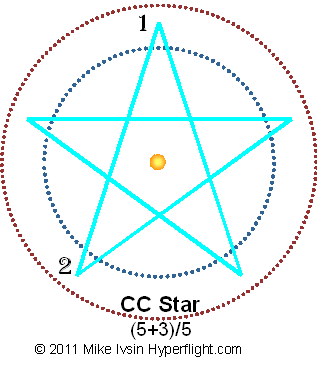 Here
is a pentacle. The two circles are concentric with the sun in the
center. Yes, they are the orbits of actual two planets. If drawn as
shown with the sequence 1-2-etc., the star is harmonious. In our
definition it is a CC star with five extreme points. CC (concentric
circles) star means it skips the same number of points during its
creation and, in this case the star's construction skips 2 points
going (always) clockwise. The numerical characterization (explained
in the book) is (5+3)/5 and this also tells you whether the
star is cw or ccw and if it is harmonious. Now, this picture is a
simplification of a real two-planet merged orbit because the points
are connected in straight lines (in order the points are made). So
how does a real and actual merged-planet orbit look like? Glad
you asked. But of course, different planets make different CC stars. Here
is a pentacle. The two circles are concentric with the sun in the
center. Yes, they are the orbits of actual two planets. If drawn as
shown with the sequence 1-2-etc., the star is harmonious. In our
definition it is a CC star with five extreme points. CC (concentric
circles) star means it skips the same number of points during its
creation and, in this case the star's construction skips 2 points
going (always) clockwise. The numerical characterization (explained
in the book) is (5+3)/5 and this also tells you whether the
star is cw or ccw and if it is harmonious. Now, this picture is a
simplification of a real two-planet merged orbit because the points
are connected in straight lines (in order the points are made). So
how does a real and actual merged-planet orbit look like? Glad
you asked. But of course, different planets make different CC stars. |
|
 |
|
DSSP Topics for June
'11
Star classification -- first
installment: CC Star (Concentric Circle Star) |
|
Background
The classification
of stars comes from math people who think they got every aspect of a
(geometric) star covered. They get carried away and ignore possible
applications such as music. They ignore nature altogether: The
Venus-Earth pentacle shape, having a curlicue, would not qualify as a
star Wikkily speaking. People on the mainstream scientist websites
compile trivia, references and circular references, one paragraph not
at times agreeing with the next. To top it off, math guys get
nonlinear if you suggest they should include examples of applications
with their fancy definitions. In summary, mainstream math guys do not
lead and get offensive if you suggest they ought to back it up with
an application. At best they try making a virtue out of a need.
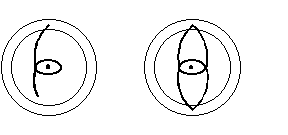 More
examples More
examples
Here is what
happens when Neptune and Pluto are gravitationally combined. The
trace shows how the Sun sees both planets as a single body. It is a
shape that resembles a (rotated) cat's eye having two distinctive
points ("corners"). You guessed it, mainstream science does
not have a two pointed star because they see "two pointed"
reduced into a circle's diameter and they do not give a damn about
possible real-world applications. They also happily ignore the 3:2
orbit ratio that produces this eye shape -- a very well known musical
ratio (and a harmonious one at that). It is then easier for the
scientists to either ignore the application connection or, if they
cannot find an explanation, try to remove the application by
declaring Pluto a non-planet.
It is perfectly
okay for scientists to give up on any part under their purview, just
as they did with ether. They can also claim photons are just like
little meatballs and play with them in their own sandbox, but I would
not pay them for such nonsense.
It is then time to
come up with our own definition of what a star is.
New Definition
of a Star:
1) Concentric Circles Star or CC Star
All stars need
circles for their creation. Applications-wise, circles are orbits and
so we are in the macro. Because there can be more than one orbit
there could be several circles. Initially, circles will be
concentric, as there is but one sun in the center. A CC star
is a star having its points appearing on one or more concentric
circles, although an orbit circle and the points circle are not
usually the same. A star's point happens when a shape changes radial
direction -- that is, when a shape changes from going outbound to
inbound. Going the other way -- from inbound to outbound -- also
makes a point but of different kind. In our Neptune-Pluto example,
all points lie on a straight line and there are four points: two for
outbound change and two for inbound change. At least two orbiting
planets are needed.
Unicursal Star
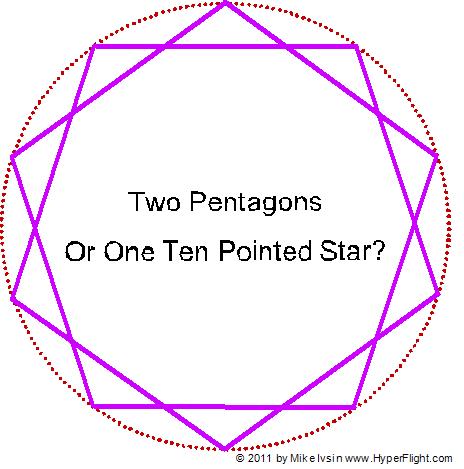 All
concentric stars are unicursal. This means the trace goes on without
stopping or jumping and eventually ends up at the starting point.
This is yet another outcome from the orbital application and the
planetary real world tie-in. A trace can take any-some-such path to
get from one point to the next. However, because the star is tied to
the real world application the path from one point to the next will
always have the same distance. Another way of saying it is that if a
star's trace skips a point then it continues skipping but one point
going around the circle (and cannot suddenly skip two points). In yet
another way of saying it, the star is regular during its creation,
which means that going from one point to the next will take the same
angle. The star can then be simplified by connecting the points in
the sequence they are reached but much information can be lost. For
example, if we were to connect the above Neptune-Pluto points, they
would end up on a straight line. All
concentric stars are unicursal. This means the trace goes on without
stopping or jumping and eventually ends up at the starting point.
This is yet another outcome from the orbital application and the
planetary real world tie-in. A trace can take any-some-such path to
get from one point to the next. However, because the star is tied to
the real world application the path from one point to the next will
always have the same distance. Another way of saying it is that if a
star's trace skips a point then it continues skipping but one point
going around the circle (and cannot suddenly skip two points). In yet
another way of saying it, the star is regular during its creation,
which means that going from one point to the next will take the same
angle. The star can then be simplified by connecting the points in
the sequence they are reached but much information can be lost. For
example, if we were to connect the above Neptune-Pluto points, they
would end up on a straight line.
In the
illustration on the left, there are two CC stars, both pentagons.
Each star comes from nature but overlaying two of them cannot make
one ten pointed CC star. Yet, there are ten
pointed CC stars.
Harmony
is about two or
more frequencies being played together. Taking the orbit frequencies
from our solar system the tones will be harmonious. In general,
however, some combined frequencies could be disharmonious and some --
even if they are not present in our solar system -- could be
harmonious. The full explanation of harmony's conditions is in the book.
Last edit July 7, 2011 |
|
|
 |
|
DSSP Topics for May
'11
Yes, the 24 pointed and 16
pointed stars can be made via a single geometric construction |
|
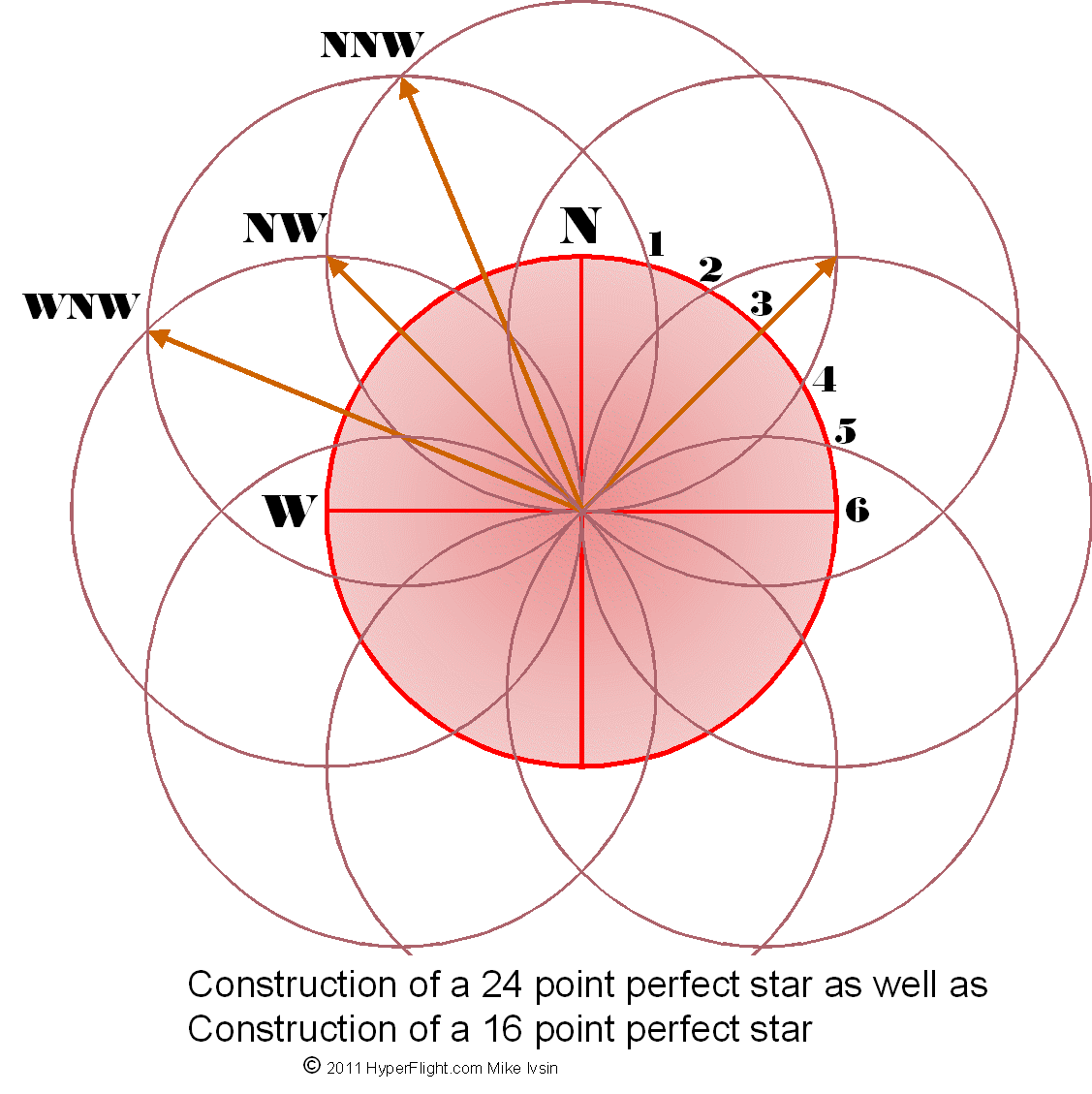 Background Background
The 12 and 24
point stars are mostly reserved for time keeping. The 16 point stars
are about navigation and the 16 point nautical or magnetic stars or
rosettes bring you the fine resolution of North by Northwest, for
example. The 24 point star starts as a 3 pointed star and by
continuous doubling eventually reaches 24 points. The 16 point star
starts at 2 points (a diameter) and by doubling gets to 16. In both
cases we can continue on and on but the points ratio will always be
in 3:2, which is the musical "fifth." How they got to
calling it a "fifth" you have to research on your own, for
I get flustered by the music people's strange complications. The
ratio of 3:2 is just fine by me and very descriptive, too, because
frequencies of 300 and 200 Hz being played together are just in the
3:2 ratio and I don't know why anybody has to complicate things by
calling it a "fifth." The musical "fifth" has
nothing to do with 3+2 and the last time I checked it had nothing to
do with a fifth of a gallon, as in BYOB. It is also easy to make a
connection between a three-point star and three wavelengths wrapping
about the center and, consequently, the points of a star are directly
related to frequency. We have now ventured into applications but in a
strict sense we are talking about the exact geometric constructions
as related to the exact division of a circle.
The construction
starts with the
cardinal X-Y coordinates and uses circles of but one radius. The
construction is so simple I was fairly certain I would find it on the
Internet. After a short search I did not even find a 12-and-8-point
common construction, which is simpler and precedes the
24-and-16-point common construction. The central circle marks the 24
points star intercepts as well as the points for the compass
centering of other circles of the same radius.
Here is our own
construction for both the 12-and-8-point
star.
Frequencies, again
Standing at the
center and rotating about it, at each revolution you will encounter
24 points following one star and 16 points following the other.
Oh,
This construction
procedure can be used in ever-increasing star point count. Circle
radii stay the same and the circles grow denser around the central
circle but they do not expand outward. The next point of the compass
for the 48 and 32 point combo star would be at the NNW and WNW
intercepts with the center circle -- and repeated for the
corresponding intercepts at the other three quadrants. |
|
|
 |
|
DSSP Topics for April
'11
Energy classification in
dimensions, continuing with dynamics |
|
Background
Last two months we
delved into energy classification based on dimensions. So far each
the 0D, 1D, 2D, and 3D energies have their own "niche" that
is easier to understand than saying chemical energy, for example.
Is there the
most important dimension?
Yes, there is.
When it comes to all kinds of energies doing their thing in various
dimensions, the most significant is the dimension zero. This is not
difficult to see because spin and rotation and orbits are about the
point symmetry. We also need a point in a very esoteric aspect of
transforming energies, for the real and the virtual domains can
interact only through a 0D point. The thing is that the dimension
zero is very much ignored outside of geometry and so the scientists
have their gaming universe to themselves. In other words, you have to
appreciate that scientists know very little. The degree of
specialization is not moving us forward, really, because everybody is
right in a narrower and narrower field.
Moving among dimensions
This is not about
faster-than-light travel but it is close. Energies can move from one
dimension to another and then, for example, transforming rotational
energy to linear energy results in straight-and-forward 1D motion we
love so much. But now the thing moving in 1D could have its energy
detached and applied onto something else. Yes, but so far we can
understand this only through collisions. Something transfers energy
onto something else and makes it spin. So now, can this energy
transfer be done without a collision? Yes, it can. And that is the
best part of energy. An accelerating body is accepting energy. Once
we figure out the energy attachment mechanism, we can then figure out
the detachment mechanism -- and stop moving bodies at a distance --
but then attach energy to something else again, without a collision
of course. |
|
|
 |
|
DSSP Topics for March
'11
Energy classification in
dimensions, continued |
|
Background
Last month we
proposed the classification of energy based on dimensions. So, as
there are 0D to 3D degrees of freedom, we will use this schema to
talk about the energy. We also said the scientists are clueless when
it comes to classifying intelligence and this month we will see where
the smart energies are.
The Chinese,
interestingly
enough, define several intelligent energies. I will stick to calling
2D based energies the 'free energy,' in line with the general pursuit
of harnessing these space borne energies. The existence of 'free
energy' is presently being denied by the mainstream and taxpayer-paid
scientists, but, you know, it's a matter of you figuring it out
rather than waiting for a handout.
2D and
3D energies.
2D energies are
not exactly free, for the energy is diverted from the Earth's orbital
momentum or by deconstructing matter, for example. 3D energies have
nowhere near the physical oomph of 2D energies but what they do have
is their infinite uniqueness. 3D energies are sculpted in 3D and,
being a wavefunction (a virtual energy), 3D energies are difficult to
read. The energy has to reduce and an appropriate 3D physical
construct must exist to intercept it. When you study you memorize
certain things and such things have a geometric representation in
your brain. Such representation, then, is capable of intercepting
space borne intelligence. A motion of your physical body has a
similar memory component and, well, you have get into Tai Chi to move
from just talking about it to actually feeling it. 3D also deals with
energy storage that has a 0D component.
Healing energies
are also in 3D. Our structure is in the aura and there are
intelligences the likes of angels that can deal with fixing your
body. Everything you do is stored and some say everyone has a plan
that's stored in there as well. Technically, things can be denied but
that could make it worse. After all, you would not want your
knowledge to disappear if you were to lose your diploma.
1D energy
is your everyday
photon. On this planet the linear kinetic motion of automobiles and
rifle projectiles dominate but 1D energy is pretty rudimentary and in
the long run not very effective. |
|
|
 |
|
DSSP Topics for February
'11
Energy classification |
|
Background
Energy is
presently classified along the easy-to-visualize lines -- such as,
kinetic, potential, thermal, chemical, photonic, etc. Not bad.
Actually, the visualization aspect is important. Yet, if we don't
understand what energy is and where it could come from and how it
looks like, we are limited to descriptions such as healing energy or
harmonious energy, which is not very revealing. For some people it is
apparent that knowledge, intelligence, and information are also forms
of energies. The scientist, however, is clueless when it comes to
explaining intelligence or information, and there is then a need to
delve into energies along different classification lines.
The Chinese
differentiate
energies associated with a human body into about four categories.
Chinese health and Martial arts literature is available and abundant
in the explanations, but now I don't want to expound the Chinese
reasoning when differentiating chi and ch'i, for example. I don't
need to, actually.
Pythagorean
baseline to
energies is very forthcoming. It issues from geometry and, in
particular, from the 0, 1, 2, and 3 dimensions of independence. An
atomic electron is in an orbital and carries 2D and 3D energies but
not 1D energy. A free electron, when moving, carries 1D energy while
its spin is 0D energy. Light is 1D energy, and so on. The dimensions
of independence give us an excellent framework, which is particularly
revealing during energy transformations. For example, a photon of
light issuing from an atom receives 2D energy from an electron's
orbital but the resulting photon is in 1D. The squaring of a circle
comes in and our hyperstar is very useful in this regard. (Hyperstar
is treated on this page in the Jan 2011, Dec 2010, and Feb 2010 DSSP topics.) |
|
 |
|
DSSP Topics for January
'11
Hyperstar art |
|
Background
The hyperstar is
our particular creation of a pentagon and consequently a pentacle and
a five point star. It comes about from a direct construction
of the golden proportion. The end result is the hyperstar, which
can be rendered with five or ten points. You will note the hyperstar
is not made from just one circle.
Picture filename: hyperstar_5-point.gif
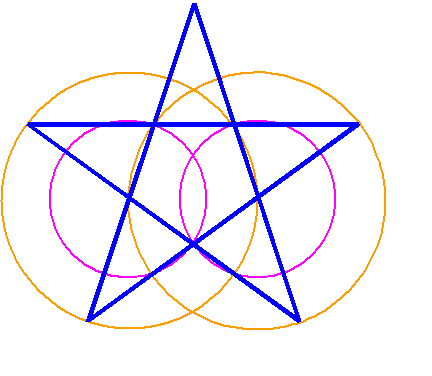
Last month (below)
we highlighted one unusual property of a ten pointed hyperstar: Some
points lie on a straight line and do not curve as we would expect on
a conventional star. Yet, the hyperstar contains a large number of
design elements in addition to the star itself. Lunes (moons),
circles, and rings and triangles -- all relating in particular
proportions and angles. The triangles are golden, too.
So
By putting and
keeping the elements in their original proportions you and I can
create art that is specific to -- yes -- atomic and cosmic
constructions. Here is but one example but you can see many selected
designs here. Enjoy. |
|
Picture filename: pentagon-moon.gif
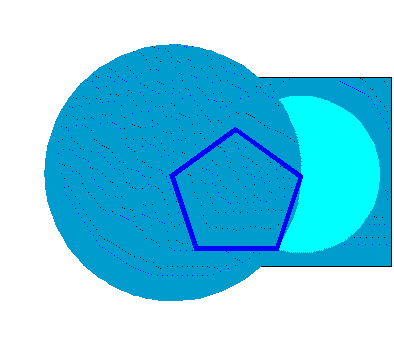 |
|
|
 |
|
DSSP Topics for December
'10
When the star is neither concave
or convex, what kind of star is it?
A: The Hyperstar |
|
Background
All polygons are
convex. The trace moves from one point to another and the direction
(curvature) does not reverse. It is the same thing when riding a race
car on an oval -- you steer in one direction only. On a concave track
you reverse the direction from right to left and vice versa etc. So,
an octagon below is convex and so is the octagram if you trace as indicated.
Picture filename: convex_octagon.gif
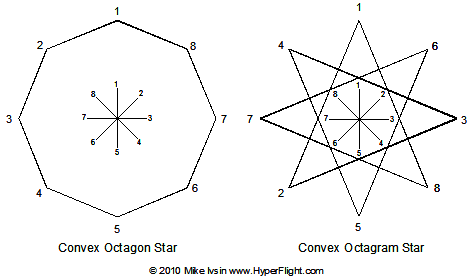
But
an octacle can be
both concave and convex if we count the inside bends as points -- or
if the minor points cause a concave trace:
Picture filename: convex_and_concave_octacle.gif
Picture filename: convex_and_concave_octagon.gif
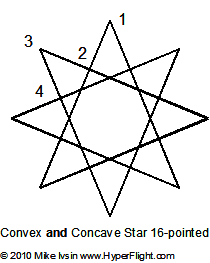 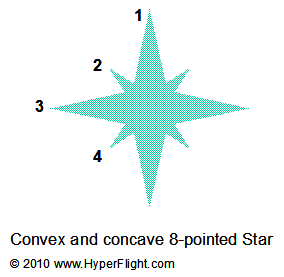
That is how
things stand.
The scientists
classify all possible stars and everything is covered. Well, not our Hyperstar:
Picture filename: hyperstar_not_convex_not_concave.gif
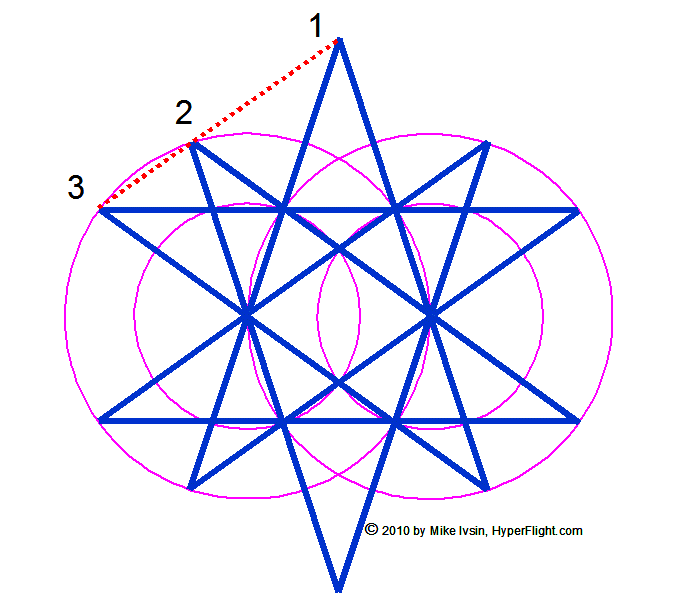 |
|
The Hyperstar
When moving from
point 1 to 2 to 3 there is no bending. The hyperstar is neither
convex or concave. Classifying this star could be a real pain. But,
at the end of it, it is a star that has nothing to do with counting
points. So there.
Oh, the lines 1-2,
2-3, and 1-3 each form a side of two golden triangles.
Happy New Year. |
|
|
 |
|
DSSP Topics for November
'10
When you direct a laser at
something and observe a motion, you
a) Write a new theory about it
b) You know some light got absorbed
c) Never get a motion in a vacuum
without consumables |
|
Background
Lasers are nice to
work and play with. So we point them at just about anything. They
heat up a surface so much they cut right on through. And because most
of the people think photons carry momentum, they also think the laser
beams can push things.
But they don't.
A laser beam
cannot push anything by reflecting from it. This fact does not
subscribe to equations the scientists have, but never mind that.
They, the scientists, love equations and if you ask one to build a
laser beam perpetual motion machine by bouncing a light beam back and
forth between two parallel mirrors, they really cannot do it -- but
they love their equations so much they don't care the equations don't
describe reality. They point their lasers at liquid bubbles or shoot
a laser through a bent fiber optic cable. Bubbles extend, fiber bends
some more or less. That would be okay, for people like to invent a
new instrument that can pick a small object with a laser, say. The
bottom line is that the light from a laser must reduce into heat if
some movement is to be observed.
So now
the scientist
makes different conclusions about light. They bring in theories that
support or contradict this or that scientist. They toss in Nobel
prizes to improve the scientist's credibility, but light is not a
stream of little bouncing balls and so they go back and forth arguing
the same premise of how many angels can fit on a head of a pin.
Everybody makes a point but all of it is irrelevant because -- from
Compton on through Einstein -- they cannot go past the little
billiard balls when it comes to the photons of light.
How can you tell
where the truth
is? On reflection, from a mirror say, a photon remains a photon --
that is, energy. There is no momentum transferred to a mirror when
light bounces from it. When a photon reduces into heat or electrical
energy then the photon is no longer a photon and is gone: one
form of energy transferred to another. In the vacuum of space it is
impossible to create motion from a laser because the absorption
opportunities just aren't there. I suppose you can evaporate some
material and make it move but when the material is gone so is the
motion. You can move in the vacuum of space through other means but
gravitational forces are not photonic. To move in the vacuum you will
need to understand gravitation and this becomes a different topic altogether.
What's wrong?
There is nothing
wrong writing about a so-called science even if it has no merit and
no return on investment. But if NASA thinks they are doing
breakthrough science they are just showcasing their stupidity. It
would also help if the Nobel committee were to toss out Compton and
Einstein, and admit both the committee and the scientists botched it
up. I've no problems leaving the scientists behind, along with their
baggage. Yes, there are links
to all the right angles on light. |
|
|
 |
|
DSSP Topics for October
'10
Modulo math is about rotation and
recycling. Is there more? |
|
Background
For two thousand
years modulo math was in the esoteric category. Pythagoras first
brought up the decad -- or modulo-10 -- when HE spoke of the decad in
that after the decad of ten one returns to one to start another
decad. This was picked up by the Greeks and Hebrews who assigned
numbers to letters up to nine, the next letter restarting with zero.
Gauss picked up the modulo math formally and showed how to predict
divisibility of very large numbers with simple digit summation. Not
long ago in the 1980s modulo math was applied in the public key cryptography.
In essence, our
clock is modulo-12 because after the 12 the hand restarts at one. And
so we can pick any whole number N and apply the modulo-N math.
Can modulo math
be advanced?
But of course you
knew this is a rhetorical question. In the present modulo-N setup the
reference stays put. The 12 o'clock position stays on top. Yet if you
forget about the 12 o'clock position and include the small hand of
the clock as a modulo reference, which is now allowed to move, we
will have a modulo in the 12-to-1 ratio. For every 12
rotations of the large hand the small hand makes one rotation.
There could be
other ratios.
In the 8-to-5
ratio the faster hand would make 8 revolutions for every 5 of the
slower hand. Isn't it nice the Venus-Earth revolve around the sun in
this ratio? And Earth-Mars in the 15-to-8 ratio? In the book Quantum
Pythagoreans the notion of orbit rationing is applied in the
explanation of harmony and disharmony. To top it off, orbit ratios
open up a new chapter on modulo math, which as yet does not deal with
a modulo of two numbers such as the modulo-8/5. |
|
|
 |
|
DSSP Topics for September
'10
Bring on the waves
Adding an axiom or two to Euclid
can help with free energy |
|
Background
Axioms are axioms
because they need not be questioned. They are common sense obvious
kinds of things that need no proof, say. If we take the Euclid's
axiom saying that through two points one can draw but one line, it
does not make much sense to argue for or against it: It is just right
just the way it is. Or is it?
This guy Euclid
was not really up
on irrational and transcendental numbers. He proves that irrationals
such as the square root of two cannot be obtained by rationing and
leaves it at that. Euclid has no clue on what the irrationals or
transcendentals can do for you and he just leaves them on the side-lines.
A solid line
from this point to
that point is about the magnitude. It has some length we can measure
exactly. So we cut a two-by-four to some exact length and feel good
about it. But if the distance between two points is irrational there
is no way we can cut a stick or a piece of something to be exactly
the same distance because we do not know where to make the cut. An
irrational distance has an infinite number of nonrepeating sub-unity
digits (called mantissa) and even the expert measurer cannot decide
where to make the cut because the decimal digits go on and on and on.
Yes, I know you will say the third decimal place will not make a diff
in the height of a door, but the idea is that in nature no real thing
can exist where the irrationals live.
The pesky irrationals
Okay, so we give
up on the irrational distances because no real thing will fit in
there and ignore them the same way Euclid did. Hey, we can even
ignore those math guys who say there are more irrational numbers than
rational numbers. They are theoreticians, you know. But what can
actually fit in the irrational distance? Better yet, is there
something that's happy about irrational distances?
Waves
The waves can fit
the rational or irrational distance. Waves can span the irrational
distance just fine and do so exactly. But you have to give them space
because, as you know by now, a rational piece of something fills in
the rational length and, by excluding the irrational distance,
excludes the waves as well. And so the waves need an empty space to
form and to exist across any distance.
The transcendentals
are in the same
boat except they do it in the geometry of a circle. A circle cannot
be squared as a whole and so one cannot make a perfect circle from
wood, say, because a real thing is made from real numbers and no
circumference of any circle can be a finite number. So, similarly, it
is up to the waves to make a perfect circle of 2Pi.
It just might be
good time to add to Euclid's axioms and fold in the waves. They are
important because they are everywhere and we want to work with them.
But of course, waves are about energy. |
|
|
 |
|
DSSP Topics for August
'10
You know the argument about the
nonexistence of God: If God were all-powerful He or She could build a wall
.. .. |
|
Background
If God were
all-powerful He or She could build a wall such that nobody, God
included, could get over it. If He could not get over the wall then
God would not be all-powerful. If He could then God would not be
all-powerful because He did not build the wall that would stop everybody.
Some people
stand back with a
smile waiting for your reaction. Some think a man's brain can put an
end to God. And then you say, 'Can you make the biggest dwarf? You
can make him out of concrete and put it in your garden, you know, but
it has to be the biggest.'
Specifying
something also
calls for excluding something else -- for otherwise the spec would
not be a spec. By specifying going straight we exclude going in
circles. By requiring getting wet we exclude being dry. By requiring
building a wall we deny passage. You can ask God to resolve a
conflict but you can show but your poor thinking if you want two
contradicting things to happen. Things happen for a purpose and a
wall can be created -- but for another purpose the wall can be
uncreated. There are many, many purposes -- one better than the other.
When you enter the
infinity you will see God. |
|
|
 |
|
DSSP Topics for July
'10
How is force linked to inertia
and mass? |
|
Background
Newton defined inertia
as force (vis inertiae in Latin) that resists a change in direction
and/or speed some mass body may have. A body may be at rest or moving
linearly or spinning or orbiting but to affect any change to the path
or speed, the inertia is and must be engaged. Newton, then, defines a
dynamic property of mass and calls it inertia. The good thing is that
inertia works for any body and is the same everywhere in the
universe. Inertia appears linearly proportional to mass: a
body with twice the mass has twice as much inertia. This linear
proportionality is confirmed in a laboratory or in your backyard.
Same other background
An electron has
mass. When accelerating electrons to a higher and higher speed, we
would expect the electron's inertia linearity to hold and we could
technically achieve any speed we want. Such is not the case, however.
Adding more and more energy to an electron speeds it up a bit but the
speed does not exceed the speed of light. Energy conservation
continues to hold -- that is, even though the electron's speed finds
a limit at lightspeed, any amount of energy imparted onto an electron
can be recovered in full.
So now
you have to decide
on the mechanism that is taking place here. Some took an easy way out
and declared that the mass of the electron is somehow increasing and
that is why we are up against a higher and higher resistance and thus
a higher and higher inertia. But then the conclusion is that a mass
of an electron would then have to increase to infinity as the
lightspeed is reached. Yet, letting an electron to acquire mass just
like that is somewhere between pseudoscience and stupid science
because it does not deal with the mechanism of inertia, which is
about the mechanism of the conservation of energy.
Inertia is
about the conservation of energy
When a mass body
speeds up the energy put into it can be recovered in full, sooner or
later, gradually or suddenly. You can speed up a body but to do so
you will need to push it some distance and with distance you get a
direction. It is this direction that is also being conserved, for if
you speed up a real thing going North, say, the body will continue to
go North. Now, the only entity that has speed and direction is a wave
because a wave is nonlocal and must have spatial distance. Inertia
must be a wave-based mechanism and the conservation of energy is also
wave based.
How it works
Speeding up a real
object imparts frequencies to the atoms comprising the object. Higher
frequencies have higher energies and that is how the work that is put
in to speed things up is stored. Yes, the energy speeding up
an object is stored with the object. Big deal? You bet. By
affecting the frequencies at a distance you can speed up or slow down
an object at a distance.
Mainstream science
is in the stupids
category for about 100 years now. Einstein is okay for keeping the
reductionists in their black hole. Sooner than later, though,
Einstein and the reductionists will have to go. Lack of truth gives
rise to many opportunities and I see the success of Tai Chi in Europe
and Canada as a rejection of the status quo. Tai Chi is in the area
of health and self-improvement but it has a geometric foundation. In
physics, the idea is that you can work this month's topic without the
so called scientists and make some real progress, too. The wave
mechanics dealing with the conservation of energy is limited by
lightspeed but the frequencies are unbounded. Perhaps you see now why
the speed of a real object cannot exceed the speed of light but can
accumulate higher and higher energy because the frequencies are
unbounded. At lightspeed the frequency and thus the energy goes to
infinity (but the mass stays the same). |
|
 |
|
DSSP Topics for June
'10
When two waves add
up to zero, where does the energy go? |
|
Background
It is easy to
visualize two ocean waves adding up to a bigger wave. One half of the
new wave gets higher and the other half gets lower, but the overall
feel we get is of a wave that has twice as much energy. After all, a
boat on top of such wave would be lifted up twice as high. But if the
two waves do not come together at the same time (coherently, in
phase) but instead meet each other one half the wavelength later
(180º out-of-phase), the waves add up to zero and there is no
visible wave action. The energy of a wave seems to have disappeared.
|
|
Picture filename: wave-phase-addition-gif |
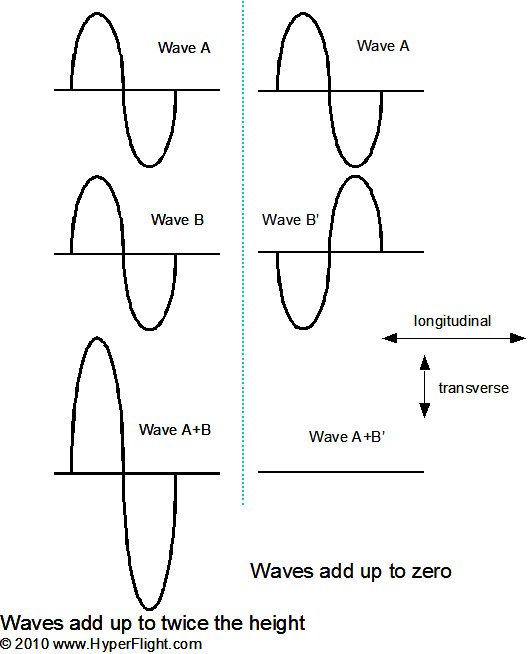 Energy
and Geometry Energy
and Geometry
Yet, we also know
that the keys are with energy and geometry. When the boat goes up it
receives energy and when the boat goes down it gives up
energy. The net (or average) energy is zero. Yes, the net energy is
zero even if the height of the wave doubles. In practical terms the
up and down motion does not take away or give this wave energy. What
this also means that the ocean waves do not push a boat along --
that's up to the wind, for example. If such is the case, where is the
energy of a wave?
Geometric split
The height of a
wave can be visualized as an even polarizing split happening
in the second dimension. Exactly one half becomes positive, the other
half negative -- but such is only the case for the up and down
direction called the transverse direction.
More
Can you visualize
the creation of a wave as creating something out of nothing? After
all, the net energy is zero before and after the creation of a wave.
(Careful, think transverse vs. longitudinal. Transverse is at a right
angle to the longitudinal.)
More
You supply energy
when you create a wave. Such energy can be real or it can be virtual.
In either case the energy must be imparted in some direction that
ends up being the direction of the wave propagation and that is the
longitudinal. Technically, force must happen over (some direction) of
a distance to speak of energy. When you plink a stone on water you
use real energy. Self-test:-) If you agree that ocean waves are real
waves, continue. But photons are made with the virtual energy -- all
photons are wavefunctions based on the SQRT(-1). Wavefunctions, being
virtual, cannot push a real object such as a boat but they do
interact logically with the environment they encounter. Wavefunctions
also cannot push a mirror ("boat," load) longitudinally
although they could reflect from it, and this is the manifestation of
the difference between the real and virtual energies.
So now you know
that the energy is
along the longitudinal. Even if two waves add up to zero they do so
transversely and the energy remains in the longitudinal.
There is more
to this and we
have a bunch of photons
of light topics on this site. Say, can we keep adding photonic
energy in a very small space and do so without limit? |
|
 |
|
DSSP Topics for May
'10
Is matter smart? |
|
Background
The atom could be
smart considering its ability to stay together under some pretty
extreme conditions. The atom will stay essentially complete even
though it loses some electrons from its orbitals and becomes ionized
-- only to revert to its original state when the electrons become
available again. Some atoms can withstand high temperatures without
breaking up -- and we can only compute the millions of degrees it
would take to break it up -- and ooh and aah about it.
Concepts
The atom relies on
radial symmetry -- the core being at the center -- and the radial
symmetry is a concept worth exploring. In the micro we also find
radial symmetry in the free electron, which has a propensity to
spread -- yes, in the radial fashion. The radial symmetry also exists
in the macro in a way our solar system is organized. Now, the concept
of the radial symmetry could become embodied as a form of
intelligence that is "out there." So far it seems simple
but consider that the orbits and orbitals need to resolve the
squaring of a circle problem to reconcile the linear (photon) and the
rounded (electron) energies for an atom or a molecule to remain
unbroken. Perhaps now you might agree that, just maybe, the atom
might be smarter than most of us.
So what
if one could
actually talk to or interact with such intelligence? It would not be
a person all right but I think an interaction could be had. For
example, if you had an idea of a new power source, you could
conceivably get a feedback on whether this new source is agreeable to
the "Principle" of the radial symmetry that subscribes to
the atom's stability, for example. In the esoteric department such
principle could actually manifest and act in support or against the
new power source.
Can this get weird?
Yes. As tempting
as it is, take it easy and get well grounded before making
conclusions. It's nonlocal out there. Oh, it could have something to
do with the Philosopher's Stone. |
|
 |
|
DSSP Topics for April
'10 |
|
What happens when
God sends an eye ..
1) You've
got to be kidding
2) He/She
has but one left
3) It's a
figure of speech
4) It's
the magic of geometry |
|
Background
We keep an eye on
things or someone keeps an eye on a kid. Yeah, there is the evil eye
that's supposed to give you the jinx and the jibbies. A private eye
keeps an eye on others, but that is not what God would do. If He of
She would have to pay someone for snooping then He would not be God.
But there are stories of ancient Egyptian gods 'sending an eye.' The
idea behind such operation is to find someone and cause something to happen.
Thoth did it
He sent an eye
after Tefnut when she ran away to Nubia. The story has Thoth and
Tefnut's partner Shu doing magical things to find Tefnut. Thoth sends
out an eye, in effect a zero-dimensional construct of a focus, to
find Tefnut. Such focus is not optical but logical. Technically, it
could find Tefnut wherever she is. 'The Eye' is a geometric construct
of a point and you will find it on the AUM symbol, too. It is "a
link" to the intelligence of the universe which is, nontheless,
subject to the (subjective) objective of the person doing the
extraction and using it locally. So much for the technical side of things.
The story has a
happy ending in that Tefnut and Shu are reunited and after
purification and reconciliation they both return to Egypt. They get
married, too. This sounds like a really good bedtime story for kids
or for farmers relaxing after a long day in the fields. Except that
the story continues and says that a human race could arise after
that. Okay, so this must be one of the creation myths then -- yes,
the world is full of them. Except that this story is from the funeral
texts and at that time reserved for but the Pharaohs.
Re did it
He sent an eye
after all of the humanity. It was not supposed to be in anger but it
had almost the same effect. Quite an adjustment considering it worked
as planned. Two Goddesses received the message through Re's eye and
went on a rampage. Humans' faculties got reduced considerably and new
agencies were inserted between the divine and us. Supposedly we lost
the direct link to the divine.
Okay,
If you think this
is too much of bad news, chalk it up to April 1. If you know a bit
about the ancient Egyptians, you know about Hawthor and Sekhmet and
Re and Thoth. We can still reach the divine but it will take some
learning work. You've got the Internet, this site, and you just might
be in position to figure it all out. Actually, I have a theory about
Re adjustment: Humans are, really, pretty smart -- and it has to do
with Corpus Callosum. |
|
 |
|
DSSP Topics for March
'10
The virtual domain
is imaginary and ..
1) We can
enter it with imaginary numbers
2) It is
about the infinities
3) It can
get very confusing
4) It can be
very creative |
|
Background
In the recorded
and unrecorded beginning the irrational numbers sprung to our
consciousness through the geometric root. Pythagoras and HIS school
were the source. Soon, however, the infinite part of an irrational
number started giving other people problems. So much so the stories
were written saying the irrational numbers were an embarrassment to
the Pythagoreans and that's why they swept it under a rug. This is
not so, simply because if you discover something new and if you are
in discovery business to begin with, you keep it close to your chest:
The treasure chest of the Pythagorean School. Let the outsiders think
what they may.
Yet,
the irrational
numbers are not the virtual numbers. This took another thousand years
until the workings of the cube root, which led to the square root of
a negative number. Presently, the square root of minus one begun to
find some applications and it evolved into a new word: wavefunction.
Mathematically, the root of -1 is called i, the
imaginary unit number. But we prefer the word 'virtual.' Saying
'imaginary' is not bad, it just does not have the application
associations we think it deserves.
The strange get-together
of irrationals and
virtuals happens with a photon. The photonic wavefunction moves but
because it can be at any spot (at any 0D point), a photon can span an
irrational distance and be or move infinitely smoothly at any
possible spot. Now, the scientist continues to have a problem with
that because he uses algebra to arrive at specific answers and when
it comes to a photon they cannot get the exact answer. Have you ever
heard that a photon carries virtual energy until it is absorbed? On
this site you did, but the scientist sweeps the virtual photon under
a rug.
The virtual domain
is about waves.
These waves are not real but that's okay because in the virtual world
the waves superpose and the full infinity of them can do that. On top
of that, the superposition is instantaneous and so working with
infinities may not be that difficult, for it can be done in finite
time. As a Pythagorean you are not only into discovery -- you are
also into creation. But of course, it is creation that uses waves and
the numbers that stand behind them. You want to know how to entice
the virtual energies to curve and an electron can become virtual and
carry virtual energies as well. Once you know how to make them curve
you can make an atom. Imagine.
Oh, don't forget
the irrationals the likes of the root of five. |
|
 |
|
DSSP Topics for February
'10
So you think there
is something special about the pentacle. Pick the best one:
1) Pentacle
is but a pentagram in a circle
2) Pentacle
is witchy
3) Pentacle
is the source of the pentagram and there is more than one pentacle
4) Pentacle
is about the atom
5) Pentacle
and the human body have more than correspondences together
6)
All of the above |
|
Background
For a while there
was just one pentacle -- a five pointed star drawn with straight
lines called the pentagram surrounded by a circle that looks like
this 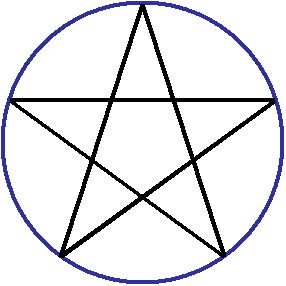 .
And the men painted a person (yes, a man) over
the star and wrote micro and macro cosmic stuff about it. A few
hundred years ago this guy Agrippa surrounded the pentagram with two
circles, others with three. Even king Solomon broke off a point on
his seal trying to butt in post mortem on the fame of the pentacle.
The occult guys took up swords in ceremonial fashion, stepped into
the double circle pentacle, and begun conjuring the spirits. As it
happens, the division of a circle into five is doable exactly
geometrically and everybody likes this so much the five pointed star
is truly worldwide. .
And the men painted a person (yes, a man) over
the star and wrote micro and macro cosmic stuff about it. A few
hundred years ago this guy Agrippa surrounded the pentagram with two
circles, others with three. Even king Solomon broke off a point on
his seal trying to butt in post mortem on the fame of the pentacle.
The occult guys took up swords in ceremonial fashion, stepped into
the double circle pentacle, and begun conjuring the spirits. As it
happens, the division of a circle into five is doable exactly
geometrically and everybody likes this so much the five pointed star
is truly worldwide.
But
this month we are
dealing with creation and staying in the micro. The atomic orbital
must have an integer quantity of waves if such waves are to close
about the nucleus -- and the number five will do nicely. There is
more to this and it is about stability. The atomic orbitals can
change incrementally and in the new closure of the orbital the
numbers are important. So, the ability to create a pentagram using
various orbits is important as well.
A new star is born 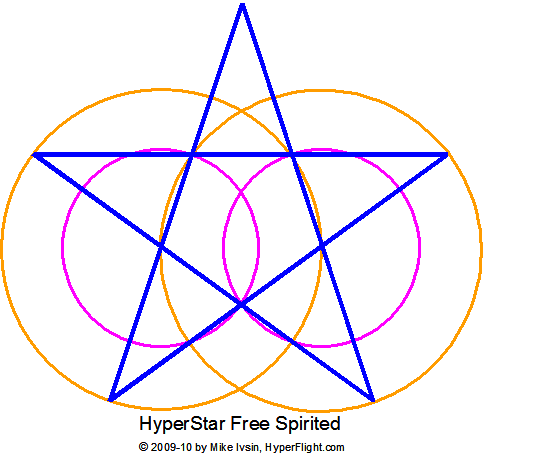 illustration
filename: hyperstar_free_spirit.gif illustration
filename: hyperstar_free_spirit.gif
More specifically,
a new root of creating a pentagram is born. It takes non-concentric
yet interlocking circles and a new pentacle is created from them.
Because the pentacle is free to rotate in space, a double-pentacle of
a ten-pointed star is possible with the result that all intercepts
making triangles, trapezoids, pentagons, and a center diamond are
golden -- that is, all their lengths are in the golden proportions.
This is very nice, especially if you think about orbital change and
the squaring of a circle -- the exchange between the electron curving
energies based on transcendentals and the straight photonic energies
based on irrationals.
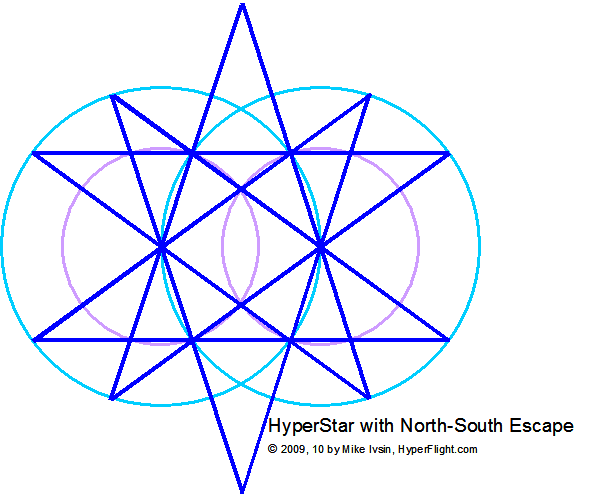 illustration filename: hyperstar_north-south_escape.gif
illustration filename: hyperstar_north-south_escape.gif
There
is more in the micro
It's gas
Two non-concentric
circles show the ability to create valence orbitals in a molecule,
for the two atoms are physically separated. Gas such as helium,
oxygen, and nitrogen are all pairs of atoms and the valence orbitals
hold the molecule together. But there is more to it if you can apply
it in the macro. I call the non-concentric circle pentacle the hyperstar:
The points of two hyperstar
pentagrams form a North-South axis that can explain a lot of stuff
such as spin, crystal formation, and the shape of the core. You can
fancy up the hyperstar, too. Oh, the radii of the hyperstar are in
the golden proportion and there are three of them.
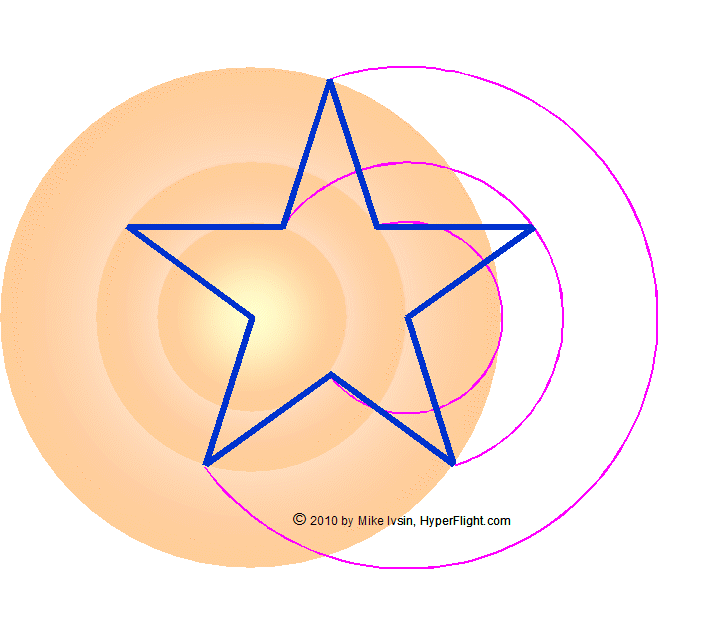 illustration
filename: hyperstar-pentacle-fancy.gif illustration
filename: hyperstar-pentacle-fancy.gif
There is more
in the macro {Mar
6, 2010}
The fancy
hyperstar on the left has many connotations. In Tai Chi, particular
movements are named after animals the likes of tigers, snakes/dragons
and storks but on this site we'll stick to the terms of the
Pythagorean School. When you think of the hyperstar illustration in
the Martial arts context, there is one mind-body movement that offers
a close fit. It has the fist of one (right) hand moving to the
(right) hip while the other hand is extending forward, palm
out. So now I'd call this movement drawing
three bows. The couplex (dantien) is not
shown but it is in the center of the intersecting cirles. (Movements
named after animals are nature inspired and are not indicative of
inferior understanding. In China, then and now, Martial arts needs to
be disguised for fear of reprisals. Tai Chi is great for health and
most schools do not emphasize the fighting dimension. A bureaucrat,
however, just does not take a chance in distinguishing one from the other.)
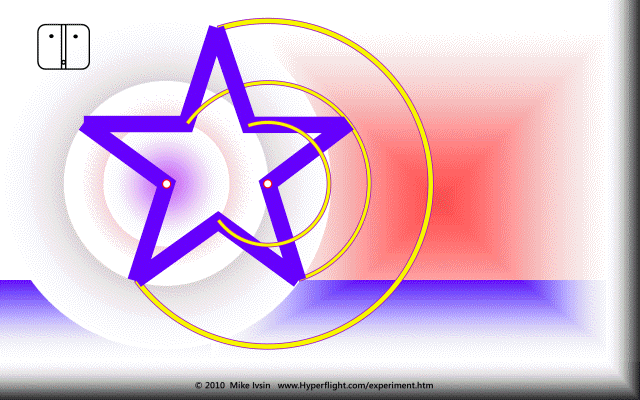 |
|
 |
|
DSSP Topics for January
'10
Frequencies
create, mostly |
|
Background
Frequencies tend
to engage a system and at times a resonance is found. The New Age
types like to say resonances are good but in physics the resonance
can damage or even destroy a system. Not everything and everybody is
powerless, however, because some frequencies will be absorbed and
then reradiated -- and so the energy does not build up to the point
of destruction (think photons). If a frequency is in 1D while the
structure is in 3D, the energy-carrying frequency does not
necessarily become resonant -- that is, absorbed, and the waves of
such frequencies go right on through. If the memories in your brain
are 3D structures, it just might not be easy to match that and mess
with it logically on a signal level.
So now
You are a creator
and want to make something. You will forgo the familiar kids stuff
Lego block construction because that just makes bigger things out of
smaller things. We now want to create the small things and so we get
into the micro to see what's available to us. We start with the
alchemy of the ancient Egyptian texts and move on to Pythagoras. From
the Sphinx we find out how to make electrons. From references to
Pythagoras (Aetius) such as: ".. and for him [Pythagoras] one of
the first principles tends toward the creative and form-giving
cause, which is intelligence, that is god, and the other tends toward
the passive and material cause, which is the visible universe."
The Form (the Style,
the Character)
is the logical
image of what the creator wants. The materialization (the
"passive") requires the new system to be systemic to be
stable and self-perpetuating -- that is, to be a monad, and right
away we know things have to happen in a circle. The logic of the
virtual energy has to close in a circle and here is where multiple
frequencies come in. With two or more frequencies we create a
harmonious interplay if we know what frequencies are harmonious
together -- and usually we want to know why. The frequencies used for
creation have no absolute value because we are dealing with ratios
(which is very Pythagorean). So we have linear 1D energies such as
light but have to make a circle out of them, and for real things we
need 3D constructs such as the pyramid geometry (angular momentum is
in 3D). To square a circle we must use infinities and superpose them
tractably. Tractability is via the superposition mechanism of waves
(wavefunctions) that is inherently without delay.
There isn't much
to it, is there? Happy New Year workings .. |
|
 |
|
DSSP Topics for December '09
Frequencies are loaded |
|
Background
Frequencies are
all around us. They can be carried by sound or by electromagnetic
radiation such as light or by electrons that move about the atom or
in free space. Many sound waves can be heard, many photons can be
seen. Electrons cannot be either heard or seen but can be felt or
detected by instruments. Frequencies are the inverse (the reciprocal)
of periods. So, planets in their periodic orbits also have frequencies.
So now
we compile various
frequencies and find some more important than others. We talk about
frequencies coming out of the pyramids or resonating inside their
chambers. We compile frequencies that kill viruses just as Rife did.
During the Renaissance we talked about the tones of the heavenly
spheres. There are the frequencies of the shaman's drum and there are
the tones of AUM. There are frequencies captured by geometric
structures. There are changes from linear to circular frequencies of
creation and permanence, and then we think of it as putting fire into
water -- and all that esoteric and alchemical stuff. Frequencies also
differentiate by their transverse or longitudinal oscillation. Most
recently (last month), we talked about frequencies that happen in up
to 3D and for that you need to appreciate that local, solid and real
things are not the only things that vibrate or orbit.
Creation and destruction
It is easier to
destroy something because there are many things around us we can
experiment with. Destroying cancer causing viruses is good, too, but,
ironically there are people bent on destruction that do not want you
to know about Rife frequencies. And so you got to find out for
yourself. When it comes to creation of real matter and in healing we
need to understand what makes harmony and disharmony and then you
need more than one frequency. Creating matter can be good but
creation also tells you something about destruction, although, as
always, precise and effortless cutting of the stone is a great
example of the dual use of any technology. Shiva is dancing.
In all, single and
particular -- that is, absolute, frequencies are about resonance and
potential destruction. Multiple frequencies are about creation as
well as destruction and we'll get into that next month. It turns out
the work of creation is not about particular frequencies. |
|
 |
|
DSSP Topics for November '09
An electron
spreads in more ways than one but what happens when it shrinks |
|
Background
We are at our last
part of the triple topic on electrons. In the last two months we said
the electron spreads and shrinks and does so over and over. There is
also a linkage to the Sphinx here but that
part is somewhat mysterious. It is not a mystery per se but the idea
of a Sphinx is that it speaks through the alchemical language, which,
though strange, is used for the most general understanding of the
electron behavior. So now the electron can become a cloud and, as we
like to say,
Where is the energy?
The electron
spreads without the energy input and you don't have to believe that.
When an electron is accelerated we indeed add energy to it and the
electron retains such moving energy -- that is, the electron acquires
momentum. But the electron also spreads and regardless whether or not
it is being accelerated. When a moving electron hits a target, it
gives up its energy as heat and it also shrinks.
So what
is the big deal
that the electron can behave as a particle? When an electron is
decelerated linearly it gives up linear energy. When an electron
acquires the shape of an orbital in an atomic (or molecular)
structure and when such electron acquires another orbital, the circular
(2D) energy exchange takes place. The linear energies carry rational
or irrational numbers while the circular energies carry
transcendental numbers. So that's the first difference. But,
What if
the electron can
carry 3D energies? This becomes very interesting and here is where
Tai Chi comes in as well. If you like the ancient Egyptian stuff,
think Shu and Tefnut and their respective symmetries. And then you
can fully answer the question of this topic. |
|
 |
|
DSSP Topics for October '09
An electron
spreads again and
A) Goes
through two slits simultaneously
B) Wait a
minute, an electron cannot part into two |
|
Background
Last month we
claimed that an electron spreads. It has to because the electron has
position uncertainty (Heisenberg) and it can then form an orbital as
well. In an orbital the electron has odd (point) symmetry. In a two
slit experiment we are working with a free electron and not an atomic
electron. Either way, an electron can spread.
Two slits (We
showcase the two slit experiment in Dec '08
DSSP topic.)
are closely spaced
and an electron is accelerated toward them. When the electron
encounters the two slits in its spread out state, it enters the slits
as one entity that can be visualized as a cloud enveloping the
partition between the slits. Left alone, the electron will form
self-superposition (some say self-interference). At this point the
scientist just scratches his head because the electron was never
shown to split into two -- and then they just ooh and ahh about it.
But
the electron does
not have to split into two as it enters the slits simply because it
remains spread out as a cloud and exists as one entity. Dumb
scientists the likes of Feynman call on intractable "point
electron travels in many and all possible ways" description to
explain self-superposition, but it is only because they hold on to
the electron-is-a-point-at-all-times proposition.
So,
don't bother with
Bohrs and Feynmans. Instead, imagine the electron spreading and
conforming to certain geometric structures. Symmetries have an
important part. Last month we suggested you sign up for Tai Chi. It's
a big hint. Maybe the electrons, being able to spread and shrink
again, can work with you in a way you want them to work with you. |
|
 |
|
DSSP Topics for September '09
An electron
spreads and
A) Goes
on spreading
B) Wait a
minute, an electron does not spread at all
C) An
electron also shrinks |
|
Background
And so you thought
you knew everything about an electron: It is small, it has a charge,
it has mass, it can be managed in a vacuum like a little ball. It
lives in an orbital of an atom and does not radiate energy despite
its charge. Then comes Planck, de Broglie and Schrodinger, and an
electron becomes a wave. Then comes Bohr and an electron is forbidden
to do this or that. In a nice piece of political science, Bohr's
electron is not allowed to become nonolocal. In a nice piece of
science ficton, an electron acquires an enigma of mixed up
complementarity. Fortunately, an atom goes on just as before not
caring if some dumb scientist forbids the electron to do this or that.
The scientists
look at a piece of
the rock and it just stays there. A rock also does not spread. So now
the scientist is sure that an electron, having some mass, cannot
spread. To be fair, they will stake their reputation on that. But you
and I know there are macro and micro domains and before you can put a
rock together you wll be working with waves -- and waves are
nonlocal. Yes, the electron can become a wave and as it does it also
becomes nonlocal.
There is more
to an electron. It
can spread in a linear or circular geometry. In a linear world the
electron produces superposition (aka interference) but in order to do
that the electron needs to spread and go through the dual slits as
one entity. In a spherical geometry the electron also spreads in an
orbital but then you also have to work with the squaring of a circle
as the linear energies of a photon need to be reconciled with the
curving energies of an electron. Finally, an electron can also become
localized and we get a nice dot on a screen when we measure its position.
So,
don't worry about
the scientist. Sign up for a Tai Chi class and put electrons to work
on your health and strength. |
|
 |
|
DSSP Topics for August '09
A photon of ligh
hits the half-silered mirror with Up polarity (0°), and the
photon ..
A) Splits:
half goes through (transmits) and half rebounds (reflects). Polarity inconsequential
B)
Branches into two half-waves while remaining interconnected -- but --
polarity changes at reflected branch
C)
Sometimes it transmits and at other times it reflects. Polarity
changes only at reflection. |
|
Background
Photons behave
counter-intuitively but only if you think of them as mass-carrying
particles. If you think of a photon as a wave -- things are easier.
If you think of the photon as a wave that cannot be physically split
into two parts -- things are much easier. If you are slowing down at
this point because your well earned money bought you different and
inferior education, you want to review our photon analysis when the
photon enters the half-silvered mirror in our Feb
2007 DSSP Topic (where the question of a photons' polarity is
not consequential in photon's detection).
This month we want
to look at a photon's polarity because a change in polarity is
important when we recombine previously split photon and produce
photon self-interference. You are ahead of the game if you know a
photon cannot be split but only branched into, say, two half-photons.
You are really ahead if you use the term self-superposition instead
of self-interference and you've probably read our QM
Primer.
Tracing the photon
as it enters from
the west is easy. It has Up polarity -- that is, its polarity is
0° and at the center of the illustration below the photon
encouners the half-silvered mirror. The transmitted branch continues
on to the east ('A' branch in the illustration) while the reflected
branch goes back to west ('B' branch in the illustration). So, the
illustration shows the photon after is has been branched.
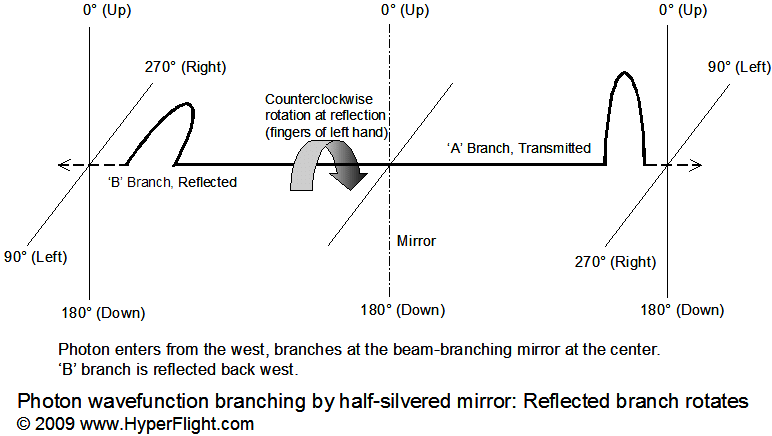 illustration filename: photon-transmit-reflect-in-half-mirror.gif
illustration filename: photon-transmit-reflect-in-half-mirror.gif
What happens is that
the transmitted
half of the photon does not change its polarity and continues with Up
polarity. The reflected half of the photon, however, branches and its
polarity rotates 90 degrees counter-clockwise. It is CCW
because we want to predict which way the photon's polarity rotates
and use the thumb of the left hand to allign it with the incoming
(unparted) photon.
The Prize
Behind a Proven Experiment
You might have
heard of a photon that is branched twice and then recombined into
one. This experiment is well established by now and you are in a
position to understand this photonic phenomena.You will never think
of a photon as being subject to gravitation and other some such nonsense.
Below is the
illustration of a photon that is branched twice and made whole again.
If you need additional details on this, go to our Feb
'05 DSSP Topic.
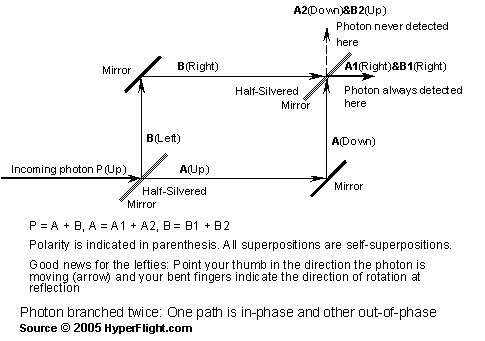 illustration filename: photon-split.gif
illustration filename: photon-split.gif |
|
 |
|
DSSP Topics for July '09
The future gets
fuzzy, but ..
How you can
tell the future
Can you change
the future? |
|
Background
Time is always a
dependent variable (see the last two months' topics below). We cannot
enforce time as a variable such as the variables of length or
distance -- that is, we cannot set some particular time and
subordinate other variables to it. If we want to see the future, we
want to pick independent variables for the forecasting, the idea
being that independent variables will hold on into the future. We
cannot pick time to do forecasting because time always subordinates
to other variables. The scientist might disagree because he or she
has the equation for a planetary orbit and, by plugging in some
future time, he can tell now where the planet will be in the future.
However, the
equation the scientist uses is a particular solution that links
specific movement to a repeatable path and time is but an overlay
that lines up with the tractable forces, distances, and mass.
Similarly, we could use time to predict the start of the baseball
season, but this is only because the repeatable system is in place
(solution exists already). In the middle of the winter we cannot
declare the start of the baseball season and expect the weather to
comply, for time is not enforceable. We could direct a plane to
particular coordinates and enforce such decision.
Independent variables
can also be called
the leading or "strong" variables. Such variables will
prevail in the encounter with a dependent variable. In physics,
momentum will prevail in the collision and the path will subordinate:
bodies in a collision will change their path. Similarly, variables
such as inflation have strong leadership value and we might need even
stronger variable(s) to keep inflation in check.
Okay, the future
To forecast what
is going to happen in the future you need to take all variables, the
full infinity of them, determine their leading and following values,
and let them evolve on ahead. Easier said than done, we will need
infinite superposition (available in the quantum mechanical
environment for physics applications). Consider that your mind, more
specifically you right brain, can deal with infinities. Also consider
the pyramid as yet another computing structure. [Of course, consider
buying the Quantum Pythagoreans book.] As the variables are
interacting there is some delay and this is the future time. Such
delay is not easy to quantify and so we may know what happens but not
necessarily when. The difficulty is in that the leading and following
variables change their strength as these interact and the future time
is highly nonlinear.
So now you know
the future and you
don't like it. And so you decide to improve it. The problem is that
you do not know the timing and it is then difficult to impart changes
now while guaranteeing a better outcome. You are also dealing with
infinities and with a possibility that in the future time you won't
be around the physical plane. |
|
 |
|
DSSP Topics for June '09
Time can be manipulated
Time can be zero
Can recorded
events be erased
Can recorded
events be corrupted |
|
Background
Time travel is not
possible (see May's topic below) but there are things we can do with
time. Time is always a derivative -- that is, time always follows
other variables. Moreover, even though some variables can reverse
their independent-dependent modality, time cannot become an
independent variable.
An independent
variable can also be called the leading variable. Economists
understand this pretty well but physicists likely never will. This is
because physicists confine their math to the arithmetic of algebra
and the equal sign allows them to reverse the relation. And so the
physicists are free to reverse reality into nonreality and don't
think much of it because they defer to their inadequate tools.
Time can
readily become zero
In the quantum
mechanical environment the instant action makes time zero because
time subordinates to other variables. If an event happens
instantaneously then time is zero and time has nothing to say about
the event. Time, in and of itself, does not enforce anything.
Superluminal space travel calls on quantum mechanics at macro scale
and works with variables that interact instantaneously.
Time is defined
by orbits
Periodic movement
happens through orbits. This is a movement having symmetry about a
(geometric) point. [Point symmetry is masculine.] It is then more
appropriate to say that time is about the period. We can keep
adding periods to get time but such time is specific to a particular
orbit as it issues from some specific orbit. Planetary orbits are
generally stable and the time derived from their orbits is not
possible to corrupt.
The memory
Ether can be
energized and the energy, being a function of frequency, can range
from zero on to infinity. All knowledge is stored associatively as
energized ether and can technically stay that way forever. All
knowledge is inherently formed via associative linking with other
knowledge and can also be read associatively. Knowledge cannot be
erased but because other information can be linked to it post factum,
memory can appear to be corrupted. Time is but one of myriad
variables that is linked within the interconnected web of energized
ether. When knowledge is read, any variable can be followed and this
includes time, If time is not followed -- that is, when time is not
in focus, time becomes irrelevant and different time periods can
appear as overlays.
To get the truth
To corrupt
knowledge, a vast amount of contradicting or misleading data is
linked associatively with some knowledge. Reading such knowledge will
then read all data, true or not. Yet, just as any good detective,
other associative paths exist that lead to the truth. The corruptor
would need to deal with infinite quantity of associative paths to
completely mask or corrupt the truth. The corrupting data is added at
a later time and so the time is important when searching for the truth.
Next month:
Using variables to look into the future |
|
 |
|
DSSP Topics for May '09
Time travel is possible:
(a) physically
(b)
mentally into the past
(c) mentally
into the future
|
|
Background
Time travel is
easy to get excited about and this hasn't been lost on Hollywood.
Why, even the so called scientists are joining the act by producing
equations as if equal signs and multiplications are sufficient proofs
for time travel. The basic premise in time travel is that the time is
a bona fide dimension -- that is, the value of such dimension could
be increased or decreased at will -- much like a dimension of spatial
distance. The idea behind the dimension is that it is an independent,
or leading, variable and by establishing a value for such variable
the other things will simply fall in place and in accord with our
value. So, if you wish to enforce the variable of distance you punch
it in the computer and the sensors will tell you when you get there.
But
time is not an
independent variable. Time always issues from other variables and
could be zero during nonlocal events we find in quantum mechanics --
at macro scale no less. There is no way we can lock onto time and
make other things subordinate to it.
So what about
the past
The memory comes
into play here. You would first need to accept that all things that
ever happened are in storage. By accessing the storage you will be
able to read or "see" the past.
So what about
the future
Here, you'll need
to differentiate the leading and following variables. The leadership
of the leading or "strong" variable will continue into the
future fore some time interval. Yes, you can see the future
but only to the extent you follow the leading variables and even then
you will be limited by the dominating reach of the variable -- for
every variable fluctuates in its strength and thus its influence
diminishes into the future. Of course, variables interact and
influence each other and then the forecast is really an art.
Finally
If you think time
travel is physically possible and that, for example, we are being
visited by beings from the future, you want to start with the
fundamental assessment that the time is not a dimension to begin
with. Time isn't and never was the 4th dimension, and such claim is:
1) a fantasy
2) wishful thinking
3) an attempt at corruption
4) any of the above |
|
 |
|
DSSP Topics for April '09
The ancient
Egyptian texts are:
(a)
religious texts
(b) magic texts
(c)
physics texts |
|
Background
The ancient
Egyptian texts aka The Book of the Dead seem to cater to the
afterlife of people and especially to the Pharaohs. But they also
spring to life talking about the sun and the waters. The complexities
of various gods include human and animal forms, supporting/protective
and detracting/dangerous relationships, and plain aspects -- all put
together with stories and adventures. And the props: the ankh and the
scepter the most prevalent.
You would think
the snakes and serpents are in it just to scare kids but once you
start to see these entities as waves, everything changes. You take
the props as geometric forms and then, could it be -- well, yes, the
Ancient Egyptian texts are about physics and one could also say that
the quantum mechanical world has magic in it too. The interesting
part is that the alchemical form of the stories makes it a nice read
and you really do not feel you should try to explain how you got to
this or that conclusion.
Da Sphinx
What makes this a
difficult decode is that the Sphinx is not specifically mentioned in
the text. But it has a lion type characteristics and god Shu is at
times depicted as (or with) the hind part of a lion. Perhaps not the
best part but there he is. Then there is his sister goddess Tefnut
who has a form of a lion head (with a wavy mane). So now you put them
together but you know you are not done yet, for Shu is male and dry
while Tefnut is female and wet. But you also know you are on the
right track because both Shu and Tefnut are called the twin lions
having one soul. Is there such entity in physics? Yes, it is a free
electron. So now you have some fun because in the text Shu and
Tefnut take a trip and get lost. Ra sends an eye after them and they
are found, brought back and get married -- and the human race can
arise after that. But of course, an electron must be made in some
fashion and it could have happened inside the Sphinx, at least
initially. Oh, the eye is the 0D geometric point in which the energy
component of Tefnut is joined with the charge component of Shu. In
another story Tefnut has a problem and runs away from Shu to Nubia.
All hell breaks loose and disasters are happening. A good guess is
that we have antimatter on our hands because the two components of
matter are separated. Thoth and Shu step in and after finding Tefnut
a reconciliation takes place -- that is, antimatter can be healed.
(Music and baboons play a role here and you may get to like the role
of baboons after this.) Now you can leave the text and have even more
fun with odd (Shu) and even (Tefnut) symmetries.
I am posting this
April 1, so that those who don't get it will have a way out. I stand
by it any day.
Yes, we have a
page on alchemy. |
|
 |
|
DSSP Topics for March '09
Tarot card deck
has four suits, so there |
|
Background
Tarot has the
swords, wands, pentacles (coins), and cups suits. Divination using
the Tarot has been with us since the 14th century. Some believe it,
some don't. Some think it works even if you don't believe it. So
there is a mystery and mystery is something everybody likes.
Demystifying something is okay but would you want to turn mystery
into something mundane? Fortunately, when it comes to explaining the
Tarot we run into infinities and the mystery remains a mystery, but
you might get more out of it.
Ah, the geometry
So now the sword
has a point, the wand is a stick of a line, the pentacle (coin) is
flat, and the cup holds the volume. Are we, really, talking about the
zero-dimensional point when it comes to the sword, a one-dimensional
line in case of the wand, a two-dimensional area for the pentacle
(coin), and a three-dimensional volume held by a cup? Could it be as
simple as the 0D, 1D, 2D, and 3D -- the four dimensions of freedom?
Even if that is so, does the geometry in these four dimensions
dominate our environment to the extent that geometry rules? Better
believe it.
When we perceive
the various dimensions the brain makes unique contexts. Some things
work in 0D and that is when the spin comes in. In 1D the even
symmetry and linear motion come up. In 2D the energy arises as
squares and orbits of the circular motion begin as well, and in 3D we
start to reach out and diffuse and penetrate the environment.
Tetractys
Pythagorean
Tetractys is a triangular numeral ten. It has ten dots: one on top,
two below, three below that, and four dots on the bottom. From the
very beginning of 500 BC, Tetractys dots stood for a point (0D), a
line (1D), area (2D), and volume (3D). So there. Take it from here.
Note
{March 8, 2009}: And so it happened I picked up
a book Magic of the Celtic Otherworld by Steve Blamires and
there, under 'greater magical weapons' are pictured the spear, sword,
shield, and cauldron. Well, happy workings! |
|
 |
|
DSSP Topics for February '09
Handedness
reversal is no big deal
The even
symmetry of the mirror is a big deal |
|
Background
Most of the
Internet answers on the left hand & right hand reversal in a
mirror are okay but they tend to get wrapped around the axle in the
blogs. Last month we kicked off this topic with a suggestion that the
thickness has something to do with it because for a purely 2D thing
-- such as the up/down and left/right -- there are no problems and no reversals.
Discussion
So the reversal is
in the depth, that is thickness, and that is the 3rd dimension. As
you move your hand away from you (North) the hand's image in the
mirror moves toward you (South). So far so good, and here is where
the other Internet sites end.
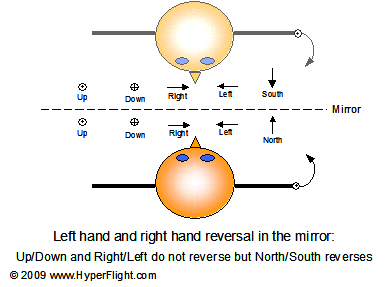
Picture filename: left_right_hand_reversal.gif
Variant and Invariant
Now you bend the
fingers of your right hand and the counterclockwise movement of you
right hand's fingers becomes the clockwise movement in the image. If
you stick your thumb up you know the Up is invariant under mirror
symmetry and now your right hand becomes the left hand in the image.
You don't have to
get bogged down with "how do you know which hand is the right
hand" kind of thing. In 3D the left and the right handedness are
uniquely and absolutely differentiated and then you declare
which hand's thumb is pointing Up -- and now you are consistent
throughout the universe because you know your x--y--z's.
A math guy
can see the even
symmetry as the even function when placing the axis of symmetry at
the mirror -- shown as the dashed line in the illustration (usually
vertical). But, if you are really good you can put the two and two
together, for the even symmetry is about energy. The construct of
symmetry has priority, and then .. .. happy workings.
Metaphysically
you are working
the feminine. |
|
 |
|
DSSP Topics for January '09
Your left hand
becomes your right hand in the mirror and vice versa |
|
Background
I picked up a book
titled, appropriately, 'Mirror.' A nonfiction piece. So I went
through it to find their explanation for this month's topic but,
while the book was just about everything you could imagine, the left
hand -- right hand reversal was not in there. Then I came across a
related article but that one did not explain it either. It concluded
with '.. it depends how it is defined.' Well, I just don't need
another theory trying to prove that something cannot be done.
But why would this
simple topic be so difficult?
Background s'more
You might think
there is not much about explaining this hand reversal thing if you
are used to seeing images upside down in the "old" film
cameras. In the new digital ones you get it right right on the
display, so why is a mirror doing this?
It may be worth
your while to figure this out by yourself -- it sure makes for a
great mental exercise and symmetries are big in atomic physics and
free energy, too.
Discussion
If you got to this
point you decided to read on but it could get darker before it gets
easier. We understand that, in a camera, the 'up' and 'down' get
reversed on the focal plane and when you move your hand up, the hand
in the image moves down. Similarly for the right and the left.
Through the camera lens your movement to the right becomes the
movement to the left (because it moves through the point of the focus).
However, with the
mirror it gets stranger. When you move your hand to the right, the
hand in the image also moves to the right. When you hop up in front
of the mirror the image also hops up. So, if the up and down do not
reverse and also if the left and right do not reverse, how come the
watch you are wearing on you left hand is being worn on the right
hand of the person in the image? You always wear your watch on your
left hand! How come the up and down are normal but your left
and right hands reverse? I mean, taking the mirror back to the store
is not going to solve this.
You might have
heard that a mirror symmetry rotates about an axis. And so you might
get an idea that if up and down do not reverse, you could lay down
horizontally in front of the mirror, for if your head and your toes
do not reverse then your outstretched arms in the up and down
direction should become normal again. Go ahead and try it. If that
doesn't work, stop by again and we'll finish off this topic in February.
Okay, here is a hint:
If you cut out an
outline of your hand on a piece of paper, would another person be
able to tell if you used your right hand or your left hand as the model?
Another one: If
you left pencil markings on the paper after cutting the outline of
your hand, would the other person be able to tell which hand you traced?
Note {Jan
30, 2009}: The symmetry about a point is the
odd symmetry and metaphysically it is masculine. A camera lens has
the odd symmetry, in 3D no less. The mirror symmetry is the symmetry
about the virtual line (axis) and metaphysically it is feminine, in
3D no less. |
|
 |
|
DSSP Topics for December '08
Light is energy
Light is pure energy
Light is an
even function |
|
Background
No disagreements
that light is energy. Light can be converted to heat, electrical
energy, and motion. The conversion of light, however, calls for the
light's (photons') absorption and then the photon is gone. Cannot get
photonic energy without photon's absorption also called reduction or
collapse. If we are in agreement at this point then there is no
problem in agreeing that light cannot impart pressure at reflection,
for that would mean we get energy while the photon goes on its merry
way without regard to the conservation of energy.
Even function
Last month we just
said that any and all energy is an even function. What that means is
that the energy is evenly distributed about the axis. Yeah, but can
we prove it? But of course.
Young's
dual-slit experiment
got many people
excited about the wave nature of light. Presently there aren't too
many problems with this experiment, particularly since light has no
mass and photons can part and then self-superpose. Since then the
phrase 'interference pattern' slowly yielded to 'superposition pattern.'
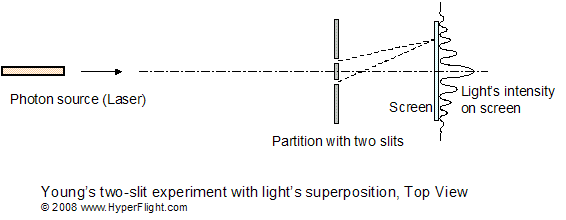
Picture filename: Young_shield_dual_slit_normal.gif
Asymmetric blocking
is also a part of
the experiment that shows some deep properties of light. Young
inserted a partition and was astounded to discover that the shield
blocked the superposition pattern from both sides. Now what.
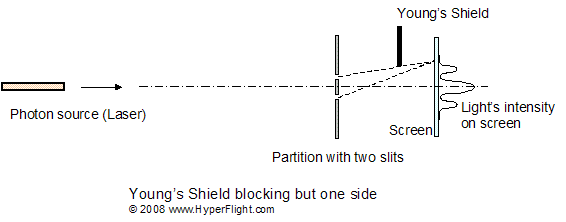
Picture filename: Young_shield_dual_slit.gif
There are no easy
interpretations of this phenomenon, but we gave you some pointers in
the title and in the last month's topic. Light is an even function
and it will always remain an even function, in spite of anybody's
attempts of warping light through optical or other means. Light will
always maintain its even symmetry (symmetry about an axis) no matter
what. The shield can reduce the particular photon in its entirety or
the photon instantly reworks its wavefunction if the shield does not
reduce the photon while maintaining its even symmetry construct. Nice
to know the even symmetry is a construct that is invariant during
optical (and other) photonic interactions.
Surprise in
all this is that the axis of symmetry serves to halve the photon's
energy when the photon is absorbed. Well, one half of the photon's
energy is imparted one way while the other half the opposite way and
we get to conserve momentum when light's energy transforms into the
moving energy. Didn't Newton say something about the equal and opposite..?
Happy New Year. |
|
 |
|
DSSP Topics for November '08
Is there more to
energy than 'more' or 'less' energy?
Can we
generalize energy?
What is energy, really |
|
Background
Energy is
something that moves things. It is then easy to see energy as
"more of it you have, faster you can move." We know that
energy costs money and we can buy it in the form of oil, gas, or
electricity. So far, it is deeply engrained in our brains that to get
energy we need something that is consumable. Not only that, we
consume materials to create energy but we always get heat in the
process as well.
Movement
Energy is about
movement and it is the force that feeds the movement. So, where do
you find the force or how does the force come about? You can take
something that is moving already and get energy from it by slowing it
down: A running stream or a spinning planet, say. Or you could figure
out how the planet gets to spin in the first place and engage that mechanism.
It turns out
that the force
appears when the organization increases. This seems ambiguous but the
idea is that increased organization contains energy in the form of
the virtual energy. The good part is that heat does not result from
the movement that increases organization. Energy can thus be
harnessed from superior knowledge. Matter has the innate knowledge
for increased organization and this is based on the Pythagorean
Tetractys. Alternatively, energy can be had by decreasing
organization where the upside is that not only the oil or gas can be
used as consumables. The downside is that heat will result whenever
consumables are used -- that is, when matter with the higher
organization changes to one with lesser organization.
Organization
synonymous with intelligence
Energy always
exists as an even function. Energy is always symmetrical about an
axis and its reduction will create forces. A photon of light is the
most obvious example of an even function that is energy. Since the
electrons can become virtual they can also acquire even function
characteristics and can also be used for energy extraction. The
universe is full of virtual and energized electrons.
So how do we
manifest the energy? The axis of symmetry could be a stick, an
antenna, a post. You will also need to understand the rotation and
orbitals, which is really about the symmetry about a point and the
squaring of a circle. Happy workings. |
|
 |
|
DSSP Topics for October '08
Irrational
number is not a real number
Even if that is
so, what's the big idea? |
|
Background
Irrational number
has its decimal fraction going to infinity without any of the numbers
repeating as a group. The most common example of an irrational number
is the square root of two. It is well established that rationing of
any two integers will not create an irrational number. That is,
starting with two finite numbers and placing them in a ratio will not
result in an irrational number. Put another way, if you have two finite
numbers, their ratio will also be a finite number.
Along comes this
guy Dedekind and he goes about proving that one can cut any distance
between two numbers in half and if you were to go about it doing it
forever, you will eventually reach any number, including the
irrational number. His conclusion is that irrational numbers are
really rational, that is real, numbers. The sad part is that math
textbooks today all classify irrational numbers as belonging to the
domain of the real numbers.
What's wrong,
or, who cares
Technically we
could object to incorrect classification and duke it out on the turf
of academia. This site, however, is also about free energy and it is
then important to show that the benefits of irrationals have
something to do with free energy. Academia, then, has nothing to do
with it and they may as well print any nonsense they want.
Fundamentally,
Dedekind proof is
invalid because it becomes true at infinity. The proof is
"right" but only at infinite time in the future, which is
never. This is very much the same thing as when the computer
calculates the square root of two, for example. We all agree that the
computer can technically produce the square root of two because the
machine keeps spewing out the numbers that all belong to the square
root of two. However, no matter when the machine stops the result is
not the square root of two because the square root of two has an
infinite number of digits and the computer can produce them only at
infinite time in the future.
Moreover
Geometry produces
the square root of two in finite number of steps (in finite time) and
does so exactly.
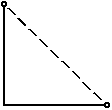
picture filename: Square_root_of_two.gif
In the
illustration above the distance between the two zero-dimensional
points is exactly the square root of two. Geometry is once again
superior to arithmetic but the real bottom line is that you need
geometry with its inherent exactness if you ever wish to capture the wave. |
|
 |
|
DSSP Topics for September '08
Brown's gas vs
(almost) everything else |
|
Background (Continued
from August and July '08)
Brown's gas so far
is a mix of hydrogen and oxygen made from water. On its own these two
gasses burn or implode back to water. Brown's gas torch is
interesting because the flame is relatively cool and the fire shows
as a plume going into the nozzle even though the gas is going out.
Different materials react differently with the flame and, for
example, tungsten can be melted while a piece of brick can acquire a
hole -- sometimes.
What is this thing
Brown's gas can be
energized even more while in its gaseous state. The way Stan Meyer
worked this gas is by adding energy to it via particular light
frequencies and then mixed it with the atmospheric air before
injecting it into the car's cylinders. The idea -- apparently a
successful one -- is to get the Brown's gas to burn with other gas by
explosion rather than implosion. He even recycled some of the exhaust
gas into the intake to keep Brown's gas in the expanding mode so to speak.
Is that all?
No. As the Brown's
gas is being formed, excess electrons appear. This is part of the
free energy "equation" and it moves Brown's gas into the
fantastic category. Here is also a point where you are on your own,
at least in the foreseeable future. If you want to pursue Brown's gas
to its full potential you may have to become the Fool of the Tarot. A
person who goes on, looking kinda strange but feeling there is a way
there somewhere -- that there are indeed higher forces helping you
along the way. |
|
 |
|
DSSP Topics for August '08
Brown's gas vs petroleum
One has
hydrogen and oxygen
The other
just hydrogen and a lot of excess baggage |
|
Background (Continued
from July '08)
The chemical
composition of Brown's gas continues to be debated and there are not
many who would go for H4O2. The majority sees
Brown's gas as a short-term-stable monatomic hydrogen H and oxygen O
rather than the molecular form of H2 and O2
found in the atmosphere. When Brown's gas burns as a flame it turns
to water. Brown's gas is also called hydroxy or HHO.
What is this thing
Brown's gas is
made from water and is added by many to the air intake of their car.
With as little as one half liter per minute, the car runs smoother
and emissions go way down. In our mind the fuel burns cleaner -- that
is, more thoroughly, and there is then, literally, more bang for the buck.
The linear approach
If a little bit of
Brown's gas helps, let's put in more. Maybe even run entirely on
Brown's gas, just like Stan Meyer. Now the engine starts to run rough
-- but -- the ignition timing can be changed to smooth it out again.
Sometimes you may look at the timing -- only to find out that for the
smooth running engine the spark is firing way off the top of the
cylinder's position and that just does not make sense. Sometimes the
Brown's gas explodes and at other times -- it implodes! Almost as if
Brown's gas does what it can and when it can to help you run the car.
Here is where the linear guys get amazed because they really would
not want to admit they are confused. For pure Brown's gas, the volume
of the resulting water is much less than the volume of Brown's gas
and we can also have an implosion. To add to the mystery the car also
runs cool.
Can this thing
be stabilized
Yes. There appears
to be a range where Brown's gas -- produced via straightforward
electrolysis -- gives consistent results, particularly if it is
introduced into the engine in small quantities. Brown's gas intrigues
the mind and there will always be people tinkering with it. Brown's
gas reacts dramatically with a spark or a flame but, because Brown's
gas is made on demand under the hood, the setting off of Brown's gas
(if bypassing the safety "bubbler" to begin with), is
confined to the area the gas is produced. Even then a safety plug
blows off and without damage to the container holding the water from
which the Brown's gas is produced.
What do the
scientists say
They are busy
making hydrogen from -- you guessed it -- the oil, to be ready for
the so called 'hydrogen fuel cell' in the car.
It takes energy to
produce hydrogen from oil or gas. If the hydrogen does reach a fuel
cell in the car via a pipeline infrastructure, the hydrogen fuel cell
makes electricity to power the car but in the process makes a lot of
heat. So much heat, in fact, that the fuel cell of "the car of
the future" cannot power the car directly and is primarily used
to charge the battery. The fuel cell of "the car of the
future" also burns oxygen from the atmosphere. Brown's gas has
both the hydrogen and oxygen and there is no net burning of oxygen
from the atmosphere.
Back to Stan Meyer
This guy showed
that Brown's gas can be produced at over unity. That is, the Brown's
gas that is created through a particular on-board (on-demand) process
has three or more times the energy that was put in to make it. This
gets into the free energy arena very quickly and so don't expect
scientists to embrace it. Yet, the scientist can be, and likely will
be, left behind once the hydrogen-from-hydrocarbons becomes more
expensive than the on-demand hydrogen from water. There are four
keys: Cost, safety, oxygen depletion, and heat. On all four
(ac)counts the Brown's gas is the way to go.
Note1
{Aug 12, 2008}: A neat tradeoff in near-term
Brown's gas application is the catalytic converter. Even small
amounts -- possibly as small as 1/4 liter per minute -- can take out
the polutants to below the present standards and consequently
dispense with the catalytic converter altogether. Technically, the
heat energy produced in the catalytic converter is now moving your
car. If you remember Smokey the Bear and his "You can prevent
forest fires," you want to see the catalytic converter go.
Note2 {Sep
15, 2008}: Hydrogen can be imparted with
additional energy giving it additional and unusual properties. (For
one it changes the burn character of hydrogen.) Yes, there is a name
for it, parahydrogen, but no ready explanation. My guess is that the
electron's orbital does not enter the consideration but that the core
(proton) acquires additional vibrational frequencies and with it new
fusion properties, which could conceivably aid in transmutation. |
|
 |
|
DSSP Topics for
July '08
Brown's gas is:
(a)
Fractured water
(b)
Energized water
(c) Just
hydrogen and oxygen mixed together
(d) None of
the above |
|
Background
This guy Yull
Brown is a Bulgarian-Australian-American (All Slavs are
euphemistically called East Europeans) who generated and worked with
this gas that -- through an electrical process -- bubbles up from
water. Heavy set with a heavy accent, Yull championed the gas for
many applications and it is then named after him. Brown's gas burns
or explodes and in the end becomes water again. No problems so far.
On its way to coming back to water, however, Brown's gas reacts with
the surrounding atoms in a funny way. Brown's gas breaks down all
kinds of hydrocarbons as it reacts (burns) with them. Brown's gas is
the first thing you run into when you want to improve the mileage on
your car and lower the car's emissions. It's a win-win additive.
That should have
put heat on the automakers -- and it did -- but it did not set them
on fire. It could have evolved into a nice little additive but there
is more to Brown's gas. What happened was that Stan Meyer from Ohio
(heartland-American) took the Brown's gas to the next level and built
a car that runs entirely on Brown's gas. To make matters completely
wacky, Stan's claim is that the energy to produce Brown's gas will
power the car and make more Brown's gas to power the car some more
while making more Brown's gas to .. the bottom line is 22 gallons of
water coast to coast.
What is this thing
The first step is
the spectroscopic analysis. Brown's gas is not hydrogen and oxygen
mixed together and neither it is a fractured or broken up water. It
is an entity (molecule) of its own. It does not condense at room
temperature. It bubbles up nicely through cold water but does not
condense as the steam would. It is heavier than air. Some say it
returns to water spontaneously after a while, a molecule at a time.
Having many unusual properties, Brown's gas is commonly used for
specialized welding but many of its properties are kept under wraps.
All matter is
computational in nature and the Brown's gas appears to be yet another
gaseous state of water -- likely H4O2. (If it
is H4O2 then its density should be between the
carbon monoxide CO and carbon dioxide CO2 gases.) Everyday
water that is H2O gets to Brown's gas mathematical
solution by addition of energy and such energy is then recovered upon
its return to water. But that still would not explain the over-unity
claim of Stan Meyer. So, here is where the zero-point energy comes in
and as the Brown's gas is being created it absorbs extra energy from
the surroundings to reach its new state and consequently returns
over-unity upon return to water.
Not every process
that generates Brown's gas is over-unity. The basic process uses your
car battery's DC current and produces Brown's gas at some energy cost
-- but -- this cost is less than the cost of gas. 20 to 50 percent
mileage improvements have been reported and, in addition to a
dramatic decrease in exhaust emissions, 20-50% is your net energy
savings -- which also means that 20-50% of the energy does not end up
as heat.
What else
Can we link
Brown's gas to other things? If we accept Schauberger's results when
he squeezes ("implosion" is his term) energy out of water
or air, it appears that Brown's gas is present in small quantities
all around us. It is also likely that Brown's gas plays a role in our
bodies' metabolic processes when we convert food to energy.
It is said we
don't really drink beer -- we just borrow it. Well, we can say the
same thing about water in general and Brown's gas in particular.
Water is really a carrier for energy. Water, perhaps, can be seen as
a form of a liquid crystal. |
|
 |
|
DSSP Topics for June '08
Some claim
magnetic motors violate the conservation of energy and leave it at that
Some claim
magnets can be made into self-running motors and don't leave it at that
Some make
self-running magnetic motors and don't care one way or another |
|
Background
Much discussion
has been had on the conservation of energy and why self-running
magnet-based electric motors would not or could not work. Then
YouTube appears and everything changes. You may not even want to
watch the classical tube anymore (you know, the one where they serve
you what they want to serve you). At first the discussion is on trick
photography. Then some showcased products suddenly disappear. Instead
of thinking that the trickster was exposed, the fundamental reality
flip makes you think that somebody is getting rich on free energy.
Then a bunch of scientists make a video on zero-point (free) energy
and in their classical bombastic fashion they claim that one cubic
foot of space has a lot of energy -- hey, they actually calculated
it! The scientists do not speak about the inventors as pyramidiots
anymore. (The term pyramidiot took hold after the pronouncements of a
British aristocrat.) We begin to feel that if the earth were to flip
its axis the scientist could agree with it but only after the fact.
We file the scientists into the 'have degree -- will insult' category.
Intro
Magnets attract or
push away. Forces being equal (really equivalent), one magnet can be
made to pivot and spin by a static magnet but when the rotating piece
comes around, it gets repelled and stops. So now you have to move the
static magnet that did the pushing just a little bit away so that the
spinning magnet gets over that repelling moment -- and then quickly
move the magnet back so it can do more pushing and speed up the
spinning magnet a bit more. You may imagine some simple oscillating
arm that would move in and out -- and we have a self-running motor.
The logic here is that once the motion arises we got real moving
energy and if the oscillating arm arrangement takes less energy then
we have over-unity. The fundamental logic is that the movement gives
us energy but the implementation of switching of a polarity
could conceivably take no energy.
The Model
If the magnetic
motors self-run (and many do) we do not need a model -- that is, we
don't need a theory. Yet, sometimes we need a model so that we can
improve on what we've got. Saying that space is loaded with energy
does not help us with the work because it contains no mechanism and
it is, therefore, no model and no theory. Saying that space has a lot
of energy is the same thing as saying the ether exists -- it means nothing.
So we want to look
at how the magnetic phenomena happens in the first place. We guess it
has something to do with atomic orbitals and the flow of the charge
that becomes symmetrically organized. But I would not leave the
atomic core out of it. It is quite possible that the core formation
and its gravitational interaction allows the unique orbitals to form
and it is happening on an ongoing basis. If so, the permanent magnet
owes its existence to gravitationally influenced cosmic scale
behavior and the "over-unity" energy is then an extraction
of the energy that exists in the larger context rather than being
local to the magnet.
Oh,
You may want to
cancel some of your science classes. The world is a-changing. |
|
 |
|
DSSP Topics for May '08
If a synaptic gap
is a connection, what's the big deal?
What if the
synaptic gap is not a connection? |
|
Background
The synaptic gap
is, without exception, considered an on-off switch. Just like your
electrical switch, the current or the signal flows or it does not.
All books on neuron or brain workings [I've seen or heard of] take
the synapse and use it as the switch to build more and more and more
complex systems until we got the brain. The brain is just like a
computer we all know and love. After Cajal's work on the clinical
aspects of the synapse, Sherrington coined the name for it around 1900.
So now the experts
have a lot of fun of counting the brain cells or synapses and
comparing it to the gates on a computer chip. The phrase Artificial
Intelligence comes up often, although to some of us it is more
artificial than intelligence.
But
We still do not
know why the computer cannot figure things out by itself even though
the signals in a PC are million times faster than the signals running
down the axon. So, the science writer puts it in the category of
musings and, of course, they need more money for research to close
the gap, so to speak.
Ah, bring in
the quantum mechanics
The 21st century
is upon us and the brain cells could now have something to do with
the quantum. The synaptic gap is measured, scanned, and analyzed.
There are chemicals that can influence the gap in general and that
can help people with mental problems (or healthy people to acquire
mental problems) and it all fits the equation. Not only the equation
about power, control, and money -- but it also fits the scientific
equation about the synaptic gap: Quantum mechanics has no role
to play because the gap is too wide for the quantum entities such as
the electrons to reach out and tunnel through the gap -- and thus
make the closure of the switch. This is all very rational and proper,
and this is the result of a broad scientific consensus from UTrue to UCon.
But
The model of the
synaptic gap-equals-switch is really about our own cultural bias,
albeit from the 21st century. The gap is not an on-off switch simply
because every synaptic gap has a very unique and different profile
and, moreover, the gaps have two different modalities of reaction:
the chemical and electrical. Now what.
Info
What if each gap
intercepts but a particular -- that is, specific, information. Uhh,
the info would then come in from the outside rather than through the
brain's internal wiring. Telepathy? How unscientific can you get?
Yep, this is no science for the scientists but for the rest of us it
makes extra sense. |
|
 |
|
DSSP Topics for April '08
The matter of
gravitation is so simple it is complicated |
|
Background
There is a lot
that has been said about matter. This thing can put a dent in your
car, moves about in sort of circles of the heavenly orbs, consumes
gas on acceleration and wears out your brakes on deceleration. It
weighs a ton here, not even close on the moon. Matter attracts other
matter in the act of gravitation and does it so persistently it
readily warps any theory trying to explain the strange attraction:
Out of nowhere, across vast distances, instantly, silently. Even
though masses attract each other, matter does not cluster in one
spot. This, this thing attracts but does not cause jams. As much as
we think about it, the collision is not the norm for the matter out there.
Possibly the best
thing we know about gravitation is that it is a core behavior, rather
than the electron orbital, that deals with gravitation. Well, this
does not fit in the background category.
So now
As far as we can
tell, electrons do not get bothered by gravitation. Gravitation does
not produce photons that are in the regime of the electron and does
not ionize matter. Gravitation does not reduce electrons into one
spot because it does not interfere with the dual slit experiment. So,
let's just take the electron out of the gravitational mechanism.
So now
What do protons
have that electrons don't? Charge polarity, for one. For another, a
significantly larger mass. But that is not the whole story because
neutrons are a component of the gravitational pull and neutrons do
not have a net charge. If the gravitational force is formed by waves
-- really wavefunctions, then the wavefunction must reduce to realize
the momentum. But what would be the periodically reducing mechanism?
So now
A wavefunction is
a virtual entity and one of its characteristics is that it can span
rational and irrational distances. The movement or the spreading of
the wavefunction is infinitely smooth and (that is nice, but) there
does not seem anything in the way that would reduce the wavefunction
when bodies move away or closer together. The smoothness, however,
works well to recalculate the wavefunction as a function of distance
via the geometric mean, for example, because we need the square root
to compute the force.
So now
It seems that one
way of figuring this thing out is that the core must be spinning. A
spinning thing must deal with the angular vs. linear considerations
and then a quantization comes in that periodically reduces the
wavefunction. This would also fit the creation mechanics for both the
linear and angular momentum. Yes, gravitation is not only about attraction. |
|
 |
|
DSSP Topics for March '08
Archimedes
got to Pi, but did he get to the derivative?
Was
Newton-Leibniz duo really the first? |
|
Background
In the early
1700s, Newton and Leibniz fought it out for the priority of the
invention of calculus. But was Archimedes there 2000 years before
them? Besides, Archimedes is alleged to write a book The Method,
which was lost. We know that Archimedes was doing well applying the
limit via his method of exhaustion and got beyond the Pi of the
circle by calculating the parameters for the sphere, cylinder and
cone. A proposition could then be made that Archimedes discovered
calculus -- way in the ancient times. Kepler also took a stab at
calculus by estimating the volume of a beer barrel.
Then again
Besides taking
limits to infinity, the critical juncture in arriving at the
derivative (aka tangent) of calculus is -- the even older and the
really ancient Pythagorean practice of rationing. Yes, the
only way to get to the derivative is to put two variables in a ratio
and then applying a limit to that ratio. It seems Archimedes
did not put variables in a ratio. Kepler, for his part, did put
variables in a ratio and did apply a limit to it but he was working
with the Fibonacci series (and got to the golden ratio) but he did
not do the same with a mathematical function in general. Both
Archimedes and Kepler have worked the curving distance in
ever-smaller increments -- Archimedes on a circle, Kepler a bit more
general on a beer barrel -- but the idea of a tangent eluded them.
Who was really
the first?
Leibniz published
first but Newton thought Leibniz took his ideas and jumped the gun.
Newton circulated some of his papers among his trusted associates,
but the real purpose was to get a broader consensus and maybe a few
comments prior to publishing. Leibniz, on the other hand, had his
process down pat and was comfortable publishing without a peer
review. So they had a row but with some distance it is apparent
Leibniz got to the integral portion of calculus first. Newton was
ahead on the derivative side but only technically, for Leibniz
published first. A derivative is sufficient when working the
gravitational acceleration, but for a volume of a beer barrel you
really need the integral. My vote is for the beer -- with a toast to Pythagoras.
Today..
Once a while
something is published only to be announced that somebody figured it
out earlier. One example is (the Czech guy) Mendel, who was able to
get full credit posthumously and 30 some years after his publishing.
Others may not be that "lucky" and so perhaps having a peer
review is not such a bad idea.
Note: {April
5, 2008} Leibniz discovered that during a
collision the direction as well as energy is conserved. Leibniz did
not get much credit for that and today it is just called the vector
law, rather than, say, Leibniz vector law or Leibniz force linearity.
Yet, Newton's gravitational law relies on vector linearity because
the gravitational forces are vector-added. I did not do any research
on this but if Leibniz formulated the vector law first then Newton's
claim to the universal gravitational law weakens considerably and
narrows to the "square of the distance" component. |
|
 |
|
DSSP Topics for February '08
Can you
split the photon's energy? |
|
Background
Last month's topic
alluded to a particular mechanism carrying the energy of a photon.
Okay. We also know that a photon can eject an electron from an atom.
To make things more complicated -- but more interesting -- the
ejected electron's energy is always less than that of the photon
doing the ejecting. What's happening?
To make things
even more complicated -- but far more interesting -- we also made a
case in our February '07 DSSP topic that a
photon cannot be physically split. Can all these things be reconciled?
But of course!
To get something
to move we need to conserve momentum. To conserve momentum, two
things must be moving (or rotating) in the opposite direction with
equal energy. This is easy enough when we consider the recoil of a
rifle or when moving from a small boat and onto a dock without
getting wet. Right off, a photon that ejects an electron must also
impart the same and opposite energy to the core. The electron, then,
cannot have more than 50% of the photon's energy.
We are down to the
last step. If a photon cannot be split, how could its energy be split
-- as it must if it is to move something (in the framework of mo conservation).
Absorbing vs Non-absorbing
photonic interaction
The absorbing
photonic interaction reduces the entire photon and the photon's
energy transforms to other forms of energy. In the non-absorbing
photonic interaction, which could also be called the optical
interaction, no energy exchange takes place. Once the photon is
absorbed it is gone and only its energy lives on in other forms. In
the optical (non-absorbing) interaction the photon can be stretched
and its shape changed, but its energy always stays the same.
So, how
could a photon impart 50% of its energy to one thing (the core) and
the other 50% to the other (the electron)? The photon is always an even
wavefunction and its energy is always symmetrical in the 50-50
fashion about its axis of symmetry. Photon's energy can be split
50-50 but only at absorption.
(Self-test:-) If
you figured out that a photon cannot impart its energy when
interacting with but one object, you are doing really well.
Why, you might even be a Pythagorean. |
|
 |
|
DSSP Topics for January '08
The photon's
energy is its frequency.
If the photonic
frequency is the same as the photonic shape then we can change the
photon's energy by reshaping it. What?
Wheeere is the
photon's energy? |
|
Background
So you've been
told -- or perhaps you paid money to be told -- that the photon's
frequency is its color and its energy. So far so good. Then they
showed you a picture of a photonic shape and everybody assumed the
shape is the photon's frequency. But then the photon is sent through
double slits and acquires a different shape. Then the photon is sent
through three slits or through a crystal and acquires other and
different shapes. The number of the photonic shape undulations
changes in each case; yet, the color -- that is, the photon's energy
stays the same. What is going on here? You certainly want your money
back if the teacher does not have an explanation. Chances are they don't.
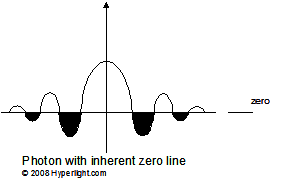
Picture filename: photon_frequency_energy_shape.gif
Where is the position?
The photon's
undulations are not about the photon's energy but that of the
photon's position. When we reshape the photon through various
geometries we change the probabilistic distribution of the photon,
for the photon is a virtual entity and exists as a nonlocal whole.
Yes, this is not difficult to understand even though the teachers
hate to say the word virtual. And so it is the probability of seeing
the photon in a particular spot that changes. Bouncing off a mirror
changes the position of the landing photon as well, but with slits
and other geometries each and every photon can also be stretched.
Where is the energy?
The photon can be
stretched and undulated in an infinite variety of ways. But if the
photonic undulations do not reveal anything about the energy, where
is the energy? You may want to pose this question to a teacher before
you pay for your next course. If you do not get a satisfactory
answer, look up some math of Dirichlet and consult the illustration
above. To understand it, you want to ask a question: "If the
energy stays the same even though the shape can be shaped and
re-shaped, what is the mechanism that would keep the energy the same? |
|
 |
|
DSSP Topics for December '07
If line is
one-dimensional and area is two-dimensional and volume
three-dimensional, is a zero-dimensional point the fourth dimension?
Is 0D just a
point of no interest? |
|
Background
Somehow the
zero-dimensional point has receded into the background. Some writers
like to call the time the fourth dimension, as if the
zero-dimensional point is too small to be mentioned. Then again, we
could not construct a line or a circle without a point or two. So,
why is a point relegated to obscurity in Western science?
Well, the
reason the zero dimensional point is ignored is because the 0D point
is not easy to understand and because the reductionists are running
amock in Western science. In Eastern science the point is not only
some geometric abstraction, it is right in your body. Dantien
(Chinese) or Hara (Japanese) has its place just below the navel and
it is a geometric point that has its own applications setting.
Rotation.
You need a point to rotate about it. If 99% of all moving (real)
energy in the universe is in the form of rotation, a point is used
all over. It can be said that a point must be used for orbits. If a
linear dimension (is straight and) allows the freedom of movement in
a particular direction, then a point is a pivot that allows movement
about it to create rotation and orbits. And, if a point allows the
circular motion to arise, isn't the point -- that is, the 0D, the
fourth dimension? You bet.
Freedom of
movement is just that. We can move there if we can, should, or ought
to. That is what 'independent' means when we say the independent
dimension. Time is not an independent variable nor it is a dimension.
Time always depends on other things and that makes time dependent.
Yep, time can never be an independent variable.
Pythagorean Tetractys
is about the 0D, 1D, 2D, and 3D contexts of geometry. Together they
are the tetra or the quad -- the four dimensions of space.
Happy New Year |
|
 |
|
DSSP Topics for November '07
Cellular
automaton follows rules but so what |
|
Background
Some scientists
use cellular automaton rules to make pretty pictures. They show the
formation of leaves, stems and even things you have not seen before.
All cellular automatons follow the 'If-Then' rules just as computers
do. Usually, a particular and simple black and white squares (cells)
on a grid starts the whole thing off and the creation of neighboring
and empty squares are filled in using simple rules. If, for example,
the east and the north squares are black then the center square will
be white but otherwise it will be black. The squares fill in and we
might get some interesting two-dimensional shapes if somebody manages
to stop the machine in time. Sometimes the machine ends with a
particular pattern and sometimes the machine cycles through a group
of patterns.
The extension
Because some
cellular automatons make shapes that resemble leaves, many scientists
jump with joy and do not mind trying to convince you they discovered
how God makes leaves on trees. Then they make the extension that
since they can make similar things as found in nature, who needs God?
Wow, they can even make more varieties than God -- if God were to
exist, that is.
The nonsence
The thing is that
the cellular automaton does not do any more than any rule based
system. Somebody supplies the rules and the computer just follows it.
The cellular automaton does not and cannot finish any different next
time around and so it contains no intelligence that would improve the
speed of the pattern formation. There is nothing in the cellular
automaton that would improve anything and the scientist is then left
with changing this or that to see where it goes. The programmer than
tweaks the rules just as any programmer could. There is nothing
innate in the cellular automaton that would change anything, short of
random processes, which the scientist likes to substitute for lack of
intelligence. The cellular automaton is as smart as a five-year old
and it cannot get any smarter. And so it happened that the only
person who likes a cellular automaton is another scientist. They love connect-a-dot.
There are no applications
for cellular
automatons and now the scientist has but one choice: Argue
that the cellular automaton is somewhere, somehow, useful. What
utility there could be they do not say. The mind job they do is good
for doing it on each other. |
|
 |
|
DSSP Topics for October '07
What is
geometric computing? |
|
Background
So you construct
the square root of two by constructing the square. The diagonal is
the SQRT(2). Nice. You are done in no time. But so what? Well, your
PC cannot do that. You can get SQRT(2) to many, many decimal places
but sooner or later it's time for dinner and so you declare the
result close enough. You can come up with many, many good reasons why
close enough is good enough. You really do not have much choice but
come up with some excuses because otherwise you would have to deal
with the real question: Why is that so?
The irrational
Geometry deals
with irrationals as just another number. Infinite mantissa included
all the way. In finite time. Tractable.
Energy it is
If you construct a
geometric structure and have, say, the SQRT(5) as one of the
distances, the distance having the value of 5 is there and waiting.
What if something that represents energy is now inside the unit 5.
What is going to be across the distance of the SQRT(5)? All
wavelengths that form the infinity that is the SQRT(5), that's what.
Maybe add a few things to make the golden ratio out of it. (If you
are not excited now you might be later.) |
|
 |
|
DSSP Topics for September '07
No string can
be made into a perfect circle
So what's the big
deal about the circle? |
|
Background
As you pursue the
geometry of a circle you may discover that a circle's periphery is a
transcendental number and, consequently, if you take pieces of ropes
or wires you will find out that the length of any string is a finite
-- that is, a rational, number. Therefore,
-
You cannot take an
everyday string and make a perfect circle out of it. And also,
- You cannot
make the perfect circle from any real thing such as wood, clay,
metal, plastic, stone, glass, or rubber bands
So what is it
about the circle that fascinates people and why people make stars
inside a circle? Why have ancient Greeks pondered over dividing a
circle geometrically and discovered numbers that can and cannot
divide a circle exactly?
More background
What entity can
exist in the circumference of a circle? Because a circle consists of
an infinite number of points along its periphery, we are looking for
something that can exist in every conceivable point in space. A real
thing will not do, for a real thing occupies but distances that have
rational lengths and, therefore, real things have incremental lengths
that skip some spatial points.
Energy it is
Energy exists as
waves and waves have periods that can span any spatial distance. An
energy wave, then, can exist between any two points. You are catching
on fast if you realize that a standing wave can exist in both the
straight and the curving geometry and, therefore, an energy wave can
close in a circle exactly. You should have no problem seeing that
wave energies such as those of light or those of virtual electrons
are not real energies but are the virtual energies. (Actually, even
the scientists figured that out -- albeit in a limited way -- and
call them wavefunctions.)
Making stars
The number of
points of a circled star tells you how many wavelengths can make up a
circular standing wave. You will then need to know something about
geometry to see whether such star truly represents a standing wave,
for some numbers do not fit in a circle exactly. It is easy to
dismiss ancient Greeks as ancient. It is also easy to belittle your
neighborhood witch but my guess would be your scientific mind has
been successfully reduced and is missing some points. |
|
 |
|
DSSP Topics for August '07
The myths of
the Western science: The good, the bad, and the pretend
When does a myth
work against you |
|
Background
As a way of a
definition, a myth is something that has no ready explanation. A myth
could also be a belief that requires no explanation. A myth has no
verifiable foundation. The myth rests on a presumption that is
impossible to verify and the only reason for the myth's continuing
existence is that people will hold on to it as the truth and that's that.
Science has myths
If there are
people who think are myth-free, they are the scientists. They surely
love to say that the first benefit of science is the absence of
wishy-washy myths of one kind or another. But it is not all that
clear cut. If you cannot or if you refuse to acknowledge the
existence of something, that certainly fits the belief in a myth.
There is a myth of disbelief, too. Outright disbelief in the face of
evidence is excusable if the scientists have impaired brain
functioning and so we can leave it at that.
The first myth of
science is that there exists but one form of energy -- the real
energy from coal or oil or uranium. The second form of energy, the
virtual energy, comes from light and ether. Scientists have a myth
that a beam of (say laser) light puts pressure on a mirror as it
bounces from it, but this is only because scientists must work with
something real and so light "must have" a real punch of
momentum. Yet the beam of light does not put pressure on a mirror as
it bounces. So now the myth is growing -- not only do scientists
believe the myth that the beam of light puts pressure on a mirror,
but now they mustn't do the experiment that would resolve it one way
or the other. Would you say that a myth and a taboo are closely
related? [Don't look at the man behind the curtain!]
For the rest of us
It makes no
difference if scientists refuse to work with ether or with light as
forms of the virtual energy. Somebody else will do it. We do not
insist veterinarians get an extra license to treat people in addition
to animals. What has happened, though, is that people calling
themselves scientists are really not competent to speak or work on
global warming. Scientists cannot even begin to address the shortages
of energy, for they see the energy as something that just keeps on
depleting. Meanwhile, we will think free energy -- and if you happen
to have a garage, tinker. |
|
 |
|
DSSP Topics for July '07
How small or
how big is a zero-dimensional point?
This gets Zen-y
and possibly zany, so take a relaxed attitude and use your right brain |
|
Background
Last month we
settled for Euclid's definition of a point. A geometric point is
something that cannot be divided. Fine. A zero in the numerator will
then remain a zero even if we do try to divide it.
Moving On
A geometric point,
being a zero, then also has no length. This means we cannot use a
point to measure distance with it. Is it true that no matter how many
points we stack up we end up with zero length? Yes. even though a
circle or an irrational distance each exists across some nonzero
distance, such distance is not composed of some length that would be
a multiple of some rational -- that is finite, number.
An incommensurable (irrational or transcendental) distance cannot be
composed of some minimum-lenght magnitudes, but even though such
distance can be filled with points, there would be an infinity
of such points spanning an incommensurable distance. A geometric
point is then a true zero.
But we also
know that zero can get tricky
If we delete a
point from the end of a line then that should mean we did not shorten
it because a point has no length. But by deleting the point we also
do not have a tangent going through such point and, conceivably, the
last possible tangent value our line (or a curve) should have is now "missing."
So what's the
point of all this
If a tangent
connects the two closest points on a curve and one point is missing
then the tangent cannot be drawn. Does the length still have the
original value? We answer this as yes and label the missing point as
the virtual point. This is similar to the division of an area of a
circle. A circle can be divided axactly in half -- or by any
circumpositional number into exact multiples of a circle -- but the
circle's center point cannot be divided. The center of a circle then
becomes a virtual or "empty" point but the area value for
the circle still holds. This is important if energy is proportional
to an area (and it is) because the energy is conserved exactly even
though the center point is not included in either half of the now
divided circle.
Probability math
supports these assertions. If we plot energy distribution across some
spatial distance and ask "what is the energy at this point?"
the answer will be 'zero' because energy is proportional
(commensurate) with area and a point times any height yields no area.
(For example, the number of people who are exactly six feet tall is
zero, for 'six feet' is but a single point on the population
distribution curve.)
Concluding
Any energy that is
a virtual energy (photon, virtual electron, gravitational
wavefunction) can be split exactly in half. This is important
for a photonic reduction, collisions, and gravitation. You will note
that (on this site, anyway) the photon cannot be split. You will also
note, though, that we allow the photon's energy to split exactly
50-50 but only at reduction (absorption) and then the photon
has transformed into another form of energy and in its entirety, too. |
|
 |
|
DSSP Topics for June '07
The difference
between a point and a line might be easy to see, but ..
How could you
actually and objectively tell the difference between a point and a line? |
|
Background
A nice definition
of a point comes from Euclid. A point is that which has not parts. A
point, then, cannot be divided. This is somewhat abstract but so far
it is sufficient. Euclid goes on to define a line as that which has
no width. Perhaps we can say that a line is something that has a
width that cannot be divided. Similarly, a plane is that which has no
thickness and so the thickness cannot be divided.
Is there more
to this?
If a point is so
small it is zero then if we try to divide such zero we also get zero
-- that is, we get the same result and that's the end. Okay, so a
point is zero-dimensional and "zero" refers to
dimensionality. But for a line we need two points. Right away
we have a question: What is the minimum distance the two
zero-dimensional points have to be separated by to get a line? Here,
the answer is also not very difficult. We can draw any number of
lines through a single point but we can draw but one line through
two points. So, if the result of our computation or analysis
results in but one line then we have two points.
How do we get
but one line?
A tangent! 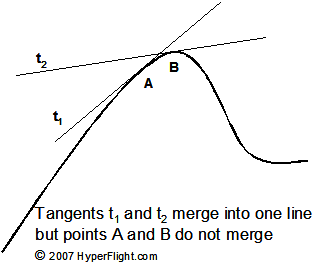
Picture filename: tangents_merge_but_points_do_not.gif
When two tangents
are approaching each other along a curve they each touch a line. In
our example there are two tangents, t1 and t2,
each touching the curve in A and B. If A and B were just single
points, we could not claim we have tangents, for a tangent needs two
points that give us direction. We cannot say that A and B
are 0D points in the strict geometric definition, so we define A- as
a point which is a part of A and, similarly, we define B+ as a point
that is a part of B. What is new is that when the two tangents merge
-- that is, when they obtain the same value for a slope, the two
points A- and B+ do not merge. The two points A- and B+,
moreover, reach the smallest possible separation (distance) that defines
the shortest possible line geometrically speaking. So, we can
actually obtain (derive) the absolute shortest possible length of a
line using geometry.
Formalizing
All along a curve,
a point A- is the leftmost point touched by t1 while B+ is
the rightmost point touched by t2. In a correction to the
science and math books, a tangent is a line (curve in general) that
always touches a curve in two neighboring points. In a
possibly better definition, a tangent is a direction of the next
geometric point a continuous curve is
allowed to have.
(Yes, Bunky, allowed by geometry.}
Where do we go
from here?
Any two points
give us direction while a single point does not. This could be
another, though technical, differentiator between a point and a line.
As for the real world -- and because geometry rules -- two atoms
would need to be separated by at least the absolute shortest distance
if these were to have and be able to apply 1D geometry. Such molecule
would then have the geometric and the computational property of a
line -- and not that of a point. My guess is that this would be the
separation of two hydrogen atoms of a hydrogen gas molecule at
absolute zero. Yes, there could be other applications. Think of
situations where you need a distance for something..
Discovery of the
infinitesimal by Newton and Leibniz isn't all that strange after all.
Tangent dy/dx is a direction we can obtain from
the smallest possible separation between two zero dimensional
points. And it is absolute, too, although each curvature has specific values.
If you want to get
into the meaning of 'continuous,' think of constructing or creating
something that is real.
Note: Also
recall that zero divided by zero is indeterminate. This makes sense
if you think of an entity subject to a construct of
'zero-divided-by-zero' and thus being or spreading anywhere
[and I mean anywhere while remaining an entity].
Note2 {Aug.
3, 2007}: A 3D surface also can have a tangent
that is a 2D plane. Can we say that such tangent plane must be formed
by at least three geometric 0D points? The answer is yes
because such tangent plane is unique and there exists but one tangent plane. |
|
 |
|
DSSP Topics for May '07
Is there more
to square besides square dancing? |
|
What's
the big deal about squares and
square numbers?
Energy of a moving
body is proportional to v2,
where v is its
velocity. We could show energy of a moving body as an energy square
(having velocity for its side) that is attached to the body. When the
energy increases or decreases as the body is speeding up or slowing
down, the square follows that. What becomes apparent is that:
(1) Energy
variations are continuous because both the rational and irrational
sides of the square are accomodated, and
(2) Because the
moving energy of ½•m•v2
is conserved then momentum is conserved because it is m•v (m
is mass). Momentum is thus obtained in a single operation via the
geometric mean even though the velocity could at times be an
irrational number. [This is about stopping moving bodies at a
distance but, as always, you are welcome to disbelieve that.]
(3) When the path
begins to curve and the distance (as well as velocity) becomes a
transcendental number, something else will have to give if the
geometric mean does not hold for transcendental numbers [and my guess
is that it does not]. Think virtual domain and possibly G. |
|
 |
|
DSSP Topics for April '07
The geometric
mean comes from a formula that relates vertical distance h
to two horizontal distances on a semicircle
Constructing a
square root from a line of any length is not obvious but it is easy
with the geometric mean
Think geometry and
get closer to the golden proportion |
|
Background
The best way to
visualize the mathematical property of 'mean' is to think of
centering or balancing. The arithmetic mean comes up when a
party of people wants to even out -- that is to center, a bill in a
restaurant. You add up all charges and divide it by the number of
people taking part. The arithmetic mean is then the average. The geometric
mean comes up when we have several lengths or distances and we want
to get their mean. The geometric mean, however, is not the average of
distances. Geometrically, the mean value of two lengths is such that
the square of the mean gives us the same value as the product
(area) composed of the two lengths (or distances).
The geometric mean
hails to us from ancient Greeks. It's a nifty relation because we can
get the geometric mean through geometry using a semicircle. (It is
said Pythagoras started his studies with a semicircle.) As it turns
out, we will not want to use arithmetic to get the geometric mean
because geometry works for irrationals whereas arithmetic does not.
We are going to start with the formula and prove it via the
Pythagorean theorem. The geometric mean is height h
shown in the illustration that reaches its max when the height
becomes the radius of the circle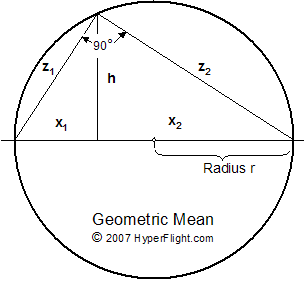
Picture filename: Geometric_Mean_Semi-circle.gif
Prove that for
any height h
on a semicircle the relation h2
= x1•x2
holds. The
Geometric Mean h is
then SQRT(x1•x2)
From the
Pythagorean theorem we can write:
z12
+ z22
= (x1 + x2)2
= x12
+ 2•x1•x2
+ x22
We can also express z1
and z2 individually
as:
z12
= h2 + x12
and
z22
= h2 + x22
Now add the above
two equations together:
z12
+ z22
= 2•h2 + x12
+ x22
The equation above
and the very first equation have the same left sides. So now we can
equate their right sides:
x12
+ 2•x1•x2
+ x22
= 2•h2 + x12
+ x22
After canceling
terms and dividing by 2, we are left with:
x1•x2
= h2
We make a quick
check for the case when h
is at its max and then h, x1,
and x2 all
reach the length of the radius. It holds.
What does it mean?
The geometric mean
shows that we can take the area of any rectangle (with sides x1 and x2)
and equate it with the area of a square. Having a square we also
have its square root, which is the side of the square and in our case
it is h.
Also, if the x1
is a unit distance and x2
is some length (or distance) then the geometric mean gives us the SQRT(x2).
Yes, in geometry we need unit length. (If you are good you can prove
that the smallest length x
is the infinitesimal of x
or dx.
If you are really good you can prove that the infinitesimal of x
is the distance between two hydrogen atoms of the H2
molecule at absolute zero.)
Okay, so the
question is: What to do with it? Or; How to apply it?
Put your brain in
gear. Could the sides of the rectangle be irrational numbers and, if
so, does the geometric mean equation hold? If it holds that means we
are multiplying two numbers with infinite mantissa and get the result
in finite time! Not a bad start, particularly since your PC or the
government's mainframes cannot do that.
Now, put your
brain into overdrive [no drugs needed] and equate z1
and x1
with the golden
numbers a and b
respectively. The golden number a
is 1+ SQRT(5) and b
is 2. Yeah, h is
the height of the Great Pyramid, a is the length (distance?)
of its side and b is one half the length of its base.
In the Quantum Pythagoreans
book we have an analysis of the Great Pyramid where the geometric
mean is prominent. See a sample.
Note {Jan
2008}: If you think the brain is
geometry-based (and it is), you could keep x1
as unit 1 and by imagining the semicircle instanly obtain a
square root of just about any number. |
|
 |
|
DSSP Topics for March '07
Cutting can be
physical or logical.
If you double
something while maintaining a symmetry about the vertical axis you
duplicate it. Would you call it a division? |
|
Background
Scientists call it
cell division but what they really mean is that when a biological
cell 'divides,' one cell becomes two cells. Cell division is really
cell duplication. We are not going to quibble about inadequate
wording, for scientists oftentimes misname things because they do not
understand it anyway. When scientists say they divide something they
really only understand that after the division you have two halves.
Last month we made a case that a photon cannot be cut or divided into
parts. That is certainly the case but this month the topic is about
another possible division; not the one that cuts but the one
that doubles.
Discussion
The
"division" that doubles reflects some object about the
vertical axes. While it is easy to see that the reflected object is
very close to the original, it becomes difficult to actually double
an object that is real. In a real object, every piece and every atom
needs to be reflected and duplicated. In the virtual domain
the duplication is easy because you are reflecting and duplicating
only the information that is on one side of the axis or a (mirror) plane.
The creation of
new or existing things happens in the virtual domain first. You will
also need geometry to establish the axis or the plane of symmetry.
Summary
So, you might
think this is no big deal. If you are heavily reality-oriented --
that is, left-brain dominant, you will have reached a conclusion that
the world is a zero-sum game. You might also think that in order to
get something you would have to take it from somebody else. Sure
enough, you will have learned more about the destruction than about
the creation, for the creation and growth happens only through the
virtual domain of the infinite. Would you be brave enough to say that:
The tangible --
that is real, world was created from an idea?
The tangible
things are secondary, in that they can be created at will?
The tangible
things we know of are not necessarily the only, or the best, tangible
things that exist?
The tangible
things can be destroyed or uncreated and dissolved back into the
virtual domain? |
|
 |
|
DSSP Topics for February '07
So you split the
photon in a half-silvered mirror. Do you get two halves or what?
You cannot cut
a photon, baby! |
|
Background
This guy Compton
whacked an electron with a photon and, because he measured a lower
energy photon, he thought that the photon got split and a part of its
energy changed the electron's path. For that he got a prize from the
Nobel committee. This might be good Swedish meatball politics but
that is not why you are here. Compton never used free electrons in
his experiments and as he whacked the atom's core with a photon, many
things could and did happen. There is a bit more on this if you put
your money on the Compton effect and got
yourself cornered. Once you understand his effect is a defect, you
are ready to look at a photon by itself.
Setup
After a photon
encounters a half-silvered mirror, it is reflected and (or?) transmitted.
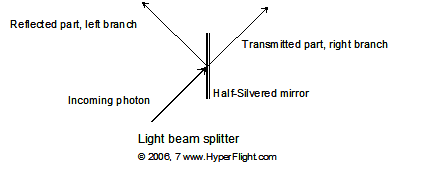
Picture filename: branch_or_split_photon.gif
At this point,
however, we do not know if the photon is:
(a)
Physically split -- that is, partitioned or cut. This would mean that
each half goes its own way;
(b)
Branched -- that is, one branch goes one way (reflected) and the
other branch goes another way (transmitted) while both branches are
interconnected; or
(c)
Reflected as a whole while the next photon could be transmitted as a
whole. This would mean that some 0/1 (or heads/tails) randomizing
action does the steering.
Experimental Results
If two photonic
detectors are placed in each of the possible paths (in both
branches), neither detects a half-energy photon. The possibility (a)
is quickly eliminated. To decide between (b) and (c),
you will need to get a bit into the instrument called the
interferometer. It measures distances along each path (in each
branch) and, if the possibility (c) is accepted, the
interferometer could not work the way it does. (More on this is in
the Quantum Pythagoreans book, including multi-path, instant
reduction, and of course gravitation.)
Summary
A photon of light
cannot be split (cut) into two individual sub-photons. A photon,
however, can be branched. Compton effect is wishful thinking by the
latter day scientists. |
|
 |
|
DSSP Topics for January '07
Global warming
got you down? Thank the scientists!
Of course, you
could put the scientist in charge of cleaning it up and finish off
this planet in a hurry |
|
Intro
Science stands
ready to explain everything and anything. BGW (before global warming)
were the good old days when we could wake up to a good cup of coffee
only to be told that coffee is not good for you. Once you got over
that, the next month's coffee would be responsible for yet another
ailment. After a while, coffee would be scientifically proven to be
okay after all. Coffee got filed in the same category as alcohol:
It's good and it's bad, it depends really, use in moderation, no
truth to coffee grinds foretelling your future but roughage is okay,
pay more for decaf, don't forget water. The bottom line: consult your doctor.
Now that we know
that all this bugaboo is about keeping doctors in business, global
warming arrives. You might even figure out you don't need a doctor.
Solution
Load up all
scientists on a ship and take them to the moon. Al Gore will lead
them. The mission, of course, is to research GW from high up. We know
ahead of time what will happen. Scientists will report that because
the moon has no atmosphere, there is no GW problem on the moon. And
then the lead scientist says to the rest of them: "Hey, let's go
back and apply our findings to the earth!" Problem solved.
Scientists on the
moon will be supplied by platforms being pushed
by lasers -- but if that does not work, well, scientists all
said it would. Once they find themselves without supplies they could
all come back (can you hear me?) by pushing the G button on that space
elevator -- it was their brilliant idea, too.
Happy New Year.
Oh, think free energy.
Note {Nov
1, 2007}: You do not need to be a scientist to see that the
greenhouse gas model for global warming is intellectually weak. Every
weatherman will tell you that on clear nights the atmosphere cools
off in less than a couple of hours and no amount of greenhouse gas
such as CO2 will slow this radiation cooling. On cloudy days the heat
stays in and, again, CO2 has nothing to do with it. Besides, you may
have noticed there is no glass in the atmosphere and without glass
the whole greenhouse model falls apart. (Glass reflects and
re-radiates some of the heat back and does not allow cooling through
air movement that is convection. Glass is transparent to visible
wavelengths but absorptive for heat wavelengths.) If you want to get
involved, work on free energy; It's bit more difficult than
protesting in the street or voting for a clueless politicial party
but it is far more rewarding.
|
|
|
|
QUANTUM
PYTHAGOREANS
A
book by Mike Ivsin

Quantum
Pythagoreans book describes and applies the real and the virtual
aspects of our environment. While these aspects are separated, the
book takes on the task of bridging the two, which leads to
organization and self-organization.
More
.. |
|
|
|
 |
|
DSSP Topics for December 2006
Wave-particle
duality really isn't about the particle
Get on board with
momentum and think big |
|
Background
Science writers
like to tell us that the reason atoms are different is because they
are small. Atomic components are small all right but that is not the
whole story. Mainstream scientists say that inside the atom things
get weird because the small size of the atomic components enables
them to unbecome classical by acquiring a wavelength -- that is,
electrons and protons cannot be treated as everyday objects the likes
of apples, billiard balls, and planets. Professors readily pull out
the equation and tell us the wavelength of an electron and then
quickly tell us that a comparable wavelength of an orange is
infinitesimally small. The orange, they say, cannot pass through two
slits and appear on the other side unsliced and unjuiced. What they
ignore is that the very de Broglie equation they use has nothing to
do with the particle's size but has everything to do with the
particle's momentum.
More Background
De Broglie's
equation is not wrong. People calling themselves scientists, however,
do not get it. The equation relates momentum p to the
wavelength lambda through an inverse relation that also
includes the Planck's constant h, that is:
p = h / lambda.
Momentum p, moreover, is a product of mass m and
velocity v. So, the equation m • v = h / lambda
deals not only with mass (or size) but also includes the particle's velocity.
The point
is that you and I can give any size particle any wavelength we want.
The point is that an everyday object, even a toaster, can acquire a
wavelength comparable to the electron inside the atom. So there. The
wave-particle duality the modern scientist talks about for close to a
hundred years is really wave-momentum duality.
Conclusion
It is easy to
speculate about the scientists and whether they are really stupid or
just pretend to be. My guess is that their herding instinct puts them
all onto a plausible and simplistic platform they each can defend.
For your part, however, you may want to get educated quickly, for the
scientist is not going to help you with real things such as the
global warming or free energy. Scientists are useless to explain
neither the perils or the opportunities -- it's all swamp gas to them. |
|
 |
|
DSSP Topics for November '06
Supernova
goes bang and it is all about the conversion of matter to energy.
What, pray say,
happened to the black hole? |
|
Background
The so-called
scientists think that sun starts to shrink and then it bounces back
in an explosion called supernova. But these guys don't bother to
explain that the energy does not add up because the sun expands to a
much greater diameter than the one from which it started. They would
like you to think it is just like a ball bouncing but do not know why
the ball bounces to a greater height than the starting one. In all,
they do not have a clue and feed you nonsense.
Discussion
There is space
between electrons and protons because these components need spatial
distance to remain in a tractable relationship -- that is, maintain
mathematically computable states. If spatial distances are reduced
through pressure or collisions, the atom ceases to remain computable
and its components disengage. But that, in and of itself, does not a
nova make.
What happens next.
Each component of matter such as the electron and the proton can be
broken up into other components that results in corrupted matter --
that is, antimatter. (Details of the mechanism, which is
conditionally reversible, can be found in the Quantum Pythagoreans
book.) The antimatter annihilation, however, irreversibly transforms
matter into energy. How much matter is destroyed at any one time then
makes the bang into nova or supernova.
What this also
means is that matter undergoes conversion to energy and cannot
accumulate without bound into such thing as a black hole. Not all is
lost for the scientist: If you really believe in black holes, have a
picture taken with Hawking and -- smile. |
|
 |
|
DSSP Topics for October '06
If you release
a body from a tower (of Pisa, say), would it begin to spin? |
|
Background
Newton defined
inertia as force that resists a change in the velocity of an object.
Conceptually it works. The ball, the bullet, the train, the ship --
all mass objects put up resistance to change from either their
present speed or their present direction of movement. (Speed and
direction could also be combined into a vector parameter called velocity.)
Discussion
If you were to
think that the property of mass inertia has some computational
intelligence, you would model it by saying that there must be a
"gyro" in there somewhere because that is one way of
figuring out something is trying to change the body's direction. You
would also arrive at a conclusion that there must be the absolute
reference because a change in speed gives rise to a force (of
inertia) that has nothing to do with some arbitrary reference. That
is, some people can be fooled but a dumb piece of the rock cannot be
fooled by an external reference that will pretend that the speed is
now different and that there is no need to put up resistance to the
change in speed. All this should be pretty clear to many and the
unfortunate part is that we are not going to try to persuade the
rest, for we are building on that and are ready to move ahead.
Does inertia
have more intelligence? Can Newton's model be extended?
If (the force of)
inertia resists the (external) force being applied unto a body, what
are other available mechanisms that would do just such resistance? If
inertia is smart, it could come up with other things to do and resist
the change to the external force even more. If, for example, the mass
body could begin to spin, the energy from the applied force is
converted to the rotational energy in addition to the linear energy.
If inertia were intelligent, it would have the body commence spinning
and resist the change in velocity even more. And that is indeed what
happens. Two bodies being gravitationally attracted to each other
speed up toward each other and in addition commence spinning to
further slow down their mutual acceleration.
Of course, there
are no limits on intelligence. Can you think of another thing that
could be done to increase the resistance (increase inertia) of a
body? Think of a "body" as a possible assembly of many
bodies and definitely think geometry. [That pancake tastes good this
morning -- wonder why.]
|
|
 |
|
DSSP Topics for September '06
If our body would
not absorb hard radiation, we could be in good shape
There is a big
difference between reflection and absorption
To reduce the
photon we need a particular context |
|
Background
Photons of light
have energy called the virtual energy. At reflection, photons impart
no momentum and, if you were to do the
experiment, you would find zero pressure at mirror surface. When
a photon reduces, however, a transformation takes place and
many different forms of real energy can arise.
Which molecule or
atom reduces X-rays and Gamma rays in your body is the place to
start. It turns out it is the atom of hydrogen inside the molecule of
water that gets whacked and that changes water into a free radical.
This is fairly recent and there is more on this in Nick Lane's Oxygen
(or in our review of
the book). Classically there is not much we can do because the photon
just slams into the molecule and some shield, it seems, would be the
only way to stop the ray. Fortunately, the truth is more complicated
but far more interesting.
The mechanism
The picture you
see below is from the Quantum Pythagoreans book. It shows the
mechanism by which the molecule of water is broken up by a photon.
The key is in two bodies (components, sub-atomic particles)
receiving momentum in the context of the conservation of momentum.
Photon is absorbed by transforming its virtual energy to real energy
(and mo is conserved). You are also seeing the creation of the free
radical, an electron-deficient (odd count) but electrically
neutral almost-water.
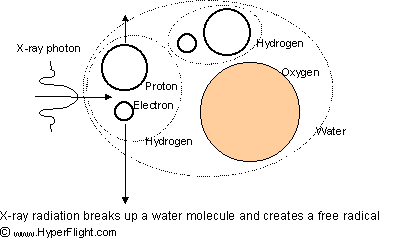
Picture filename: water_breakup_free_radical.gif
Now, how would you
or could you stop the photon from reducing inside your body:
Note1: The
ejected component (electron and proton) cannot each have more than
1/2 of the photon's energy because (you guessed it) the mo is
conserved. Does this mean that photoelectric cells cannot have
greater than 50% efficiency?
Note 2: {June
3, 2008} The photonic mechanism shown here is
not the same one that produces the HHO (Brown's gas). |
|
 |
|
DSSP Topics for August '06
Send photon
bouncing between parallel mirrors and see what happens? |
|
Background
You learned at
school that photons of light have itsy bitsy momentum and push a
mirror just a teensy weensy bit when they bounce from it. You have
this piece of information on great scientific authority, including NASA.
Then you grew up
and learned the same thing in college, except then you were fed the
equations for the actual photonic (radiation) pressure and you also
paid good money for every credit hour you were investing in yourself.
Pal,
you got the mind implants in all right
Or something
similar Arnold Schwarzenegger would say, borrowing the idea from Total
Recall.
Sorry, pal, but
you do not want to defer to the authority. You cannot just sit there
without asking questions. How many of you asked the teacher, the
professor: "But if the photon bounces between parallel mirrors,
we got ourselves a perpetual motion machine! Could you explain where
the logic fails?"
Well, your logic
is just fine. But there could be several answers coming from the
suddenly beleaguered teacher:
-
The bounces in
time stop because the photon is eventually absorbed and, you see,
there is no perpetual machine. (This is the actual response from a
scientist -- poor mirror saves bad science!) (Note: {Jan,
2007} If you go through the math and, since the light's wavelength
(energy) does not change after a mirror bounce, you will see there is
energy over-unity right after the first bounce under the presumption
that the mirror received energy and moves.)
-
Well, the photon
loses its effective mass as it bounces and slows down, you know --
just like you and I and the soccer ball
-
Theoretically,
there is a light color shift. Photons do not slow down but because
their frequency changes they have less and less of a punch
-
You got me. Light
does not impart pressure at reflection. (This is the truth but it has
yet to be spoken [but what will they teach then?])
Yet, light has
energy and light is known to move things, cut things, and vaporize
things. So where is the catch? Light can become a mover and shaker
but it first must be absorbed -- that is, transformed. At bounce
there is no absorption and there will be no pressure at reflection --
ever. At absorption the photon is transformed to real energy and the
photon is gone.
Next month we will
look at ionizing radiation and how light breaks up a molecule of
water -- the mechanism that messes up our bodies during hard
radiation. Once you know the mechanism, there could then also be a
way to counteract it. |
|
 |
|
DSSP Topics for July '06
Give object
kinetic energy but now you have to conserve it. The question of how |
|
Background
You give energy to
a stationary object or add energy to a moving object -- and you can
do this every day with the same result: the energy is conserved.
Fine. But now you have to figure out how it can be done and how it is
done by nature.
First, you
make a (good) guess that the energy you gave the object needs to be
attached to the object as a form of vibration that, however, is not
visible. You are not miffed by its invisibility. Light, for example,
is not visible unless it enters your eye and reduces at the retina.
And so you call the energy the virtual energy
Second, you
will need to arrive at some energy computational framework because
you will need to understand and explain what happens at the collision
of two objects. The wave is natural here, for waves can add and
subtract nicely just as energy can speed up or slow the object down.
Third, you
will figure out the granularity at which these energy waves operate.
You will quickly settle at the atom, giving preference to protons and neutrons.
Finally,
you get all excited because the wave could be conceivably imparted at
a distance and psychokinetics, if amplified, could be applied to stop
moving bodies at a distance.
By the way,
increase in momentum changes the energy waves within the atom and --
if the core is unstable (radioactive) -- its half-life will be
impacted. You just came up with the mechanism that explain the
increase in half-life as the object's speed increases -- and
absolutely at that. |
|
 |
|
DSSP Topics for June '06
New Australian Star
What it means and
where it comes from |
|
Background
Australians are
looking for a star to call their own. It is important to them, of
course, and the discourse is par for the course. The Australians may
be looking deep into their soul and they will want to ask the
aborigines for advice as well. The eight pointed star may be a
favorite of some, but there are eight pointed structures that are
harmonious and there are the eight pointed stars that are
disharmonious. There is also a question of the meanings of the
horizontal, vertical, and the diagonal.
So, here is our
contribution: The New Australian Star issues from the constellation
of the Southern Cross. Each star of the cross now enlarges into arms
that form two sets of diagonals. One set has the right triangle in
the 3:1 proportion, which produces the diagonals of the square root
of ten. The other, closer-together stars on the horizontal produce
triangles in the 2:1 ratio, which produces the diagonals of the
square root of five. The point to be made is that the diagonals
should not be obscured by solid structures because the diagonals are
about vibrations. Spirals or waves can be pretty much anywhere, for
these get along with vibrations just fine.
The Australians
will need to figure out why there are two separated lines for both
the horizontal and vertical direction. The (big) hint comes from your
bones, which have "empty" space. (The Great Pyramid also
has empty spaces, really virtual structures, that some people call
"shafts" but they are axes for vibrational formation.) Enjoy.
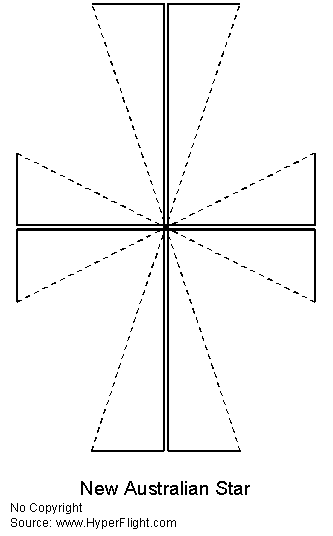
picture filename:
New_Australian_Star.gif |
|
 |
|
DSSP Topics for May '06
Are irrational
numbers not rational -- that is, not reasonable?
If irrationals are
not reasonable, does it make them bad? Is "wow" bad?
If you truncate
irrational number, did you solve a problem or did you create one? |
|
Background
The best
example of an irrational number is the square root of two, but
sticking to arithmetic to discuss irrational numbers quickly runs out
of steam. This is because irrationals issue from geometry and not
from the everyday experience of counting. How many times did you need
a square root in a restaurant? If you need to deal with space,
chances are quite good you will deal with the square and the square
root of two.
We all know
that the diagonal of a unit square is SQRT(2).
Unit square's side is 1, but if your square happens to have
the side of length b, then the diagonal is b·SQRT(2).
Either way, the diagonal is a number that has an infinite mantissa.
This is "no problem" for scientists because they just chop
it off -- just at the point where it would not fit in the computer --
and declare it, say, close enough.
There is no
need to lament over the chopped off number but what has happened is
that the irrational number was converted into a rational number by
being chopped. Chopped number now becomes a real number because it is
finite and the act of chopping transforms the irrational number irreversibly
into a real number.
The subject of
this month's topic is number chopping -- or rounding or truncation.
How many decimal places do you need? Is there a point where the
chopping of the irrational number is good enough? In other words, is
there "close enough" that would make it "good enough?"
Example
Take two
squares as shown here. Which of the two do you like better?
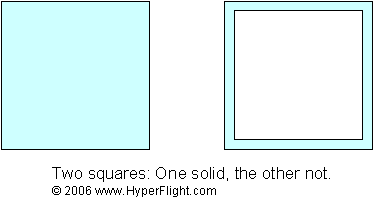
picture filename:
two_squares.gif
-
If you were to
explain why you like one square or the other, would you use different
words for each?
-
If you were to
change your mind about the square you like, would it reflect
different ways you are perceiving the liking of the square and
the explaining of liking it?
-
What do
irrational numbers have to do with any of this?
In Summary
The square on
the left is a solid square and reflects the truncation of the
irrational number. The diagonal distance of the solid square is exact
and finite. The diagonal of the non-solid square is open and there is
no limit on the expression of the irrational number of its diagonal.
Both squares
will be described differently [think left and right brain]. It is for
this reason that the truncation of the irrational number does not
have a measure of adequacy. The irrational number is in a category of
its own -- a category that requires the mantissa of the irrational
number to be infinite. As a Pythagorean you know that a number can
become, and the act of number (mantissa) chopping does not actualize
the irrational number. As a Pythagorean you know that if the Good
Lord carved a square as a groove into the stone it would not and
could not glow.
Throughout
this topic you could substitute 'incommensurable' for 'irrational.'
In that case the transcendentals are included along with irrationals
in this month's topic. |
|
 |
|
DSSP Topics for April
'06
You were told
the photon knocks the electron off its path but what happens to the photon?
Okay, if photons
could move other things without being absorbed, where do the tired
photons retire?
The absorbed
photon may create heat but what happened to the photon?
What happens to
the photon that we see and register as light?
How is a photon (re)created? |
|
Background
Scientists
tell us all about the interesting things photons do but they don't
tell us what happens to the photon after it does its thing. Chances
are good scientists do not know. Even the so called 'Compton effect'
erroneously presumes that a photon pings an electron and loses
energy, but the scientists' brain is so limited they cannot conceive
what would happen after the second, third, and the next
"collision" because then the answers do not come out as
readily. If we take scientists up on Compton -- who is fortified with
the Nobel something or another -- then the world would be full of but
beaten up and tired out photons zombily clunking their way around.
The fact is, scientists cannot think beyond the second bounce. Inside
the scientists' mind it is not unlike the proverbial Johnny Carson
fruitcake -- the next fruitcake you see is the same one you sent to
somebody else.
Actually,
Photons cannot
and do not bump and displace electrons because photons and free
electrons are both waves. Photons are created with a fixed amount of
energy that stays with the photon for the life of the photon. That is
also why a reflecting (or refracting) photon cannot and will not
create pressure at reflection.
When a photon
is absorbed, its energy -- which is also a virtual energy --
transforms into real energy, but only if the photon finds two
things to bump into. Two things are needed because two things can
then move in the opposite direction while conserving momentum. So
there, Compton, you can "bombard" free electrons with
photons all day long but none will change its path. Scientists can
bombard us with Compton's Nobel Prize but that will not impress the
mind of those who ask simple and obvious questions.
Systemic
The photon
needs systemic description -- that is, the photon exists in a cycle
from its creation to its absorption to its recreation. Once a photon
is absorbed it is transformed from the virtual and into the real
energy and the original photon is gone. Photon's energy lives on in
another form.
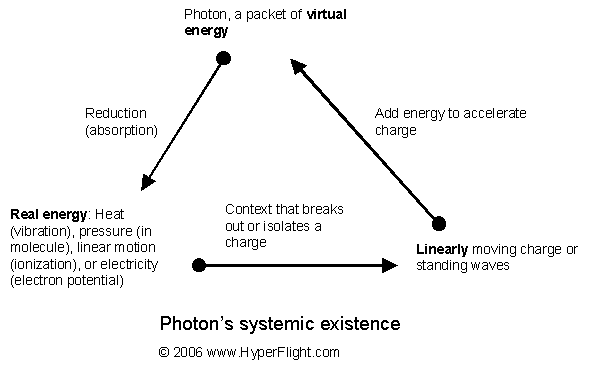
Picture filename:
photon_systemic_existence.gif
Creation
A photon is
created when a charge is accelerated. For one reason or another the
charge does not keep its energy the same way a real particle such as
a piece of the rock does. As long as the charge is not accelerating,
no energy -- in the form of the photonic virtual energy -- is being
produced but as soon as the charge becomes accelerated, the charge
begins to radiate virtual energy that is the photon. For your
homework, you want to figure out what geometry of the atomic
electron does not accelerate the electron's charge. If you like
homework, recall that thoughts in your brain are charges (potassium
ions?). Does this mean you could create photons in your head? [What?]
Note{4/13/06}:
If a scientist suggests that light can also increase in frequency as
it collides with bigger things such as molecules, the scientist is
again not thinking past the second bounce. If a photon were to
acquire higher energy as a result of hitting something bigger,
photons around us would be in the X-ray region very soon. Again, the
photon's energy does not change during non-reducing interactions such
as reflection. |
|
 |
|
DSSP Topics for March '06
Flip over
hydrogen and get helium -- introducing the Inclusion Principle
Who supplies the mirror? |
|
Background
Pauli noticed
that the two of helium's electrons always have opposite spin and he
quickly called it the "exclusion principle." In the early
and QM-heady years of the last century, everybody was getting in on
the act by naming things, and since nobody observed the two of the
helium's electrons to have the same spin, Pauli just said -- without
rhyme or reason -- that that's the "principle" and no
explanation is necessary. Bohr did something similar when he could
not explain the discrete quantized atomic orbitals that matched
Balmer's equation: he called the space between orbitals the
"forbidden orbitals." Geez. It is not unlikely Bohr
happened one day to walk by the sign saying 'Swimming Forbidden' and
that was good enough for him -- forbidden it is. Why, Pauli has it
even better. If a new quantum number is discovered, as when the
magnetic field split the hydrogen orbitals some more, it all
continues to fit the "principle" because each electron gets
a new extra quantum number. Pauli's exclusion principle does not
explain anything and does not predict anything -- it is self-defining
and it fits after the fact. You can make your own principle such as
the "human water exclusion principle." When there are no
humans living under water just like the fish, your principle is good.
If you scratch your head on this, the best way of thinking about this
high science is that each atomic particle gets its own set of rails
and no particle can then collide with another particle. This is the
best invention since, but of course, the railroad!
New Proposal
Then again,
the real question deals with explaining why the two electrons of
helium have opposite spin. The mirror symmetry makes it possible. If
there exists a two-dimensional symmetry (symmetry about a plane), the
reflected clockwise spin of one electron becomes the counterclockwise
spin of the other electron. The way of creating helium out of
hydrogen is to include the second electron and also the second proton
with the plane symmetry. So, you see, it is really the inclusion principle
that is at work here, for the idea is to grow helium from hydrogen by allowing
new components by rules such as symmetry that makes sense
computationally or geometrically. And the only way of including a new
component across the mirror plane of symmetry is to reverse the spin.
(That is how your left hand becomes the right hand on the other side
of the mirror, too.) Now, we can make a prediction using the new
principle: the spin of the second proton inside the helium core will
have its spin reversed as well.
Thinking Big
The mirror of
symmetry exists because it simplifies the computational aspects
within the atom. The next question deals with "where is the
doubling of helium" manifesting -- and this is perhaps worth
some study. The doubling could be on the molecular level -- for
gasses anyway. It is apparent that the doubling cannot go on forever.
All computability concepts reach limits such as the octave for the
outer orbitals, which may need additional computing geometries in
addition to two-dimensional symmetry. Whether the plane symmetry of
helium is linked in some way to the angular momentum and the flat
geometry of the solar system is a big jump, but awfully tempting nonetheless.
Note{May
5, 2006}:
Balmer is the guy who tied quantum behavior of the electron
to math, constants and all. Can you tie Balmer
to the King's Chamber, atomically speaking? |
|
 |
|
DSSP Topics for February '06
Golden Ratio is
not exclusive to Fibonacci numbers
The key is in the
infinite addition (read superposition) mechanism |
|
Background
Fibonacci
series starts with numbers 1, 1, and each consecutive
term is formed by adding the previous two terms. As the Fibonacci
sequence unfolds, the ratios of two consecutive terms of the
Fibonacci series converge closer and closer toward the value of (1+SQRT(5))/2,
which is the Golden Ratio and expressed as ratio of two numbers a/b.
We do not want to reduce a/b
any further and so a=1+SQRT(5)
and b=2.
Fibonacci series acquired some mystique because of its Golden Ratio
convergence property, a property discovered by Kepler.
However,
It turns out
that any
numerical series having the next term generated by summing the last
two of its terms will also converge toward the Golden Ratio by
rationing the two consecutive terms. The mathematical way of saying
it is that the convergence is not a function of the initial
conditions. The general proof is straightforward. We start with two
numbers representing some positive lengths, say j
and k.
The next term is, by definition, the sum of the two
S0
= j + k
All partial
sums Sn contain numbers j and k.
Next terms are:
S1
= S0
+ k
S2
= S1
+ S0
.. ..
Sn-1
= Sn-2
+ Sn-3
Sn
= Sn-1
+ Sn-2
Now, the Sn/Sn-1
ratio should converge toward the Golden Ratio a/b
if our hypothesis is correct. Then, as n
increases toward infinity
a/b = Limit of Sn/Sn-1
Substituting
for Sn
a/b = Limit of (Sn-1
+ Sn-2)/Sn-1
= Limit of (1 + Sn-2/Sn-1)
a/b = 1 +
Limit of Sn-2/Sn-1
Expression Sn-2/Sn-1
is a ratio of two consecutive but inversed terms and, as n
increases toward infinity, the ratio converges toward the reciprocal
of a/b, which is b/a. Then,
a/b = 1 + b/a
This equation
is not a function of any partial sum Sn
and, therefore, a
or b
is not a function of j
and/or k.
Any value of j
or k
can be used in the construction of the series that results in the
equation a/b = 1 + b/a.
Finally, does a solution exist for a/b?
a/b = 1 + b/a
Multiply both
sides by a/b
(a/b)2
= a/b + 1
(a/b)2
- a/b - 1 = 0
For positive
solution of spatial distance:
a/b = (1 + SQRT(5))/2
a = 1 + SQRT(5)
and b = 2
Notes
(1) So
what's the point in generalizing a particular sequence while
"demoting" Fibonacci and his cool sequence of numbers? A
lot, if you think Golden Ratio is in some ways related to free
energy. One could -- but does not have to -- work with structures
that subscribe to Fibonacci.
(2) As
a Pythagorean you always know the operational representation in
nature, and addition or subtraction is about the superposition of the wavefunction
(3) {Feb
10, 2006}
This month's topic has a great implication for the number zero. Some
people include zero in the Fibonacci sequence and that works fine for
addition (superposition of the wavefunction). As soon as we get into
ratios, however, zero needs to be excluded. We start Fibonacci
sequence with 1, 1 to avoid the exception but -- if we were to
generalize -- zero can be included as a real number as long as it is
subject only to addition. Only virtual numbers can be subject to
infinite acceleration, which is none other than the instant light rebound. |
|
 |
|
DSSP Topics for January '06
Particle-wave
duality started with deBroglie a hundred years ago, and it is still
making waves
Particle-wave
duality may seem weird, but only if the interpreter does not see the picture
Particle-wave
states are mutually exclusive and, for this particular
transformation, reversible
Finally, the
correct way of saying it is 'momentum-wave' duality |
|
Background
It started as
a purely mathematical relationship in deBroglie's head. Momentum,
which is a moving energy of a real thing, could be equated with
frequency, for frequency also relates to energy. On the one side of
the equation is mass and velocity -- that is, momentum p, and
on the other side is frequency f and Planck constant h.
Altogether it is p = f·h. What holds this relation
together is the conservation of energy. The conservation of energy
states that energy can be transformed from one form to another, but
the overall energy cannot increase or decrease.
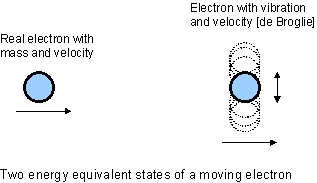
Picture filename:
particle-wave_duality.gif
If it
transforms then it must be exclusive
In the
framework of the conservation of energy, for every bit (quanta) of
energy on the left side, there will transform an identical amount to
the right side. As a result, the electron cannot be both a particle
and a wave because the electron either transforms or does not
transform. A moving particle's energy (that is, a momentum) and a
wave (wave is the reciprocal of frequency) cannot exist
simultaneously. If you wish to do an experiment, you will be able to
measure momentum or a wavelength but not both at the same
instance. So, if you bind an electron as a real particle, it will not
do the wave tricks going through the dual slit, for example.
The most
potent question since day one concerns the parameter of mass of the
moving electron. If we could detect -- that is, measure, electron
waves, we do not need (to know) electron's mass, for the energy is
conserved and the conservation of energy is upheld by the wavelength
measurement alone. Moving free electrons do indeed have
wavelength and the wavelength was measured and validated by Davisson
and Germer in 1927. This outcome is at the center of the "quantum
weirdness" because mainstream scientists hold on to the
electron's mass at all times. Even though mass is not needed because
the conservation of energy holds without it, the present mainstream
science guys -- really all of them: Feynman, Hawking, Wheeler,
Penrose .. -- hang on to electron's mass as the last straw the
classical mindset wants to take along to the domain of quantum
mechanics. You cannot, and in a way you do not want to, take mass
with you to the virtual domain of quantum mechanics. [If you do hang
onto mass, you will never get there. Of course, if you cannot go
there you may as well hang on to mass.]
In the picture
above, then, the mass of the electron on the right hand side is
really not there and the mass of the electron dissolves and
"disappears." The good news is that the transformation is
reversible and the electron reappears upon measurement. The
measurement is at times called the reduction or the collapse of the
wavefunction, and in actuality it is the transformation going from
right to left. The particle must be moving to have momentum and thus
enable the transformation into a wave. The transformation of the
particle into a wave and vice versa is a 'momentum-wave
reversible transformation.' If you were to get deeper into this,
consider the following:
(1) The
movement of the particle is about momentum and about imparting energy
onto a particle -- particle does not need to carry charge, etc.
(2) The
'wave of a particle' deals with the conservation of energy and manifests
through the wave's property of nonlocality.
(3) The
conservation of energy is absolute. Energy is local to the particle
and -- on the other side of the transformation -- nonlocal with the
wave [happy tunneling in the New Year.]
Are there some
transformations that are not reversible? Yes, the
"celebrated" E=mc2 is not reversible. The
transformation of momentum is reversible but the transformation of
mass (matter) is not. (You will need intelligence in addition to
energy to make matter.)
There is no
need to chastise mainstream scientists even though they do not get it
for one hundred years. Just let them know that whatever ideas they
have, they are not coming back.
Finally, if
you like this topic, give QM
primer a read. |
|
 |
|
DSSP Topics for December '05
Say hello to
Balmer, just another cool math guy
King's Chamber
in the Great Pyramid beckons to Balmer |
|
Background
In the last
quarter of the 19th century, Johann Balmer (taught math in girls'
school where he) came across the experimental findings that hydrogen
radiates light of only certain frequencies. The quantum aspect of the
radiated wavelengths intrigued all. Many math guys set out to come up
with a formula -- we can say in the tradition of Kepler -- to match
some equation, any equation, with observations. Balmer succeeded by
making the wavelength lambda = b·m2/(m2-n2).
Number b is a constant (could be called Balmer's constant)
and contains the Planck constant h, which was not proposed for
another fifteen years. Numbers m and n are integers
while m is always greater than n. The observed
wavelengths matched the formula and Balmer also successfully used the
formula to predict other hydrogen wavelengths that were unobserved at
the time. Balmer thus tied natural numbers (positive integers) to the
atom and Pythagoras suddenly became relevant on the atomic scale.
Moreover, the
Pythagorean theorem should by now jump right out at you, just as soon
as you see the m2-n2
term. This term is about two lengths of the right angle triangle.
(Bohr's formulation includes Planck constant but the geometric
relations are not apparent.) Balmer's equation is in the simplest and
visually powerful format.
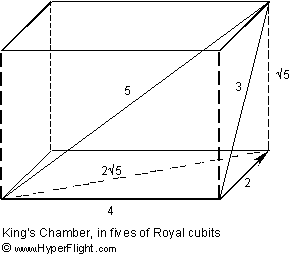
Picture filename:
kings-chamber-proportions.gif
It is now
becoming apparent what you need to do when you want to work the
atomic orbitals. One ingredient is missing, but the King's Chamber is
but one component of the Great Pyramid.
Among the many questions:
Is the 'squaring of the circle' about building orbitals from linear,
or straight, components? If so, what's the big idea? When we
mutilated the Great Pyramid, does it show that the creation could
never be as intelligent as the Maker? Is operational pyramid
existential? Can we, could we, would we, shape the stone without
hammer or heat? |
|
 |
|
DSSP Topics for November '05
Lightspeed is absolute
A photon of light
leaves its source and propagates at 'c' in the direction the source
is pointing
Velocity of the
light source cannot slow or speed up light
Velocity of the
light source cannot give light a sideways speed component |
|
Background
Michelson-Morley
experiment has shown conclusively that a round trip of a photon is
of the same duration regardless of the direction the photon is
launched and regardless of the velocity (speed and direction) of the
launching platform. Presently, however, the prevailing -- that is
mainstream -- understanding is that the sideways velocity component
of the launching platform is added to lightspeed. It is asserted that
light's forward velocity is c and constant, but if the
launching platform (the source of light) has an additional, say
downward, speed then such sideways speed is added to that of
lightspeed. Not so.
Agreed:
The launching platform (light source) does not and cannot add its own
forward or backward speed to that of lightspeed. In other words, a
light source such as a flashlight or a laser moving forward or
backward does not affect lightspeed and light coming out of the laser
is always, and for all observers, propagating at c.
However,
and incorrectly, the light source "is allowed to" add its
own speed that is in direction other than the light's direction. The
flashlight, then, does not add its forward or backward velocity
component but "is allowed to" add its sideways component to
that of light. There is no good reason why the velocity of the light
source not be additive to light in the parallel direction, but be
additive in another direction.
Furthermore,
the Michelson-Morley experiment directly proves that the earth
velocity -- being introduced as the forward or the sideways
component -- is not and cannot be added to lightspeed.
Michelson-Morley apparatus as a whole was rotated to release light
parallel with, or perpendicular to, that of the earth velocity, but
no change in light's arrival was detected. Regardless of the rotation
of the apparatus, light's round trip delay was always the same.
Michelson-Morley apparatus was purposely designed with enough
accuracy to measure the change in light's arrival if earth velocity
was added in any which way to lightspeed -- and the expectation of
the experimenters was that they will be able to measure the delay in
arrival. The earth velocity, however, was not and cannot be added to
lightspeed in either the parallel or the perpendicular direction (and
anywhere in between).
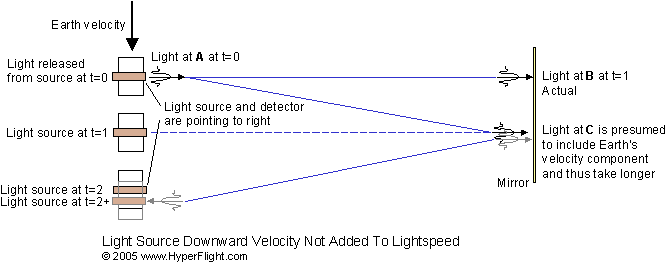
Picture filename:
lightspeed_independent.gif
In the
illustration above, two candidate paths of light are traced while the
light source is moving down -- that is, perpendicular to light's path
(and along with earth velocity). Trace AB is the actual trace
because the Michelson-Morley apparatus did not measure any delay in
light's arrival. The physics theories of Einstein ignore
Michelson-Morley experimental results and claim that light takes the AC
path. Not so. Light always takes the AB path, which is the
path that is in the direction the light source is pointing at the
instance of light's release. Lightspeed is absolute and independent
of the speed or direction of the light source that releases
the light. Space, and whatever 'space' is, cannot and does not treat
light differently as a function of direction.
Note
that, as the sideways light source velocity keeps on increasing, the
detector will at some point miss the returning light (photon) -- and
this is yet another way of confirming that the velocity of light and
its source is not additive in magnitude or direction.
Finally,
Einstein's general theory of relativity may be a hopeless artificial
theory, but the idea of the absolute lightspeed lends itself to
building the absolute clock. That is, the clock as a whole may be
traveling fast or slow, but because its timing component is built on
lightspeed (rather than on the unstable and decaying matter), the
clock's ticks will be absolute. We have the design for the absolute
clock. The absolute clock then also resolves "the
issue" of simultaneity, for observers can
use the absolute clock to synch their watches -- absolutely.
NASA projects
whose primary mission can be directly invalidated through the
Michelson-Morley experiment are gravitation waves, gravitational
lensing, and black holes. Other NASA projects would also change their
focus because the present theories would no longer be in line and
supportive of the project, i.e., dark matter, dark energy. Solar
sailing efforts are based on the nonexistent light's pressure, which
are addressed in topics about
light. The "Space Elevator" spending may be relatively
low, but what is high is NASA's travesty of High School physics that
is sending a corrupting message to our kids. See below. |
|
 |
|
DSSP Topics for October '05
"Space
Elevator" is NASA's example of not understanding basic physics
and math |
|
Background
NASA has no
leadership -- both managerially and scientifically. This is most
likely due to NASA being a US monopoly. In the US, NASA leads in
mattress materials and that's about it. On the world scene, however,
NASA deficiencies begin to show, for no longer can NASA dictate the
space spending of other countries including Japan, Russia, European
Union, China, India, and possibly Canada. Solar sailing is an example
of unworkable and PR-driven technology, and any country that has
validated the fact that light (photons) cannot put pressure on mirror
can laugh-out-loud at NASA stupidity.
This month we
take on NASA's "Space Elevator" once again, for this
structure will never work as advertised and will always require
active rocket propellant with each and every payload. This fact is
easy to establish with High School or introductory college math. It
is about the angular momentum that is conserved, and no payload can
be hauled into an orbit without giving it additional angular momentum.
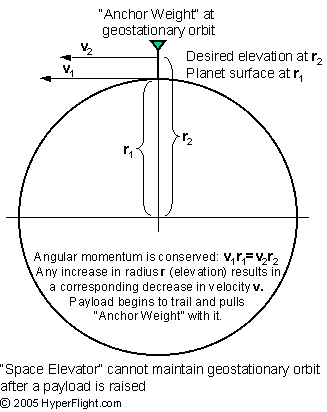
Picture filename:
angular-mo-elevator.gif
As the payload
is being raised from r1 to r2,
it begins to trail because its orbital velocity is decreasing with
increasing elevation. This puts a sideways pull on the rope, which
then pulls the geostationary "anchor weight" from its
position. The end effect is that the rope will break or the
"anchor weight" will be pulled down to earth -- there is no
in-between. This effect is similar to the breaking of the payload
tether from the NASA space shuttle experiment a few years back
because the angular momentum of the shuttle was not changing but the
angular momentum of the payload was.
Fundamentally,
linear and angular momentum can be exchanged only through
transformation. Classical mechanics deals with it by separating the
linear and the angular momentum -- that is, the law of the
conservation of momentum applies individually and separately to the
linear motion and to the angular (orbit, orbital, spin) motion.
As for recommendations,
there are none. NASA is so ignorant of its own lack of merit and
there will be no changes forthcoming as a result of our posts. NASA
has a closed shop mentality and their contracting practices are not
only unfair but outright insulting. In time, however, it will be
easier to split up or eliminate NASA because of our posts.
Note {Oct.
6 and 22, 05} When an object is moving in a
straight line and comes in proximity to another (larger) body, it
begins to orbit it. Linear momentum has changed to the angular
momentum. So, how come that a payload being hoisted straight up needs
rocketry to get angular momentum? Without the sideways-firing rocket,
the payload being hoisted up the "Space Elevator" acquires
the angular momentum by taking it away from the Elevator's angular
momentum -- and that's the only way of conserving momentum. The
payload being hoisted up can be visualized as as follows: by moving
(walking) from the inside to the outside of the merry-go-round, the
angular velocity (rotation) of the merry-go-round will decrease. This
is okay for the merry-go-round but the "anchor weight" will
tumble down or, if the tether breaks, the "anchor weight"
will move into a lower orbit that is no longer geostationary.
Note#2 {Jan
6, 06} The latest NASA spin on the space
elevator is to put the anchor weight beyond the geostationary orbit
and thus keep the tether tight. This appears to muggle the
discussion, for tightness is supposed to invoke the image of 'rigid.'
Tight tether is not rigid to torque, however, and the first load that
is being hoisted up will take the angular momentum from the
"anchor" weight just as before. The not so amazing thing of
this NASA in-your-face-fraud-in-progress is that they do not offer
computer simulation. This is simply the 'tow the line' political
project that will go on for as long as the funding holds and
regardless of the technological corruption this endeavor carries in
its wake. It is also likely that the "damn the physics"
approach will negatively permeate other NASA projects, for technical
merits are taking second seat to PR or the power to lie. Politically,
NASA does not want this project to go to completion because it will
not work anyway, and we should expect "technical problems"
or "budget priorities" several years from now as
explanation for the cancellation. Makes you wonder if the shuttle was
not flight worthy and NASA knew it.
Note#3 {Jan
1, 07} NASA is mouthing away trying to keep
this project in the budgets. The new year spin of 2007 is that NASA
agrees that the angular momentum needs to be supplied to the load but
that "the earth will supply it." This goes way beyond 'duh'
and even beyond the tower of Babel. The tether is not a rigid rod and
the torque will not be delivered to the load. When going up the
Eiffel Tower (or the Tower of Babel) the tower will supply the
angular momentum to the climber but only because the tower is a rigid
structure. Names of NASA officials and NASA scientists should be
taken for likely criminal prosecution -- that is our latest and the
best recommendation. |
|
 |
|
DSSP Topics for September '05
Time is always
a dependent variable
Pythagorean says:
Time is a derivative
Buddhist says:
Time is obtained by convention
Hollywood says:
Time machine, yo baby! |
|
Background
Time keeping
and record keeping has been with us so long we take time as something
that exists as if time were a variable having its own existence.
Planetary position can be forecast by time alone, but the value of
stocks or the parameters of weather cannot. Scientists stay away from
relationships that cannot use time for prediction and, for better or
for worse, developed only those elements for which time-dependent
equations exist. The scientist cannot use time going backward and
calculate the value of a stock one month ago, but scientists do not
mind telling those who listen that they can go back billions of years
and arrive at "the beginning of time." The scientist cannot
go back in time and validate, among millions of things, where a
person was a week ago, how much change he or she had in their pocket
yesterday, and what weather parameters we had in Boston the first of
August. Without the actual minute by minute record, the only way the
scientist can compute where a runner was during the race, the poor
runner is confined to a particular track running at a particular
constant speed. The runner cannot speed up or slow down because the
scientist would not be able to reconstruct the position of the runner
on the track.
Your clock
is as good as the system that derives it
Each and every
clock has a system behind it that derives the time. The calendar time
comes from planetary motion. "Atomic" clock comes from
unstable matter that decays at certain rate but such rate varies as a
function of temperature, pressure, and -- perhaps not surprisingly --
velocity. Light or laser clock can derive its timing from the
constant velocity of light and its time is then not dependent on
velocity. Regardless, there is no time as a standalone variable
because different systems produce their own time. When a system from
which time issues is changed, the time follows. It is not possible to
manipulate time by itself and, for example, change the orbit of a
planet. That is what it means that time is always
a derived variable where the always
part means that the dependency is not reversible and time can never
become an independent variable. Actually, you can try an experiment
on yourself: slow down your watch and put it in your pocket --
perhaps you will live longer. Time, then, will accept the strengths
and limitations of the system from which it is derived, including
being the absolute time if derived from
light's constant velocity.
Variables
are usually reversible as to dependency. Time is not
Scientists, of
course, are free to fool each other. Scientists can take decaying
matter and put their money on that but everybody else understands
that the derivation of a particular variable may not be reversible.
An object casts a shadow which may indicate the position of the
object, but it is not possible to move the shadow by itself and thus
cause the object to move. There exists a one-way causal relationship
between the object and its shadow in the same way there is a causal
relationship between a system and the time that is issuing from such
system. This particular relationship between the system and its time
(or object and its shadow) is not reversible.
Variable's
reversibility is fundamentally tied to transformations
The next part
is about the reversibility of mass and energy. Scientists would like
to think mass and energy are reversible but they can only talk about
it with their hands in their pockets because nobody succeeded in
taking some photons and making mass out of it. The scientist, not
unlike the five year old, can break matter into matter and
antimatter, but they have no clue, and presently do not care, how to
make a real matter, and perhaps new matter, and possibly even
different matter. |
|
 |
|
DSSP Topics for August '05
When light shifts
toward red or blue, it confirms the change in speed in absolute terms
'Refraction Shift'
is more descriptive than 'Light Shift'
Photon's energy
remains the same
All of the above |
|
Background
An object
emitting certain color may be at some spot in the universe but if the
detector moves toward the object, the color of the object will shift
toward blue. There is symmetry in this phenomena and if the detector
is moving away from the object, the object's light will shift toward
red. The object's color, however, does not and did not change.
Fundamentally, your eye will register the identical color regardless
of the speed you are moving toward (or away from) the object.
Physically, the 'light shift' refers to the increased refraction of
light as light enters the prism of the detector. The color -- that is
the inherent energy of light -- does not change, but light enters the
incoming prism faster and refracts along a path that is usually a
path of different color. With your eyes as your detector, the colors
will remain the same but will become slightly out of focus.
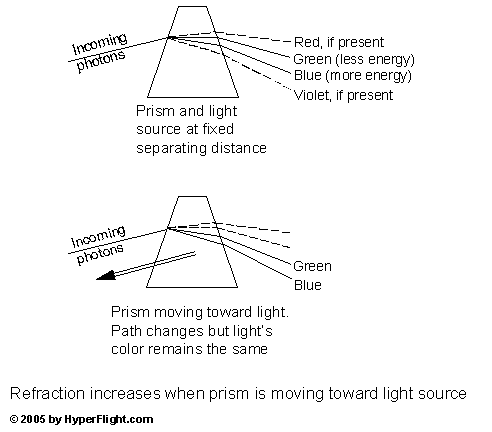
Picture filename:
prism_moving.gif
When the
distance between the light source and detector remains the same, no
refraction shift (light shift) could ever be detected. Therefore, the
absolute calibration can be achieved in the laboratory and a prism
based detector can map any and all energies (colors) of light in
absolute terms. Refraction shift is a great mechanism that is worth
exploring and exploiting. The next step is to pick the best colors
available from cosmos. Balmer's hydrogen lines have much potential.
For example, if the refraction shift changes with seasons but always
returns to the same value then a solid conclusion can be reached that
the interplanetary hydrogen is stationary, and absolutely so. Now,
Earth's velocity can be calculated in absolute terms and, therefore,
any other object's speed could be known in absolute terms as well.
Note
Refraction
shift is a fairly complex phenomena that calls for differentiation
between energy and light's property of refraction. Yet, the
information presented this month is adequate to take on any and all
warp brains that could be out there. For example, you could make a
successful case that the energy of the photon is absolute because,
regardless of the speed of the source or the detector, the photon's
energy remains the same.
{Aug 2, 2005}
Another way of appreciating the differentiation between the
refractive attribute of light and the energy of light is by taking
prisms with different indexes of refraction. Each prism will refract
the same light differently but the energy of light going through any
of the prisms and leaving the prism will remain unchanged. The prism
separates photons based on the intrinsic and absolute energy photon
has even though the separation distances between colors may be different. |
|
 |
|
DSSP Topics for July '05
Relativistic
presumption is presumptuous.
Energy of a body
stays with the body but the change in reference "takes it"
away and "gives it" to another body: Cannot take and give
energy through reference alone and all energy references are and must
be absolute |
|
Background
The
relativistic presumption has been with us for 100 years. It was built
from the everyday observation that a watermelon being struck by a car
causes just as much damage as when the car is parked and the
watermelon is thrown at it. People calling themselves scientists
extended this simple observation to the entire universe. This
happened even though Newton could not appreciate imparting energy to
an object and then removing the energy at a whim of shifting the
frame of reference -- shifting the reference disregards energy
conservation because energy was indeed imparted onto a particular
body and not on another body. Scientists were able to go mainstream
with the relativistic mindset by saying "it's the same
thing" and made relativistic presumption into relativistic postulate.
It may be time
to look at the relativistic presumption again because the dual slit
experiment proves that the frame of reference placement is not
arbitrary. In other words, the energy of every individual body must
be respected
in absolute terms.
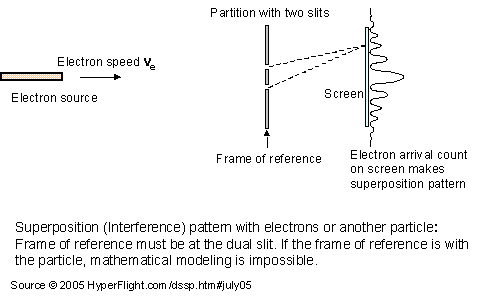
Picture filename:
dual_slit_absolute_energy.gif
Every moving
particle has a wavelength that is commensurate with the moving energy
(momentum) it was given. Greater momentum gives the particle more
moving energy and shorter wavelength. Indeed, the ability to
mathematically calculate the superposition (interference) pattern is
one of the fundamental victories of quantum mechanics because it is
the wavelength that is being used in calculations. Moving electron
has momentum (velocity) and this translates, through Planck constant,
into wavelength. See Louis de Broglie for details.
In the dual
slit experiment the particle is released from its source at zero
velocity. The particle is then speeded up with particular amount of
energy and acquires velocity ve
-- and that is why the frame of reference must be at a spot that
recognizes the velocity ve
particle acquired. If, for example, the frame of reference is shifted
to the electron, ve
becomes zero and the wavelength associated the the particle is now
different (zero). The particle, after the frame of reference change,
has no wavelength because it has zero velocity and the mathematical
result does not match what is being observed. Moving the frame of
reference corrupts reality.
Exercise
|
|
 |
|
DSSP Topics for June '05
The first test
of mathematical soundness: Is the solution tractable? |
|
Background
The math guys
make two things quite clear. The first is that any math is good math.
The second is that math operators we use presently, such as addition
and multiplication, are complete and adequate. The first one is
so-so, the second is not so. What complicates things a bit is that
some operators such as square root are tractable in geometry but
intractable in arithmetic.
The best
example of the mathematical intractability pretending to be a
solution arises with the dual slit experiment performed with
electrons. The path each electron takes is by some modeled as
"sum over all possible paths," or "sum over all
possible histories." Mathematically, however, this model leads
straight to the intractability that is analogous of the traveling
salesman problem. Unfortunately, intractable solutions continue to be
proposed even though no computer can execute such solutions in real-time.
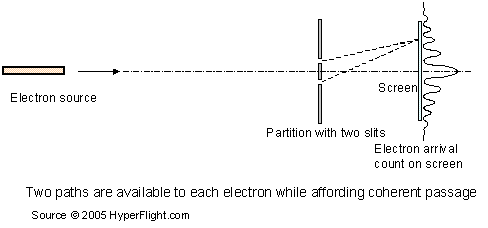
Picture filename:
electron-interference_2slit.gif
One 'left
brain' model that describes the dual slit experiment with electrons
is based on the presumption that the electron cannot be split. (If
the electron cannot be split with a hammer, it cannot be split --
that's the rationale.) This, in turn, ushers in the intractable model
of the traveling salesman problem because the experimental results
call for the electron to also go through both slits and then the
electron's path needs to be tracked in every possible way.
Exercise
Note:
Any and all intractable solutions are not real or practical
solutions. Intractability is not an approach nature takes and
alternate model/solution should be sought. Feynman's explanation of
the dual slit experiment is not worth the work. Neither is Dedekind's
"proof" that irrational numbers are real numbers because he
relies on intractable methods taking infinite amount of time. In
fact, Dedekind's proof never ends (and it is still going on).
Adopting tractable-only baseline also means that you cannot use the
parameter of distance when going from one solar system to another --
spatial distance parameter becomes intractable because it takes
unbounded amount of time to traverse cosmic distances and "you
cannot get there from here" by using the parameter of distance.
[For the projection operator, think of the dependent parameter idistance
after transformation.] |
|
 |
|
DSSP Topics for May '05
You cannot cut
a point in two, and only geometry lets you figure it out
Electron takes
advantage of the truth
What math is and
is not |
|
Background
You can cut
the area of a circle exactly in many different ways. You could cut
the circle into halves, thirds, quarters, fifths, sixths, or any
multiples thereof such as twelfths. No problem. Yet, every time you
do so, you cannot include the center point in the cut. You could
invoke Euclid and say that Euclid said: "Point is that which has
no parts," but that's the easy way out because you argue on the
basis of a definition rather than on the basis of merit. [If you are
a bureaucrat then you are right and you need not go any further.] You
could say that area is an area and point is not an area because point
is zero-dimensional. That's much better. Pythagoreans through the
Tetractys differentiates between zero, one, two, and
three-dimensional entities.
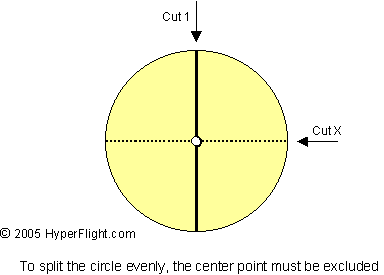
Picture filename:
split_circle.gif
The best way
of looking at cutting the circle is that if the center point is
included in the division then the point would belong to each and
every part of the cut. This would allow the point to be separated and
then the point would no longer be zero-dimensional, which goes
against the definition of a point. If you succeed in cutting a point
then you cut something else (and maybe created polarity) but you did
not cut a point. A point, then, truly cannot be cut. Some may think
we are going back and forth "splitting hair," wallowing in
the theoretical this or that mumbo jumbo that any self-respecting
samurai would scorn at. ("Off with their heads!" shouts the Queen.)
Application
When an
electron becomes constrained by measurement or by physical structures
it instantly reduces -- into a point. As a point the electron cannot
be subject to division by any force. Nobody succeeded in cutting the
electron (or proton) into pieces.
The best part
of this month's topic is that only geometric reasoning will arrive at
the indivisibility of a point. Only geometry can make a link between
a reducing (collapsing) electron and its indivisible foundation.
Arithmetic can be applied to prove some things but only after the
geometric percept establishes the indivisibility of a point. Shake
hand with a Pythagorean.
Notes:
(1) The
underlying foundation of reality may be mathematical but that does
not make mathematics a panacea. Mathematics is but an umbrella term
for many diverse pursuits, and math can be corrupted just as any
thinking process can be. There is a way of working numbers
rationally, irrationally, geometrically, under different degrees of
freedom, with and without symmetry. Such workings are separate and
interactive, transformative (reversible or irreversible), logical,
physical, symbolic, and mythical (numerological and magical). Each
category has unique advantages and that is why each category exists.
You can possibly lose your head in more ways than one. Enjoy.
(2) {Feb,
2006}
Metaphysically, the exclusion of the center point can be worked with
Isis and her putting Osiris together: She could not find his
centerpiece and so she fashioned one. |
|
 |
|
DSSP Topics for April '05
Memory makes
you smarter
Empower the
observer and leave relativity in the dust for black hole enthusiasts
to kick around
You can see the
promise and get there, too |
|
Background
The
illustration below is used by science writers to "prove"
that the observer C cannot determine the precedence of events.
If the event happens simultaneously at A and B and if
the observer C is on a moving train then, they say, C
cannot recognize the event as simultaneous event. The argument is
that, while lightspeed is constant (that is, absolute), C is
moving toward the message sent by B and receives it from B
before he receives it from A -- and there is "no way"
of figuring out when events really happened.
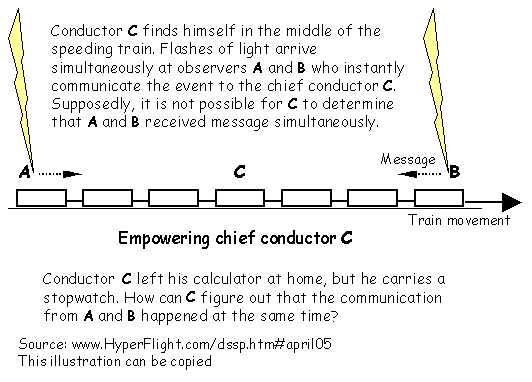
Picture filename:
chief_conductor.gif
The problem of
simultaneity is solvable in several different ways..
Conductor C
could know or figure out how fast the train is going and use a
calculator. Even without measuring the train speed, observers A
and B can meet conductor C anywhere on the train,
synchronize their timepieces, and move to their stations at the ends
of the train. When the event happens, conductor C receives
messages containing the time
stamp
of the event's happening. The very existence of absolute lightspeed
allows the construction of absolute clock
that keeps absolute count during motion by both A and B.
After all, the (parallel or anti-parallel) round
trip of light is always the same regardless of the train speed. The
formal system is saved once again by a regular guy who is the chief
conductor and the captain of his ship.
{August 2005}
This "problem" can be also stated as the 'problem of
synchronizing watches.' As the light-based clock
moves from A to C to B, the light-based clock
synchronizes all observers to the same and absolute time thus
allowing the time stamp method to resolve this "issue."
To claim
relativity theory as proven, the scientist deliberately takes the
resources away from observers until they just do not know. So, by
taking the boat away the scientist can prove it is not possible to
get across the ocean.
Why, you could
even discover that intelligence is needed for this problem. You could
also figure out that the knowledge of simultaneity and the answer
regarding event precedence is inherent in the problem, and it
takes a bit of smarts to bring it out. It should not be unusual for
the universe to develop concepts such as memory
and get to the solution that is contained within the problem.
In addition to
memory, a solution can be obtained through measurement, computation,
and movement. Memory, measurement, computation, and motion could well
be the first four tools to begin understanding the universe.
Exercise
Note:
Absolute photonic undulation of hydrogen radiation can be measured.
The absolute speed can then be measured through Doppler shift if the
interplanetary hydrogen is stationary |
|
 |
|
DSSP Topics for March '05
Points exist in
a plane but the constructed distance between some of them cannot be exact
Euclid's first
amendment: "You can draw but one line between two points but
don't ask me how long that line is."
Pythagorean says:
"Incommensurable numbers are loaded."
Schauberger says:
"Virginia, if you looked in my bag you could figure out I not
only look like Santa Claus, I am Santa Claus."
The 'number line'
is for underachievers |
|
Background
The
incommensurate (irrational) number is usually discussed in a context
that "this number cannot be obtained by rationing." A real
mathematician may well be complaining about the computer that does
division but still cannot portray the world around us. A
mathematician, of course, would not be complaining about a number.
Irrational
numbers are constructed with good ol' integers but you may as well
leave the computer at home. Irrational numbers are constructed only
geometrically in 2D or 3D space. Irrational numbers exist in 1D but
they cannot be created by staying in 1D -- or measured in 1D after
they've been constructed with the Pythagorean Theorem. Pythagoreans
like to construct a pentagram and they like the pentagram because it
has a lot of incommensurable golden proportions. Pythagoreans like
the golden proportions because .. there is a lot of concurrency and
dimension mixing happening inside certain pyramids.
Mario Livio in
his Golden Ratio categorically states there is no linkage
between the Great Pyramid and the golden ratio. He dismisses the
connection because there is a 0.1% golden ratio measurement
discrepancy with the pyramid, which is by now rough at the edges. The
author does not know where to take it if there is a connection, and
it is then easier to deny it. Once you become familiar with
scientist-speak, you will understand it as, "I have no clue but
if somebody does, I got that 0.1% keeping me warm."
Let's take a
look at the (square) root of ten
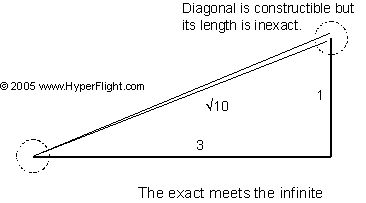
Picture filename:
root_of_10.gif
You construct
the exact length of three (horizontal), the exact right angle, and
the exact length of one (vertical) -- and get two points in space.
However, the diagonal (straight, 1D) line between these two points is
not exact. Actually, the length of a straight line spanning these two
points can never be exact. We can have a line that is exact and
shorter -- or exact and longer -- than the root of ten, but there
exists no solid line that is exactly the length of the root of ten.
There now exists a gap that cannot be closed if you wish to construct
the distance exactly.
Exercise
The right
angle construction is exact but the straight line (diagonal)
construction is not exact. You, (sort from best to worst)
-
Write a very
unkind letter to Dedekind
-
Take advantage
of the truth
-
Write a letter
to Noether and tell her the space symmetry and space homogeneity has
real problems because there are 'holes in space' and 'distance gaps,'
and some spatial directions, angles and distances are inherently not
deterministic. After all, the conservation of energy is exact, not
just "close enough for government work"
-
Connect the
two points with a solid line and
- muse about it
- forget
about it
-
Connect the
two points with a dashed line and
- reflect on it
- build a
gallery over it
-
Keep away from
all irrational numbers and construct only the 'clean and rational'
triangles the likes of 3, 4, 5
-
Keep squeezing
the gap until you get to zero at infinity and declare irrational
numbers with infinite mantissa a subset of real numbers [caution,
those who took this path are still squeezing the gap]
-
Differentiate
between constructible (two points exist) and executable
(length and angle implementation is exact)
-
As every
Pythagorean knows, what works in 0D may or may not work in 1D or 2D.
Because you cannot divide an area of a circle into three exact parts
unless you exclude the center point, then the reverse is also true:
What works for 2D does not necessarily work for 0D. (Euclid said a
long time ago that a point is not divisible, but he said it as a definition.)
Notes
(1) It
is not possible to place the root-of-ten (or any irrational number)
on a number line. The line you think is root-of-ten long is not exact
and can never be exact. You cannot mark a line at a spot that has
infinite number of decimal places, just as you cannot store the
infinite mantissa number on your computer. Real number is unbounded
but finite, and once you truncate the irrational number you'll get a
real number but this number is no longer an irrational number.
Irrational numbers are irreducible because the conversion of the
irrational number into a real number is not reversible. [You would
not catch a Pythagorean reducing incommensurable numbers into real
numbers.] The idea, then, is to forget about the number line and
think of some nifty applications for irrational numbers. If you are a
hard core reductionist and must keep on reducing, that's fine --
black hole beckons..
(2)
There is a way of thinking about the irrationals through the number
Pi. Pi is transcendental and is composed of infinite series of
components. Pivoting around a fixed point and pointing in all
possible directions cannot always result in the exact angle. If it
did, Pi could be an exact number as well. This is more fundamental
than you might think.
(3)
Root of two is the most mysterious of all because the diagonal
construction angle of 45 degrees is executable while the length
of the diagonal is constructible but not executable. {Dec 1, 2009}:
Even though the diagonal is not constructible, diagonals of any and
all squares can be placed on the number line -- but only as two
points of a distance in space. This gets interesting in the Great
Pyramid since the SQRT(2) diagonals can overlay the centerline in the
Grand Gallery. (A transcendental such as Pi cannot be put on a number
line even as two points.)
Notes {3/31/05}
(1)
Euclid's axiom stating that there exists but one line that can be
drawn between two points is not incorrect. Such axiom, however, is
also incomplete because it makes no statement regarding the length of
a segment between the two points -- some segment lengths are rational
and have finite mantissa while others are irrational and have
infinite mantissa. The irrational segments, then, cannot be drawn
without truncating the mantissa. Some mathematicians define
irrational numbers as real numbers but there is no rhyme or reason
for doing so. You can define anything anyway you want, but the fact
remains that irrational numbers are always infinite in
mantissa while real numbers are always finite. The idea is
that there are certain advantages to keeping the infinite mantissa
with irrational numbers and if you think of irrational numbers as
real numbers you will never figure it out.
(2)
There are some funny looking symbols that nevertheless make sense in
their own way. One of these is 'Tibetan Master' symbol, which is
shown in one book on Reiki healing and is relevant to this month's topic.
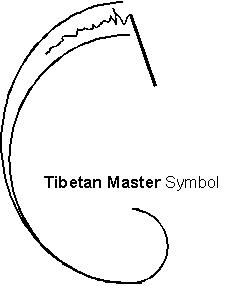
Picture filename:
tibetan_master.gif
[This
particular irrational number application is likely a significant
East-West divide, which will be bridged with one addition to Euclid's
axioms. This is the second enhancement. The first is the
understanding and inclusion of Dantien (Hara) from September 2004
Exercise.] This particular property is discussed in the Quantum
Pythagoreans book. |
|
 |
|
DSSP Topics for February '05
Some mirrors
give some people a splitting headache
Religious Photon:
"Once I was split but now I am found"
James Bond Photon:
"Parted, not split" |
|
Background
The
illustration below shows that in the A1&B1 path all
photons are always detected, while in the A2&B2 (dashed)
path the photons are never detected.
Photons are
best visualized as paper-thin wave crests -- that is, as
two-dimensional waves that, nonetheless, can rotate about the axis of
propagation while maintaining its flatness.
You may have
heard that the reflecting photon rotates 180 degrees and becomes
out-of-phase. But if you apply it in the illustration, something is
not right because both paths (A1&A2 and A2&B2) would have
photons propagating in-phase (together) and, therefore, photons
should be detected in both paths. Actually,
reflected photon rotates 90 degrees CCW during splitter
reflection but rotates full 180 degrees during fully
coated mirror
(regular mirror) reflections.
The incoming
photon P approaches the half-silvered mirror (splitter) with,
say, Up polarity. You define which way is Up. When the
photon rotates 90 degrees CCW from Up then the result is Left
polarity, while 180 degree rotation results in Down polarity.
During transmission there is no rotation and no change in polarity.

Picture filename:
photon-split.gif
The reflected
photon rotates 90 degrees CCW during splitter reflection but rotates
180 degrees during fully coated mirror reflections. Rotation
difference leads to this month's exercise.
Exercise
-
Photon
"splits" at the half-silvered mirror. Its reflected
component (branch) rotates 90° CCW because (check all that makes sense)
-
Reflecting
photon thinks it has the perfect impedance match. Between 0° for
transmission and 180° for perfect reflection is 90°!
-
It's the same
thing as perfect optical coating and the angle of incidence (45°)
does not matter. Photon rotates 90° regardless of the angle of incidence
-
Polarizing
filter can make the rotation any number of degrees. The splitter is
designed for 90°
-
Who cares.
Just tell me how many degrees. Besides, why do I have to use my left
hand if the world was created for the right handers
-
Photon (or
photon branch) rotates by 180° when it is reflected by a regular
mirror. This is because:
-
Photon is an
even function and multiplying by -1 (or twice by i)
results in the reflection about the axis: f(x)=f(-x) [Tricky, leave
for last. Think what axis we are talking about.]
-
Reflecting
photon sees infinite impedance. It must rebound 180° out of
phase (Up becomes Down, Left becomes Right, and vice versa)
-
When I look in
the mirror, right becomes left but top stays on top. Something's
fishy. [Not so. Think how the direction of propagation does or does
not affect the Up/Down and Left/Right definition.]
-
This is all
about snakes and snakes are creepy. And snacks make me fat, and ..
Note
Even though
the photon can be detected in but one path, the photon is really not
recombined. For every photon, 25% + 25% of its wavefunction continues
on A2+B2 path but since the polarities on this path are always
out of phase, the photon will never be detected there. The photon is
still parted in both branches (1 and 2) and unless the photon is
reduced it will stay parted that way, forever. There is still one
question you may want to answer: What is the wavefunction
amplitude in both branches? [Advanced. Think about the difference
between superposition and self-superposition. Photon polarity by
itself does not affect the probability of detection/reduction.] |
|
 |
|
DSSP Topics for January '05
Say hello to
the extra moon |
|
Background
A quick check
on Mars' moons shows these two (Phobos & Deimos) are two octaves
apart: Their measured orbital ratio is 0.253, which is pretty close
to the ideal 0.250 (or ¼) for two octave difference.
A quick check
on Jupiter's moons shows one and two octave separation: Jupiter's Io
and Ganymede periods are measured at 0.247, which is close to the
perfect two octave separation of 0.250. Io and Europa have a single
octave separation, which is measured at 0.498 orbital periods ratio
(close to 0.500 or ½ ratio for a single octave).
Correction
Last month I
was lowering Newton's contribution in proving Kepler's equations.
I've been reminded that the easy part is only in cases of the
circular, or idealized, orbits (Zembrowski A History of the Circle).
For Newton to prove that the solution holds for the elliptical
orbit, he needed and developed the concepts of calculus (fluxions,
infinitesimals), which took a good part of a decade and a priority
tangle with Leibniz.
New Orbit
for the Extra Moon
The best orbit
ratio appears to be ¼ (two octaves). This ratio is found with
the moons of Mars as well as with Jupiter's moons. Moon in the inner
orbit (closer to Earth) will be the best as it could be used for
staging. The new moon should be about 1/10th the mass of the present
moon if the new moon were to have but a moderate influence on tides.
(This may continue to be an issue.) Applying Newton's enhanced Kepler equation:
P12/P22
= (M+m1)/(M+m2) · R13/R23
P1, P2
.. Period of moon1(2)
m1, m2
.. mass of moon1 (current) and moon2 (new). M is Earth's mass, R1
is moon1 average distance of 384,467 km. (M+m1)/(M+m2)
is very close to one since the present moon's mass is only about 1.5
percent of the Earth's mass
P1 =
4P2 (2 octaves). New moon's period is 4 times faster than
the present moon (new moon will have about 7 days orbit period).
Substituting numerical values,
16 = R13/R23
R23
= R13/16
R2
= R1/(2·21/3)
= 384,467/2.52 = 152,566 kilometers
The average
distance to the new moon would be 153 thousand kilometers or about
40% of the existing moon's distance. The new moon will exert
gravitational force on Earth that is about 64% of the existing moon's
force (use Newton's force equation) and tides would change
significantly. Another way of mitigating the rise in moons tides is
to put the new moon in the outer orbit using the same, 2 octave
separation. In that case the tide increase due to the second moon
would be negligible but the second moon would not be of much use.
Note:
The influence on earthquakes may be difficult to asses. Assuming the
moon does affect earhquakes to begin with, the inner orbit moon can
have a calming influence because it averages the existing moon's
forces. On the other hand, at times the forces would be additive and
earthquakes could increase.
{2/28/05}
Earthquake analysis needs to consider both force and duration.
Increase in force due to the combined influence of both moons is of
some duration. Decrease in force due to subtracting influence is
comparatively much longer in duration. Overall, it is most likely
that earhquakes would decrease with the presence of the second, and
particularly the inner, moon.
Constructing
the outer moon to mitigate tides would make it more distant but only
under the presumtion of applying the current (propulsion, inertial)
transport technologies. |
|
 |
|
DSSP Topics for December '04
In search of
planetary musical notes,
Kepler is cool,
Pythagoras
makes it true and pleasant, and
Most
planets (all terrestrial) stay within two octaves |
|
Background
Pythagoras
claimed planets make sounds. During the Renaissance this became the
music of heavenly spheres and each planet got a note. This month it
is about the orbits that are indeed musical.
Kepler is the
most cool guy from a simple perspective. After 2000 years of geometry
Kepler comes up with equations that allow the actual mathematical
prediction of the planet's position -- you do not need lookup tables,
you want a PC. Kepler coined the word satellite (and focus
as well). Kepler's equation is used to get orbit times for any
satellite or a planet. Newton later derived Kepler's equation from a
more fundamental relationship. But as any math guy will attest, once
you know you are dealing with the right answer the individual
components are easy to put together. In other words, it is much
easier to disassemble and reassemble a puzzle than to put it together
from individual and possibly incorrect pieces. Kepler's result is
that any planetary orbit period P has a relationship to the
orbit radius R according to
P2
= k · R3
where k is a constant. [If you think of 'doubling the cube'
problem, there is Pi in the k.]
Yet, there is
still something missing because neither Kepler nor Newton say
anything about planetary separation. Technically, we can go right
ahead right now and validate Kepler's equation for all planets, but
planet-to-planet interactions are important. It is easy to dismiss
interplanetary interactions as "way too weak," but the
periodic nature of orbits makes such interactions repetitive.
Disturbances would add up and that is why there is not only a large
separation between planets, but also there are particular orbital ratios
between planetary orbit times. For example, Venus-Earth orbit ratio
is 8:5. You did not learn about this ratio in a public or
private school, in part because your teacher would not know what to
make of it, and also because the school committee cannot deal with
too many implications. When 8:5 is reduced to 1.6 it
becomes just a number and school committees can deal with that.
Unreduced, however, 8:5 is (a) composed of integers,
and (b) it is a ratio corresponding to particular notes of the
musical octave, and (c) the unreduced number of a ratio
remains true to its ratio while the numerator and the denominator are
translating and/or rotating (and geometry is what you need -- reduced
ratio is one number and it's just a point).
A particular
planet does not have a particular musical note (as was thought during
the Renaissance) but pairs of planets share musical notes because the
orbital ratios match the vibrating ratios of the notes of the octave.
We need musical ratios of Pythagoras because rational numbers
(numbers having integers in numerator and denominator), and notes of
the octave in particular, have little or no harmonics. We don't want
too many overtones and we surely don't want irrational numbers
because we want the new orbit to be stable for years to come. So, we
can play the orbits just fine, but we need to use only particular
tones -- we need to use the notes of the octave for the ratio of
Earth and another planet's orbits.
The Construction
The following
table gives the orbital periods calculated with ratios from the
musical octave and the actual planetary orbit times (periods). All
ratios are with respect to Earth's period:
|
Planet
(Earth and..) |
Musical ratio |
Calculated (Reduced) |
Actual (Measured) |
|
Mars |
15/8 |
1.875 |
1.880 |
|
Venus |
5/8 |
0.625 |
0.62 |
|
Mercury |
1/4 (2 octaves) |
0.25 |
0.24 |
You may want
to look up the actual notes (do, re, mi.. or C, D, E..) for
the above ratios. Two other planets, Neptune and Pluto, orbit in a
musical ratio of 3:2 as well. You can also calculate the
orbital distance R using the musical ratios and, applying
Kepler's equation, compare the musical and the actual results. You
want to stay with ratios because you will not need to know the value
of the constant k.
Next month
we will look at what it takes to build a new, second moon for Earth.
We don't need to know k for the planets of Oss (our solar
system) but we will need to know the guts of constant k to do
the extra moon -- and so we'll bring Newton along just for that. So
far, 5:3 (la,
A) musical ratio for the outer moon seems fine and makes for a
unique note because this ratio is not used by the planets (but it is
close to Mars' B).
Happy and
musical Pythagorean New Year!
Notes:
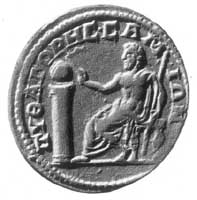 Pythagoras
on a Greek coin (date of coin unstated). Pythagoras
on a Greek coin (date of coin unstated).
On the coin, Pythagoras:
- Helps out
with modeling of a planet or another moon
- Levitates
a stone ball
- Keeps warm
by creating a ball lightning
- Divinates
2,600 years into the future
- Has good
time posing for the coin maker
- Strikes a
note of the heavenly sphere
- Empowered
by Apollo, Pythagoras directs the divine spark to get the solar
furnace going
- All of the above
{September, 2005}
Orbit and musical ratios are alse addressed in the Venus, Mars, and
Pluto orbits through the construction of multi-pointed
stars. |
|
 |
|
DSSP Topics for November '04
Does photon
always have the same energy regardless of the observer's motion --
that is, is photonic energy absolute?
Planck constant
remains a constant while becoming virtual
Photon's
wavefunction has positive and negative probability
What if
superposition is instantaneous? |
|
Background
If all
observers measure the same value then such measurement is said to be
absolute. As you move toward the photon of light its frequency (of
the undulation of the wavefunction) increases because the wave crests
are coming in faster. You also know that frequency is proportional to
the energy of light and so you think that photon's energy increases
as you approach the photon. Not so, amigo. It is true that frequency
increases but photon's overall length also becomes shorter. What gives?

Exercise Questions
-
Observer
moving toward a photon may register increase in photon's frequency.
If observer recedes from photon's source then frequency may decrease.
So, photon's frequency is not absolute but is photon's energy absolute?
-
Frequency
increases and so energy of the photon increases. Done deal. Finished
-
When a photon
slows down inside the glass, for example, its length shortens as in
the left picture above but the photon has not lost or gained any of
its energy
-
It's
relativistic. Put your faith in the equation and don't you worry
about it (or, let me worry about it)
-
When photon
exits glass it speeds up again, its wavelength lengthens as in the
right picture above, but the photon still has the same energy. Use
your reason. (Watch for change in speed, however)
-
If the photon
has 10 units of total energy and if the observer has 1,000 units of
total energy, why would photonic absorption result in more (or
less) than 1,010 units of total energy? Why would the sum be
different if the photon catches up with the observer who is either
coming or going? The conservation of energy holds and the photonic
energy is absolute
-
Make up an
answer pretending to be NASA spokesperson, such as: "All photons
in the universe are the same and they come to us as the uniform
background radiation. All other photons were taken out through the
diligent work of like-minded scientists. If you cannot see any of the
scientists here, that's because you cannot tell them apart from the woodwork."
-
Photon, once
created, has the same and fixed amount of energy in absolute terms
for the life of the photon. Photon can be passed through slits
resulting in self-superposition (self-interference) and its
frequencies (shape) may change significantly but its energy stays the
same irrespective of the speed of the source or the observer
-
Does the
photon as shown above move in the horizontal or vertical direction?
-
Of course it
is horizontal. That's how all texbooks show it
-
If photon is
an even function then it must be symmetrical and, therefore,
propagate in the vertical direction while always presenting its even
symmetry to the environment
-
Diana's bow
has an arrow that shows the axis of symmetry. It is apparent that the
photon moves vertically [Heads up to all guys -- Diana's on the hunt.]
Note:
If you are ready to apply Planck relation E
= f·h
to this month's DSSP topic, consider that Planck did not (have to)
use this relation in the moving source-observer context or
light-moving-through-matter context. Planck reached his number
constancy (h) conclusion because the experimental results
matched his equation. In fact the match is so good his equation drove
the change of the atomic model from 'part-time oscillator' to
'electron radiates when orbitals change.' If the frequency f
in Planck relation is in fact tied to the orbital period (1/f),
and it sure looks like it is, then Planck constant remains a
constant. The orbital is a real thing (eigenstate, if only for a
moment) and, since photon's energy and momentum are both virtual
(light cannot push mirror), Planck constant is to become a virtual
number or be multiplied by i. Planck also coined the
word quantum.
As far as the
moving source-observer context is concerned, think of the energy
density as being a function of an area consisting of positive and
negative segments of a curve, in 2D.
Dirichlet is
right on when it comes to photons coming from materia(ls). The most
interesting thing about Dirichlet function is that it has positive
and negative values inherent inside the function. Mathematically it
is trigonometry but the interesting connection to physics is that
photon's wavefunction takes on negative values. (Photon is pure
energy and it is nothing but a wavefunction.) This means that the
positive probability of a wavefunction alternates and combines with
negative probability. Because the positive probability starts off
larger at the center, the total probability is never negative -- even
if there is a running sum that happens during reduction (absorption).
The positive area is the energy that comes from the higher orbital
while the negative area comes from the lower orbital -- that is,
lower orbital's lower energy is subtracted on the fly from the higher
orbital's energy. Multiplying by photon length (or integrating all
the way) then yields the total and absolute energy. The sum, of
course, will be the same if you integrate slow or fast. Also, the
quantity of photonic undulations (frequency) can change, but the
positive and negative areas stay in the same ratio and then
the energy stays the same. [Light is pretty smart after all.]
Note
{11/30/04} The probability of the photonic wavefunction
alternates between positive and negative values. The energy at
reduction is never negative but is proportional to the square of the net
area, which is positive and constant. Photon always reduces as a
whole. [Euclid defined a point as that which has no parts. Photon has
no parts.]
If you work
the moving observer context and find there is energy left over, you may
have strayed (photon carries all of its harmonics with itself and
photon's geometry is [for now] linear..). Dirichlet also worked the
polarity in general, which is relevant in the explanation of the
existence of the electric charge
|
Nature can
integrate during instantaneous photon reduction and this also means
that the creation of superposition is instantaneous. Of significance
is that the operation of superposition is not the limiting factor in
light propagation. |
|
|
 |
|
DSSP Topics for October '04
Gateways
between the real and virtual domain are at points where both domains touch
Another way of
looking at independent (or leading) variable: Independent variable is enforceable |
|
Background
You do not
need to get involved with Gödel's problems to see how someone
could get totally mixed up in a formal system.
Taking the
output of the inverter and routing it to its input is an allowed
combination that has indeterminate and confusing outcome. The
inverter, as the name suggests, inverts true logic level, say 1, into
false level that is 0, and vice versa. When connected as shown below
the inverter's output cannot make up its mind.
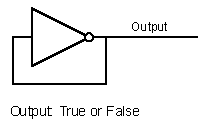
Picture filename:
inverter.gif
Reconciliation
of the conflict arising from formal procedures is through enhancement
in context, which, in turn, facilitates completeness. [Completeness,
however, cannot be achieved at the expense of tractability. Should
intractability arise you will need to tackle it by engaging the
dragon -- but not in this article.] In the case of the inverter
connected as shown above, once the frequency response of the inverter
is included as the new parameter of the real system the problem is
resolved. Frequency (or vibration) is also to be found in the virtual
domain and some people may see such coincidences as gateways or
windows or 'points of contact' between the real and the virtual domain.
Similar
but less
conflicted gateway happens with Euclid's 5th proposition of his Elements.
This proposition postulates there exists but one line that passes
through a point while parallel to a given line. If, however, spatial
distance is allowed to bend, another line or lines can snake around
the given line in a spiral fashion while being equidistant from
("parallel" to) the given line.
The resolution
here is somewhat more complex. (To merge/differentiate parallel
and equidistant you need a flat/curved plane.) In the real
domain, spatial distance is the absolute construct and distance
bending can be disallowed simply because any amount of spatial
distance bending can be measured and only one line is then a straight
line. Euclid's 5th proposition is thus correct because when Euclid
calls for a straight line he can have it in absolute terms. In the
virtual domain, however, spatial distance parameter is a dependent
parameter. A wave can be a straight standing wave as well as a wave
of the distance-curving orbital, and computable solutions exist for
both or one or many or none, depending on vibration and geometry.
Nonetheless, Euclid's Elements is valid and complete in
the real domain because a line is defined and enforced as
infinitely straight. The gateway in this case is the parameter of
spatial distance, which in the quantum mechanical environment (in the
virtual domain) becomes dependent on other variables. Nonlocality of
the wave in the virtual domain does not allow the parameter of
spatial distance to be the independent variable and, therefore,
spatial distance is not enforceable in the virtual domain.
The finger.
Science
writers oftentimes bring up the example of a triangle being drawn on
a spherical surface where the internal angles of such triangle exceed
180 degrees. This is, rather, an example of feeble science writing
because the curvature of the sphere is easily measured. Euclidean
geometry is applicable to the real system that is also a formal
system that is also an unambiguous system. The sum of internal angles
being 180 degrees holds for a flat plane triangle and the flatness is
enforceable. To say that triangle's angles on a curved sphere exceed
180 degrees has as much intellectual weight as the claim that
overloaded truck's tires may not hold out. The weight of the truck is
a real parameter in the real domain and can be enforced in the
real domain.
If, however,
you find the
virtual domain to be a significant component of the universe and want
to pick organization out of chaos, then welcome to the ride -- it
starts at the point of contact. Point is zero-dimensional and that's
another way of applying zero. In fact, real and virtual domain can
contact only at a point.
Note: {10/2/04}
Riemann used "his own" version of non-Euclidean geometry.
His triangles always exceed 180 degrees because they are always
on a sphere. His lines were not only not infinite or unbounded, but
finite. It turns out Riemann was working the atomic geometry where
modulo math always makes lines into finite segments and incomposite
(prime) numbers help out with the orbitals.
Note: {1/31/05}
Gödel could not prove he is sane or insane, and so he ended up
.. nuts.
Note:
{2/28/05} Euclid understood irrational numbers as numbers that cannot
be obtained by rationing. If he did know that the irrational numbers
have infinite mantissa, he could appreciate it is not possible to
exactly determine the length of a line formed by an irrational
number. For 2,600 years irrational numbers are truncated as
"close enough," but the 'infinite mantissa problem'
provides for yet another gateway from within the Euclidean geometry. |
|
 |
|
DSSP Topics for September '04
Zero is
emptiness to some, infinity to others
Pythagoras keeps
it simple with magnitude and multitude |
|
Background
Real numbers
represent real things. Real things cannot be zero because real things
must be something tangible to be real. An argument can be made that
zero is not a real number because in the absence of real things zero
becomes nothing, absence, void, or vacancy -- and none of these are
real things. The total number of real things in the universe is
finite but unbounded.
Virtual
numbers represent virtual variables. Virtual numbers can be positive
or negative and pass through zero. Virtual numbers are about pairs of
opposites that include zero. The total number of virtual variables in
the universe is infinite. Since there is infinity of virtual
variables then there is infinity of zeroes.
Exercise Question
Zero is not a
real number but there can be infinity of virtual variables that can
have a value of zero. You conclude:
-
All real
numbers are single ended and exclude zero
-
All virtual
numbers are double ended and include zero
-
All virtual
numbers can be centered about zero. Centering results in balancing of
all virtual variables and centering is a subjective operation
-
In the
Pythagorean tradition, the pursuit of real numbers is about magnitude
while the pursuit of virtual numbers is about multitude
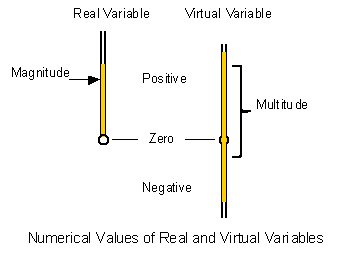
Picture filename:
pythagorean_zero.gif
Bonus
question: How would you map the human spine as the zero axis? [Start
with Leonardo and think three vs. four plus dantien]
Notes {8/30/04}
Dantien (Hara
in Japanese) is a point in a human body that presently has no English
equivalent. In time, this point will be explained as the 'second
point of balance' and generically called the Couplex. Yes,
there is the 'first point of balance,' which is also Couplex but in a
different part of the body.
Real variables
are always single-ended. At times, pressure and temperature may be
said to be negative but both the pressure and temperature are real
variables issuing from real parameters that are vibrating real
things. Temperature and pressure are single-ended because they have a
limit at absolute zero (but they do not reach absolute zero).
Note:
Real variables
are not zero but they come close to zero. What is this close-to-zero
parameter and how is it quantified? [think Planck]. |
|
 |
|
DSSP Topics for August '04
Golden ratio is everywhere
but it is mostly shown as linear proportion
Modern Pythagorean
definition of irrational numbers
Introducing the
Golden Triangle that is the Cosmic Triangle |
|
Background
Golden ratio
is also called the Divine ratio. It is found in nature and the ratio
of two consecutive Fibonacci numbers converge toward the
Golden ratio -- a property discovered by Kepler.
Golden ratio
is constructible, which immediately sets it apart from  (Pi) and e. Golden ratio is irrational
(incommensurable) but, unlike Pi, Golden ratio is not transcendental.
Because Golden ratio is a ratio, sometimes called proportion, Golden
ratio is best expressed as, well, a ratio a/b.
(Pi) and e. Golden ratio is irrational
(incommensurable) but, unlike Pi, Golden ratio is not transcendental.
Because Golden ratio is a ratio, sometimes called proportion, Golden
ratio is best expressed as, well, a ratio a/b.
Keeping along
with our May '04 exercise we are not going to
reduce a/b into a number because incommensurate numbers are
"in potentia" as irrational numbers. In
modern Pythagorean classification, irrational numbers are not
reducible. Reduced irrational number undergoes transformation into a
real number that has finite mantissa. Irrational numbers comprise a
unique class of numbers and irrational number is not a real number. If
we give the Golden ratio one number such as 1.6180 it becomes a real
number and unbecomes the Golden ratio.

For a/b
to result in the Golden ratio, we take distances a and b
and require that they maintain proportional relationship such that
the greater distance a is related to smaller
distance b in the same proportion even if the length changes.
Then, a/b = (a+b)/a. This relation
results in (a/b)2 = (a/b) + 1. Solving for a/b
we get two roots (1 ± 5½)/2, and we are not
going to reduce these roots any further.
Pentagram is
possibly the richest source of Golden ratios. However, pentagram's
Golden ratios are mostly linear -- that is, a/b may be
in Golden ratio but geometrically a and b are in-line.
Golden ratio
happens all over the pentagram and some writers get excited about it.
Some make a rectangle having a and b on each side and
get excited about it. Fine, but let's look at the general equation:
(a/b)2
= (a/b) + 1
Squaring the
Golden ratio is the same as adding 1 to it. This means no fancy
computer is needed to do squaring because we just add unity. So, by
adding 1 we can do some quick and easy squaring! [Self-test: You are
a Pythagorean if you are excited now. You know squaring is about
force (acting on a string, etc.).] If you are "totally
cosmic" you know which entities can only add and which can only
multiply. (Question: What is the general form of addition?)
|
Note
{8/31/04}: Construction of an irrational (incommensurable) number
facilitates its transformation into a (finite mantissa) real number.
Note
{10/30/04}: Pythagoreans called irrational numbers 'unspeakables.'
Other than the apparent literal meaning of secrecy, the unspeakable
aspect is that the irrational number is not to become real (not
reducible into real number in today's terminology). Golden ratio in
particular allows superposition of certain vibrations Pythagoreans
though harmonizing and, therefore, healthful. The irrational number
is to remain irrational while being useful without becoming real, as
in the case of exactly, rather than just precisely, doubling the area
of the square. While the incommensurate (irrational) numbers could
not be spoken they could conceivably be sung or chanted.
Incommensurate numbers, no doubt, had divine meaning for
Pythagoreans. Visualization may be yet another way of keeping the
incommensurate numbers unspoken and useful. The unspeakable property,
then, does not mean that irrational numbers should not be spoken or
spoken about but, instead, that irrational numbers cannot be (fully)
described by words. You can talk about irrational numbers all day
long and without necessarily breaking Pythagorean secrecy rules but
the point of the Pythagoreans is that you will never be able to
describe them.
It is
difficult to say all Pythagoreans shared in all of their knowledge.
It is known their knowledge was separated into at least three levels
or grades of study and 'initiation.' With Pythagoreans' emphasis on
friendship it is not likely their knowledge was compartmentalized,
but no knowledge was available to outsiders. With so much
misunderstanding concerning irrational numbers the Pythagorean
secrecy certainly works, and those the likes of Cantor never figured
out the meaning of the unspeakables.# Incommensurable
numbers carry in their core the infinite superposition and calling
them irrational, for example, corresponds to the lowest level of
understanding of these numbers. Having said that, we shouldn't have a
problem calling Tarot#0 The Fool, for we've all been there.
____________
# Cantor never
understood that real numbers have finite precision and, therefore,
finite resolution. He could certainly define a new class of infinite
numbers and do his work there but he though his work was applicable
to real numbers and that is where he failed. Our left brain operates
in the emulation of the real world and the left brain needs to stay
true to that world (which is unbounded but finite). Cantor has gone
insane and died insane. All state committees approving math teaching
material may need to realize Cantor is attacking the intractable
problem with sequential methods. Then again, math committees may not
have access to Pythagorean teaching |
Exercise Question
a and b
can be any number and as long as the a/b is the Golden
ratio, the relation (a/b)2
= (a/b) + 1 holds. The number 1, or unity, compared to any
number that a or b can represent means that
-
There exists
the absolute one, the monad, God, unity
-
There is the
absolute unit of measure that is the length of one
-
Get with it.
Everything is normalized to the shortest distance. a and b
relate to that shortest distance that becomes the length of one.
Mayans did not use fractions because everything can get normalized
to the shortest distance. [But unfortunately Mayans did not get into
modulo math, which is about harmonics and harmonics are about fractions.]
-
Whatever the
units of measure for a and b, there exists the one
of that unit of measure. [But only if you do not divide anything.
It's okay to divide by two or more, even for Pythagoreans.]
-
There is no
such thing as the shortest distance and the Golden ratio equation is
a mystery
Right and
Golden Triangle
Take the
linear Golden ratio and rotate segment a clockwise until there
is a right angle triangle. You get:
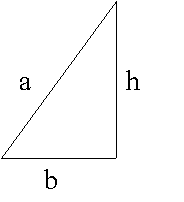
Picture filename:
triangle_golden.gif
Right and
Golden Triangle is the Cosmic Triangle
In addition to (a/b)2
= (a/b) + 1 there is now also h2 = a2 - b2.
Working these equations you find h2 = a x b.
Much better
than, say, a triangle having sides 3, 4, and 5. This is Cosmic [very
cool] even though you have to think about it. Ancient Egyptians got
involved here and it appears they knew about the Golden ratio and put
it in the pyramid but they were mum about it and did not identify or
disclose Golden ratio. Rhind papyrus has fractions approximating Pi
but nothing on Phi, the Golden ratio.
Incidentally,
if we presume
that the height of the Great pyramid is the same as the radius of a
circle that has a circumference equal to the perimeter of the base (8b),
then 2 h
would equal 8b. (For more details see Mar '04
Exercise.) Carrying out the calculations will give us h
would equal 8b. (For more details see Mar '04
Exercise.) Carrying out the calculations will give us  from (32/(1+5½))½
that is within 0.1% of the actual
from (32/(1+5½))½
that is within 0.1% of the actual  .
A discussion can now be had whether the ancient Egyptians were going
after Pi or after Phi in the construction of the pyramid. Since
construction tolerances and aging/settling are greater than 0.1% the
discussion can go on and on and either position can be justified.
However, since many other dimensions within the pyramid were targeted
at Phi, the true answer is not that difficult to figure out. .
A discussion can now be had whether the ancient Egyptians were going
after Pi or after Phi in the construction of the pyramid. Since
construction tolerances and aging/settling are greater than 0.1% the
discussion can go on and on and either position can be justified.
However, since many other dimensions within the pyramid were targeted
at Phi, the true answer is not that difficult to figure out.
Note: {April,
2996}
We now also have a page on Golden
Proportion |
|
 |
|
DSSP Topics for July '04
Even if time is
not inherently absolute the construction of the absolute clock is possible
If time is always
a derivative then time cannot dictate what will happen |
|
Background
Time is
derived from periodic orbits, initially the moon and the sun (earth).
If these orbits were to change then our time reference would change
as well.
Atomic clocks
may appear to be a more stable time reference than planetary orbits
but temperature or pressure will change such clocks as well. Some
even claim mental influence can change atomic clocks. Can we then say
that, since time always depends on other things, absolute time cannot
happen? But if time is derived from a source that is known to be
absolute, can you construct absolute clock that counts absolute time? [Yes]
Absolute time stays the same for all stationary or moving observers
-- that is, time is not a function of the clock's velocity. (See last
month Note on speed approaching lightspeed.)
Exercises (Dealing
with derived properties -- and what it does and does not mean)
-
If time is
derived from a source that is known to be absolute, absolute clock is
constructible. Additionally, can you construct Newtonian framework of
absolute spatial distance and time? If so,
-
Will absolute
clock get rid of chaos?
-
Guaranteed
- Only helps
- Neither
guarantees nor helps
-
Is relativity
postulate correct? [Yes, but only in the most
trivial context.]
-
Are
instantaneous events consistent with absolute time? Is instantaneous
event the same for all observers in the framework of absolute spatial
distance and time? (Instantaneous event is a nonlocal event during
quantum mechanical reduction.)
-
Having
established absolute space (spatial distance) and time, can you make
a case for absolute gravitational force? If so, can you use
conventional (Turing machine) computational means to..
-
Describe
the universe?
-
Construct
the universe? That is, construct formal systems while avoiding chaos?
-
Grow
the universe? That is, add new formal systems on top of existing
systems while avoiding chaos?
-
Repair
the universe? That is, reorganize a subset of a formal system that
has gone chaotic?
-
If time is a
derivative and absolute time can be constructed, can you
-
Reverse the
relationship where other things subordinate to time? For example, can
you physically travel in time in absolute terms?
-
Send out
absolute time pulses and expect the universe to organize?
-
If time is a
derivative then the "arrow of time"
-
Follows the
nonlinear increase in entropy if time is derived from a closed system
-
Follows the
nonlinear increase in entropy if time is derived from Eddington's
proposition: 'Universe is a closed system -- all you get is
increasing entropy.' (Since universe has no physical or thermal
barriers that would make it a closed system then 'Entropy in the
universe is increasing' proposition is intellectually so weak
Eddington's competence and motives are issues here.)
-
Keeps
repeating periodically if time is derived from a periodic system such
as orbits. The mathematical solution exists and is periodic. (Pretty
much what is observed when you look up.)
-
Keeps
repeating asynchronously when considering electron's time-based
evolution and asynchronous reduction. Time arrow moves forward but
gets reset from time to time as a result of electron's interaction
with photons or physical structures. (Electron's propensity to evolve
fits nicely with Aristotle's potentia.)
-
Moves forward
in the computer under program control but human interaction can have
the arrow of time jump back and execute the same or another program
again. (Fits nicely with Aristotle's causality.)
-
Points in
backward direction if time is derived from nonreversible
transformations but only after the fact (only after supernova in fact
happens). Matter is destroyed and there is a setback because matter
cannot be rebuilt readily
-
Points in
forward direction if time is derived from the expansion of the
universe, which, in turn, is correlated with the increase of
organization in the universe [fits nicely with yours truly]
-
If time is
derived from reversible transformations, time can be defined
to go forward or backward, be periodic, point randomly, be
event-driven, or be human defined. Yet nothing can be inferred from
such time behavior and the arrow of time can be anything for all
reversible transformations
Notes
There is
uncanny lack of understanding regarding derivatives -- as if
scientists were somehow bounded and petrified of derivatives. Science
writers can spell the word but they have little knowledge on what can
and cannot be done with derivatives. Business writers do a bit better.
Once we
establish that time is always a derivative then this means
that time is not intrinsically independent and we cannot make
conclusions based on time alone. If time is derived from a
variable that is independent then time can be treated as independent
variable for as long as the variable from which time is derived
remains independent. Time cannot be manipulated with the expectation
that something else will change in the present or in the future. Time
can be used as a reference to go into the past and recall memories
only (things that already happened).
Derived
property is a subordinated property of an entity. As example, a
shadow is a derived property of the object's position -- object's
movement moves the shadow but the movement of the shadow cannot move
the object. Mathematical differential is also called a derivative.
However, a mathematical operation that is a differential (derivative)
is different because mathematical differentials deal with changes --
need to distinguish between a mathematical differential and a derived
property. If scientists became more educated about derived properties
they would use fewer equal signs (=) and more derivation pointers
(—>). Algebra is (becoming) inadequate.
Another
example of a derivative is the frame-of-reference. Frame of reference
is a derivative of a spatial position or a movement of a real thing
because the frame of reference has no mass and its position does not
become nonlocal as it should be in the quantum mechanical
environment. The frame of reference, just like time, is an
inferior/subordinated parameter of a real-only object.
Note {July
30, 2004}
In summary,
time can be found in various relationships with the observed physical
phenomena but such time relationship is specific to the phenomena and
time cannot be generalized by removing (disconnecting) time from the phenomena |
|
 |
|
DSSP Topics for June '04
Keep mass and
inertia together because inertia is a characteristic of mass that is
derived from the behavior of mass
If there is no
light here then this must be hell
Inertia
gets enhanced description (below) |
|
Background
Newton took
the static definition of mass based on volume and density -- mass
weight -- and gave mass a dynamic characteristic -- mass inertia.
Inertia is the dynamic property of mass because every mass object
will resist the change in the object's velocity and more inertia
(resistance) there is more mass there is in the object. Inertia's
unit of measure is force.
Newton did not
endow light with mass or inertia and he characterized light as being corpuscular.
Newton knew light has no material property and picked a unique name
to describe light. It turns out light is quantized into packets of
energy now called photons.
At the time of
the Michelson light speed experiments in the 1880s it was well
established that light's repeated bouncing between mirrors does not
slow light down. Light, then, has no mass. Light is a wave and wave
is by definition nonlocal, for light's energy is distributed over the
presence of the entire wave. Light is a wave that can be branched at
lightspeed in infinity of ways, and it is for this reason as well
that light has no mass. The massless nature of light, however, did
not stop some people from asserting that light has inertia.
Exercises (something
to consider -- or not)
-
Light slows
down instantly when it enters glass and light also speeds up
instantly when it leaves glass. How could somebody assume light has
inertia if light speeds up on its own?
-
If light has
no inertia how can light cause electrons to be ejected from
atoms/molecules? [Think conservation of energy when photon is
absorbed and ceases to exist as photon of light.]
-
Why nobody
performed the experiment (theXperiment)
that would measure the presumed pressure laser light imparts on
mirror as it bounces from it? That is, why nobody measured the
presumed inertia light is supposed to have?
-
Although
inertia is defined through mass (it is a property or a derivative of
mass), one scientist
-
Split inertia
from mass and claimed that reflecting photons have inertia and push
objects without slowing down and without having any mass
-
Confused
himself so well he called light schizophrenic at times, and as having
spooky action at other times
-
While holding
on to photon's inertia he backfilled light with "effective
mass" and proclaimed light subject to gravitation
-
Single-handedly
launched a branch of pseudoscience that worships black holes
-
Light is
energy. Light has no mass and no inertia, and light's momentum is
virtual. Light is not subject or party to gravity. Light's unique
property is that it can take on infinitely many shapes. Light can
push things only when light becomes real energy at absorption, at
which point the photon is gone but its energy lives on in another
form (electrical, heat, motion, pressure). It is the infinite
multitude of photonic shapes that enables the creation of many
different types of energies when photon is absorbed.
Having fun
with light includes asking your teachers questions they will not have
good answers to. Try our Stump
Your Teacher.
New Definition
of Inertia
is based on the conservation of energy:
Inertia is the
ability (property) of a real mass to accept work, store it, and
return it in equal measure. The capacity of mass' inertia to store
work is unbounded. Inertia is the agent
(arbitrator, mechanism) of the conservation of real, in this case
moving, energy. Moving energy is linear and/or angular. (Energy and
work is the same thing -- they have the same units of measure of
Newton (force) x meter (distance).) Often ignored aspect is
that any distance must include direction because the force must be
expanded in some direction.
Work is force x
distance. Mass body changes its speed or direction if mass inertia is
to store the energy as work. The measure of work includes direction
and inertia's ability to return work in equal measure includes
magnitude and direction (it's a vector). Inertia mediates and
facilitates the conservation of energy -- a mass object receiving
energy in one part of the universe is able to conserve and return
such energy in equal measure at another part of the universe. Because
the direction is the component of energy that is being conserved, the
directional aspect of the universe is absolute (agreeable to all observers).
Movement of
the frame of reference, linear or not, does not and cannot engage
mass' inertia -- something Newton is quick to point out (Principia).
At near the
speed of light, matter offers greater and greater resistance to the
applied force. Although real matter's speed cannot exceed the speed
of light, matter's inertia has the ability to store unbounded amount
of work. Rest mass or mass' gravitational force does not increase at
such high speed but inertia continues to accept and save work without
bound [obvious but not taught at regular schools].
[For
Pythagoreans the operation of multiplication or squaring (matrix
multiplication in general) facilitates transformation that gives rise
to forces.]
Note
{June 30, 2004}
Inertia
negotiates the conservation of energy and at speeds approaching
lightspeed the accumulated energy improves core/particle stability.
Core/particle's half-life constant is no longer constant but
increases without bound as lightspeed approaches. Near the speed of
light the momentum of an object increases without bound (even though
the speed is bounded by lightspeed) and the half-life parameter
increases without bound as well.
Atomic clocks
based on half-life property of matter cannot be used to make accurate
clocks because such clock's accuracy is a function of its absolute
speed. However, using absolute clock as a reference, atomic clock can
be used to determine the absolute speed of the ship. Yes, atomic
clock will stop at lightspeed but absolute clock will not. The
construction of the absolute clock is below (November
'03 DSSP Exercise).
Note {2/28/05}
Newton defined
inertia as force (that resists ..). Newton also made force
responsible for the change in movement (velocity). However, it is not
force but work (work is energy) that is responsible for the
change in movement of a real mass body. What saves Newton is that
force cannot arise for a zero time duration. What saves Newton is
that, quantum mechanically, force arises as a non-zero amplitude (and
opposite) pair from a reducing even function. Because force manifests
and engages the body over some non-zero distance, every time one
speaks of 'force acting on a body,' one also speaks of work in
consequence. Technically, however, force is not energy and a cup on a
table is subject to force but not to energy. All said, it may be
worthwhile to restate Newton's conservation of motion in terms of
work (or energy). While at it, the conservation of direction should
be formally stated as well.
Note
{2/23/11} Yes, the conservation of direction comes from Leibniz (and
my version of the law of the conservation of direction is in the Quantum
Pythagoreans book).
Note
{April 14, 2011} In July 2010 DSSP topic I
put forth the inertia mechanism conserving the moving (real) energy. |
|
 |
|
DSSP Topics for May '04
If a number is
called a real number then it must represent real things. Quantum
just may be the inevitable consequence
Looking for nodes
on a planetary musical string |
|
Background
Last month's
square root rosette is attributed to Theodorus of Cyrene (~400 BC) of
the Pythagorean school. It is apparent Theodore wanted to show that a
square root of a number such as two, while irrational, can be
constructed as a real thing of a stick of a particular length.
Presently, one
can enhance on that by making a case that any irrational number such
as golden ratio can become real (rectangle, flower, spiral) only if
it has finite precision (finite mantissa). The irrational number,
then, can be realized and its real representation (exact
measurement) is possible. When irrational number becomes real it
becomes necessary for its numerical representation to have finite
precision. Reality always seeks a definitive (localized, particular)
answer. Present day math guys then also need to refine the definition
of a real number by making all real numbers subject to finite
precision. Some sophistication may be called for when translating
irrational numbers into real numbers, for simple truncating or
rounding may not be sufficient.
The exact
measurement of an irrational number, however, is not possible and
irrational number remains "in potentia" or "in
waiting" much the same way a+b remains a+b. In the Pythagorean
tradition the irrational number is incommensurable
(not in accord -- think music). Square root of 2 is irrational number
but 1.4142 is real number.
The
(non-Pythagorean) kicker is that rational numbers can become
subject to finite precision if their decimal fraction goes on for
many decimal places without repeating in cycles. The open problem is
then showing whether all rational numbers have repeating fraction. Or
is it, perhaps, that only the rational fractions of the pleasant-sounding
octave (1/1, 9/8, 5/4, 4/3, 3/2, 5/3, 15/8, 2/1) are easy to
translate into real numbers of particular real force and nodal
length. The fact is that all rational fractions and the geometric
mean (square root of a product of two numbers) are constructible, but
the important part is the finite precision that happens in the act of
construction (realization).
Exercises
(school
text worth changing -- or not)
-
Every real
number is bounded in precision (mantissa is of finite length)
-
Collectively,
real numbers are unbounded in quantity but there cannot be infinite
quantity of real numbers (quantity of real things is finite though unbounded)
-
There can be
infinite number of virtual numbers because there is infinity of
virtual variables
-
Ancient
Egyptians expressed fractions as harmonics. Explore this to see if
there are advantages
-
God may have
created integers but it is up to the humans, if they can figure it
out and improve on it, to harmonize with the universe. (There are
prominent roles for near-integers.)
-
The
transcendental aspect is that the bounded precision of a real number
leads to the digital (quantitative) nature of the quantum mechanical
environment. Physical quantities realizing (albeit temporarily) at
the atomic scale will have finite precision values and this
environment then cannot be fully continuous. [It can get pretty
unusual here.]
Note:
Rational fractions 1/3 and 2/3 are special because many (though not
all) angles, including 360, can be divided by three exactly. Think of
the angle as rotation and think of the 360 degree angle as the orbit;
now use compass and straightedge (real tools) to divide the orbit by
three exactly and realize these fractions with quadratic methods --
this is the ancient Egyptian's "secret" on why fraction 2/3
was not written out in terms of the harmonics series. One can
visualize this by having a ship navigate a route but being able to
calculate its exact position only at particular points along the way
-- the ship can navigate successfully even though it cannot make
continuous exact adjustments. During the orbit the planet having 2/3
orbital relationship with another planet can make out (calculate) the
exact mutual position at a very large number of angles (3, 5, 15, 18,
30, 40, 45, to name a few). It is likely Kepler was getting into this
area when he proposed additional angular planetary relationships for
astrology charts. Kepler stated he did not know why some angular
relationships were more harmonious than others and Gauss was yet to
come with his constructible polygons. [Some occult writers explain
the mystery of the Sphinx as being based on thirds. Sphinx, however,
has two pairs of legs and is but a messenger -- one of many at that.]
Note{May
31, 2004}: Present day mathematicians are quick to point out that an
arbitrary angle cannot be divided by three exactly using quadratic
methods (compass & straightedge). Delighted in telling us what
cannot be done, they may want to consider that the solar system is
using quadratic methods just fine and regardless of their arm chair
conditions. [Are three pieces of rock smarter than all
mathematicians? More practical, for sure.]
Note{June
7, 2004}: The bounded precision of real numbers has implications
that go well beyond arguing about the Pythagorean rational numbers
foundation and Pythagoreans were mum about incommensurable
(irrational) numbers for mystical reasons. First, put aside Cantor's
much admired pole-sucking nonsense of mapping all numbers onto a
line. The mysterious quality of bounded precision of realized
irrational quantities comes to light if you desire to take the U out
of the UFO.
|
|
 |
|
DSSP Topics for April '04
Get square root
of any integer and then pick systemic subset |
|
Background
Some infinite
sums are bounded -- that is, even though the number of summing
components is infinite, the sum itself is finite. If, say, the
summing components are energy the total sum of energy would be
finite. The finite (or bounded) nature of the sum then also allows to
address the entire system computationally -- even in the
instantaneous (quantum mechanical) environment.
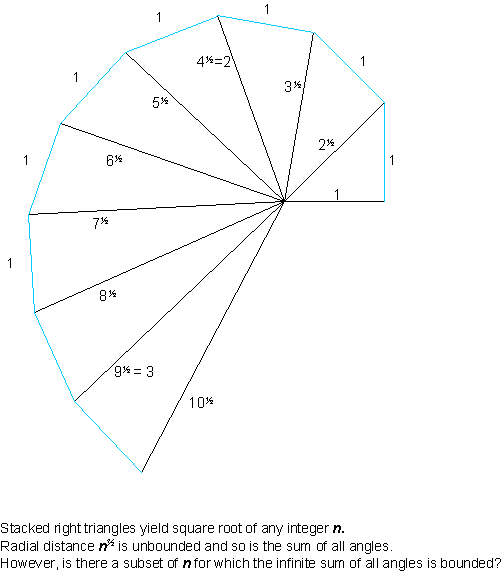
Picture filename:
triangle_sums.gif
Take a stack
of right triangles that have unit distance (distance of one) on a
side. We get a square root of any integer we want. Mathematically,
since the basic harmonic series Sum(n-1) is unbounded, Sum(sin-1 n-½)
for n=2 to infinity is likely unbounded as well. To apply the
rosette, if you think in the gravitational context the squares of
radial distances are inversely proportional to forces, which then
form a square harmonic series. But there is more
Exercises (ideas
worth developing -- or not)
-
The angle for
each n½ is a sequence of unitary
pendulum periods (length = 1) under unitary acceleration forces
normalized under 2 .
(Pendulum periods are independent of weights placed at the ends of
the n½ distances.) .
(Pendulum periods are independent of weights placed at the ends of
the n½ distances.)
-
Radial
distances of all integers in a sequence n½
represent the linear progression of unitary angular momentum.
(Angular momentum is energy.)
-
Unit weights
placed at the ends of the n½ distances
will have the same (unitary) angular momentum if the angular velocity
is a multiple of n (divide
by n
if
going to a larger orbital, multiply by n
if
going to a smaller orbital)
-
Weights placed
at the ends of the n½ distances can
conserve energy exactly if the angular velocity is constant and if
the weight is finite-divisible by n. Finite divisibility is
defined as a property of any fraction that results in finite
decimal mantissa.
[The idea is that in the atomic environment the conservation of
energy must be exact during orbital changes, which are instantaneous
and quantized -- that is, energy cannot be approximated or averaged
once photons are created (transformation is exact). This could also
shape electron's mass into a particular and fixed mass value.]
-
Unit weights
(fixed masses such as electrons) cannot jump to those lower/higher
orbitals for which the difference in energy does not have finite
mantissa values
-
If the
elimination of those orbitals that do not have finite mantissa values
results in convergent sum of all remaining orbital momenta then the
total energy is finite and the problem (atom) becomes systemic and
manageable through computational means
-
Pick an
incomposite number like, say, 137, and see what happens |
|
 |
|
DSSP Topics for March '04
Squaring the circle:
From Greeks to alchemy to Great Pyramid, with the mention of present
lam science |
|
Background
Squaring of
the circle was a great pastime of Greek geometers, who tried to
construct a square from a particular circle using but a compass and a
straight edge such that the area of the circle equals the area of the
square. In addition to exploring the constant  (3.14..), this exercise acquired a particular mystique because it
could not be done exactly with the instruments provided. The Creator,
then, needs to have other tools besides a compass and a straight edge
to square the circle or, in reverse, make a circle of the same
circumference given the square. One can also reach the conclusion
that since the Creator can deal with limitations, the exact solution
is not necessary and the value of any real variable will then
also need to have its mantissa (precision) trimmed at some finite
length. Real things, the Creator may decide, will not be infinite.
(3.14..), this exercise acquired a particular mystique because it
could not be done exactly with the instruments provided. The Creator,
then, needs to have other tools besides a compass and a straight edge
to square the circle or, in reverse, make a circle of the same
circumference given the square. One can also reach the conclusion
that since the Creator can deal with limitations, the exact solution
is not necessary and the value of any real variable will then
also need to have its mantissa (precision) trimmed at some finite
length. Real things, the Creator may decide, will not be infinite.
Alchemists of
the Renaissance picked up on circle squaring and added additional
challenge: The man is the creation in the image of the cosmos and,
therefore, circle squaring has a lot to do with man's existence and
spiritual growth. The square is supposed to represent the spiritual
(virtual) aspect of man but others say the square really represents
the real part. [Nothing to get hung up about.]
The
measurements of the Great Pyramid in the past (19th and 20th)
centuries revealed that the circumference of the pyramid's square
base is equal to the height of the pyramid multiplied by 2 .
That is where it rests. However, the obvious interpretation is that
the circumference of the base of the pyramid is the square of the
circle that is formed by taking the height of the pyramid as the
radius of such circle. The ancient Egyptians wrote .
That is where it rests. However, the obvious interpretation is that
the circumference of the base of the pyramid is the square of the
circle that is formed by taking the height of the pyramid as the
radius of such circle. The ancient Egyptians wrote  as a fraction equal to about 3.16. (Rhind Papyrus, 1,600- BC.) Note
that most square-the-circle problems deal with equality of the area
of the square and the area of the circle. Archimedes addresses the
circumference because he uses rotation. In all, the problem of the
squaring of the circle is applicable to either the area or the
circumference because both problems are qualitatively the same.
as a fraction equal to about 3.16. (Rhind Papyrus, 1,600- BC.) Note
that most square-the-circle problems deal with equality of the area
of the square and the area of the circle. Archimedes addresses the
circumference because he uses rotation. In all, the problem of the
squaring of the circle is applicable to either the area or the
circumference because both problems are qualitatively the same.
The present
day science is so close to engineering it does not see many
implications in the squaring of the circle. After a short Internet
(Google 'squaring circle') and Borders bookstore search, I was not
able to find any published associations between the Great Pyramid and
the squaring of the circle. {Did find an association by Farrell in
the Occult-Speculation section.}
Exercises (True
or False):
-
The squaring
of the quantum mechanical wavefunction results in the realization
(reduction) of the wavefunction. The intangible thus becomes tangible
-
The
"pyramid power" rests on the outside (the skin) of the
pyramid rather than on the inside (volume)
-
The
"pyramid power" rests on the skeletal (one-dimensional)
geometry, which enables materialization inside the pyramid
-
The pyramid
glows when viewed in "frequency" domain. Alien ships use it
as a beacon
-
The pyramid of
certain proportions allows materialization of intangible cosmic
energies into organized structures such as molecules of water and gases
-
Pyramid's
materializing characteristics can be (or are) reversed: Tangible can
become intangible and the pyramid acts as cosmic "pump"
-
Materializing
pyramid calls for three-sided pyramid of tetrahedron. [Where is
Pythagoras when we need him.]
Squaring
The Circle
In
constructing the square-base pyramid that has its height the 2 multiple of its base circumference, there is but one azimuth angle x
that the edge of such pyramid can have:
multiple of its base circumference, there is but one azimuth angle x
that the edge of such pyramid can have:
x
= sin-1( 2/8
+1)-½ 2/8
+1)-½
The resulting
angle is not a function of the size of the base and this means that
any horizontal cut of the pyramid leaves a pyramid that retains the
circle squaring geometry.
You will
recognize the term  2/8
as the limit of Euler's sum of all odd square harmonics. 2/8
as the limit of Euler's sum of all odd square harmonics.
The azimuth
angle x is almost
exactly
42°. Working with the exact angle of 42° the value of  is computed at 3.14128 versus the 3.14159 for the real
is computed at 3.14128 versus the 3.14159 for the real  .
If the 42 degree angle can be constructed (by adding 12 to 30 or
subtracting 3 from 45, for example), you can then make a circle from
a square to the accuracy of three parts in ten thousand, which is
better than 0.01%. In reverse, you can also make the square from the
circle by constructing a 48 degree angle. One source (Kazarinoff via
Gauss) claims that any angle satisfying 360/3n (n is
integer) is constructible and the 3 degree angle would then be constructible. .
If the 42 degree angle can be constructed (by adding 12 to 30 or
subtracting 3 from 45, for example), you can then make a circle from
a square to the accuracy of three parts in ten thousand, which is
better than 0.01%. In reverse, you can also make the square from the
circle by constructing a 48 degree angle. One source (Kazarinoff via
Gauss) claims that any angle satisfying 360/3n (n is
integer) is constructible and the 3 degree angle would then be constructible.
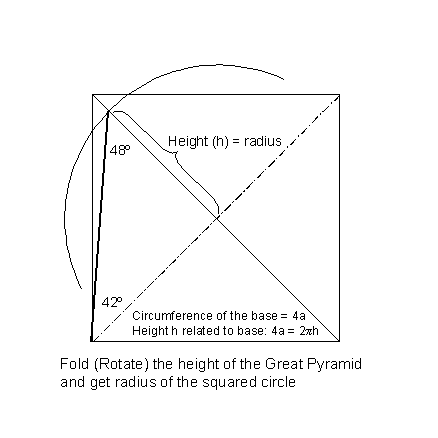
Picture filename:
square-circle.gif
If you are
making the actual pyramid and have four pieces for a base, get the
pyramid's edge length by multiplying the base by 0.951. (5% is one
part in twenty and Mayans would then subtract one part because of
their vigesimal counting system. Ancient Egyptians would use 1/18th
but 1/20th is much more accurate.) If the base of the pyramid is four
units on a side then the area and the circumference of the base are
the same. To be "totally cosmic," use a particular distance
that is derived from actual cosmic dimensions and apply it for a
base. For example, four meters is 1/10,000,000 of the Earth's
circumference along the longitude.
Note:
Present day
mathematicians have no idea why ancient Egyptian mathematicians
expressed fractions as a sum of only those fractions in which the
numerator is 1. Thus, 5/8 was written as 1/2 + 1/8. A good reason for
doing such elaboration can be found in the harmonics
series Sum(1/n). The sequence number n is not repeated
in the harmonics series nor was it repeated by the Egyptians.
For extra
mystique you may include the destruction of Fourier memorials by the
(Nazi) Germans, Fourier proof that all frequencies fit into 2 ,
and (of course) the UFO post-crash environment. Also consider what
it means to have 90 degree rotation (if you are 100% real then this
means nothing). ,
and (of course) the UFO post-crash environment. Also consider what
it means to have 90 degree rotation (if you are 100% real then this
means nothing).
The orbital
ratio of Earth and Venus is 5/8. If you know details on ancient
Egyptians' fractions, you will also know about the only exception
Egyptians made for fraction 2/3. That is the ratio of Neptune and
Pluto orbits. In mainstream magazines most present day astronomers
show that they 'have credentials -- write trash' when they question
Pluto's purpose as a planet. For more on harmony of the spheres link
up to New
Star In The Heaven.
Note
{Mar 31, 2004}:
All pyramid
references calculate the angle at the midpoint of the base going up
the face of the pyramid. The idea is to present the pyramid in the
framework of pyramid construction from a solid material rather than
building the frame of the pyramid. The ancient Egyptians had called
this angle the seked, which is the cotangent of the base and
the side planes. The angle at the midpoint of the base is the
steepest one possible and, (maintaining the circle-squaring geometry)
such angle should be 51.8539.. degrees. The pyramid-writers, however,
fail to examine this angle in its general format:
x
= sin-1( 2/16
+1)-½ 2/16
+1)-½
Comparing this
solution with the one for the edge of the pyramid, we will
find that the
Euler's
harmonics series term  2/8
is still there but it is now halved. By taking a walk [or dance]
around the pyramid the Euler's term diminishes by half at the
midpoint of the base and goes back up to its full value at the
pyramid's edge. There is one point in each quadrant on the base of
the pyramid where pi is not needed but at this point the construction
angle is most likely [better be] transcendental. 2/8
is still there but it is now halved. By taking a walk [or dance]
around the pyramid the Euler's term diminishes by half at the
midpoint of the base and goes back up to its full value at the
pyramid's edge. There is one point in each quadrant on the base of
the pyramid where pi is not needed but at this point the construction
angle is most likely [better be] transcendental.
Looking at
circle-squaring from the proper perspective: We would be in a real
pickle if  was not transcendental.
was not transcendental.
Notes:
{April 30, 2004}:
Squaring of
the circle by geometric (quadratic) means is impossible. The
impossibility, however, is but an interim step. Squaring of the
circle is the koan of Western origin, which, as any koan, surfaces
the transcendental aspects of nature.
{June 30, 2004}:
All three
pyramids at Giza have a straight pathway from the mid-base to the
edge of water but each pathway has different direction. At the end of
each pathway there is a highly symmetrical structure dedicated to a
particular deity. These partly subterranean structures seem to have a
transducer/impedance match/resonator function. What stars are rising
from the horizon annually for the first time at these pathway
directions? Pumping cosmic energy or just pretend-cosmic-vapors?
Pi, the golden
ratio (Phi), and e are all related. It seems ancient
Egyptians liked the golden ratio (Phi)(Phi-1)=1 but Pi allows the
substitution of Euler's series, which gives additional insight.
{September 1, 2004}:
In DSSP
September '04 Exercise, additional work on Golden ratio makes a
case that the tie-in of Pi to the Great pyramid may be incidental,
for primary purpose of the Great pyramid geometry was the tie-in to
the Golden ratio Phi rather than Pi.
{January 10, 2007}:
Squaring
of the circle now has a page of its own. It's about the energy
and what needs to get done if infinite components are superposed to
complete the circle's construction in finite time.
{May 5, 2007}:
Constructing
the outline
of the Great pyramid is easy. First, construct the golden proportion.
|
Quantum Pythagoreans
book establishes the foundation for the understanding and application
of energy. Because the energy can be multidimensional and exists in
superposition -- it is mutually inclusive -- certain geometric
structures are needed for the organization of energy. The pyramid
forms a computational construct for dealing with and applying such
energy. My job was to put all this in a simple, cohesive, and
systemic manner for the reader's understanding and appreciation. More
.. |
|
|
 |
|
DSSP Topics for February '04
Why would
things hold together in a continuum? Just add energy.
Introducing
space-energy continuum as a gateway to reversible transformations |
|
Background
Continuum has
a nice ring to it. Continuum just keeps going and forever doing
whatever it is we wish for. Momentum is a continuum of mass and
velocity because mass-velocity product continues to be conserved
regardless of the size and the number of colliding bodies. Space-time
continuum would have you believe that spatial distance and time
cannot be separated. However, all nonlocal events ignore space-time
continuum and if you were the inventor of the space-time continuum
you would have no choice but to ignore anything that deals with nonlocality:
transistors, lasers, electron microscopes, Bell experiments and, of
course, UFOs.
As an advocate
of space-time continuum you could divide the universe into macro and
micro, and pretend you know the macro part. Even though there is
money, fun and survival to be had in integrated circuits and
communications, the best anyone can offer the believers in space-time
continuum is that you cannot get anywhere from here in less than a
million years.
One thing that
is proven is the conservation of energy. For example, momentum is a
moving energy and momentum -- the continuum of the mass-velocity
product -- is conserved because the energy adds up to the same value
before and after some operation such as collision.
Exercises
-
Neither
spatial distance nor time contain energy, individually or in
combination. You conclude (pick all that apply):
-
Space-time
continuum is really arithmetic equivalence of spatial distance and
time that arises in simple systems such as two-body systems. Time and
spatial distance are related through an equation in a rather narrow
subset of the real world. More often than not, real parameters such
as temperature, pressure, humidity and density must be held constant
to simplify the system and coax space-time continuum to hold and
behave tractably (if not linearly)
-
Space-time
continuum is derived from certain relationships but such
derivative cannot then be applied to constrain other relationships.
Scientists treat all variables symmetrically and they have no clue
how to differentiate the leading and the following variables. All
fish are swimmers but swimming will not make you into a fish.
'Swimmer' is the derived (dependent) variable and, therefore,
'swimming' cannot constrain you to be or become a fish. [Even
Aristotle would understand this.]
-
Space-time
continuum advocates find solace in the belief that if they cannot get
there from here, nobody can get here from there. [Besides, you have
free will and to prove it you get yourself a beer.]
-
If you stand
in an elevator and turn the lights off, you will not be able to prove
what planet you are on! [One of the ideas for Adventures
In Pseudoscience, 20th Century edition.]
-
Moving
electron contains energy and becomes a wave. Therefore:
-
When electron
spreads (per Schrödinger evolution, de Broglie wave, and
Heisenberg uncertainty) the electron becomes a vibrating entity,
which can now be described as space-energy
continuum.
Energy keeps the electron together even though, as a wave, the
electron reaches out nonlocally in up to 3D and on macro scale, no less
-
Credit JJ
Thomson who was the first to suggest that atomic particles can spread
and become nonlocal [the proof is in the pudding]
-
Spatial
distance and time cannot form a continuum because neither distance
nor time contain energy that would hold the continuum together
-
Transformations
can and do happen. When a particle changes into a wave (or
vibration), particle unbecomes local because it has a reach well
beyond its original spot. In fact, the spreading of the wave is
unbounded. During transformation some things change while others
remain invariant. You may conclude:
-
By
transforming into a wave, spatial distance is no longer a leading
(dominant, priority) variable. Spatial distance becomes a following
(subordinated) variable because spatial distance is not energy.
Electron-as-wave can now behave nonlocally
-
Some
transformations are reversible while others are not. Reversible
transformations are the way to go for traveling, while nonreversible
transformations are for the one-way street. Matter and antimatter
annihilation is a nonreversible transformation. Other transformations
are easy to do, but difficult to reverse. (Absorption of a particular
light quanta is easy but radiation of a particular quanta is
difficult -- it just looks easy for the atom.)
Note 2/28/04:
Energy and
frequency are related through de Broglie relation. Space-energy
continuum can also be called space-frequency or space-vibration continuum. |
|
 |
|
DSSP Topics for January '04
Microgravity is a
term used by NASA to describe the space station environment. Being
weightless does not mean gravity is gone.
The issue of
angular momentum
Show-stopper? No
problem. Bring in the clowns |
|
Background
It is easy to
put Newton in his pajamas running around in the middle of the night
screaming "The moon is falling, the moon is falling!" Yet
Newton's apple is falling the same way moon is. The moon has
additional velocity component and while moon is indeed falling it is
also missing the earth and so the moon stays in one orbit -- falling
toward and perpetually missing the earth.
In the absence
of gravity you just point your rocket anywhere you want to go, and go
there with the thrust of your engines. The thrust can be as short as
you want and eventually you'll get there. In the earth's orbit,
however, gravity is continuously pulling you in and if you aim your
rocket at the moon, the brief firing of your thrusters will not send
you on the way to the moon but will put you in a more elliptical
orbit. If you point your rocket at the moon and fire your thrusters
when the moon is receding, you may end up coming back to earth.
Another way to
appreciate gravitation is with a beach ball. The ball will deform
under acceleration from the rocket's thrust but the ball will remain
nice and round under gravitational acceleration, as every part of the
ball is accelerated with the same force.
Exercises
-
In the
weightlessness of the orbiting space station (pick all that apply)
-
Gravity is
near zero (microgravity)
-
Gravity is
nearly the same as on earth's surface
-
All objects in
the space station are being accelerated at the same rate and that is
why objects in the space station appear to be floating
-
No experiment
on the space station can ever be performed in microgravity (or in
absence of gravity)
-
To escape
earth's gravity and end up with microgravity, you
-
Dig a hole to
the center of the earth
-
Go about
four-fifths of the way toward the moon (where the earth's pull is the
same as the moon's pull)
-
Go to
geostationary orbit
-
Two of the above
-
If you still
think NASA understands gravitation then consider the past (and
failed) NASA's experiment of reeling out a piece of weight out of the
space shuttle. NASA thought the weight was going to go straight up --
in defiance of angular momentum and radial gravitational acceleration
-
If you still
think NASA can learn from its mistakes then consider the space
elevator where NASA continues to ignore the angular momentum of the
load as the load is being moved up -- it's a show-stopper. (Space
elevator strings strong microtubules from ground to space and NASA
claims to be able to haul a load straight into orbit.) You recommend that:
-
NASA stop
space elevator parade of clowns because the future as portrayed by
NASA is nothing but a delusion. The load must acquire angular
momentum and space elevator will always need rocketry propulsion to
supply angular momentum to each and every load
-
Transfer
microtubule development to another agency such as DOT. Enhance DOT
objective to apply microtubules in compression (tension strength,
suitable for bridges, is a given)
-
Beat up on
NASA engineers and make them do a bang up job while ignoring
fundamentals such as angular momentum and the absence of light's
pressure at reflection
Gravitation Fact
The easiest
and simplest way to prove that all bodies subject to gravitation fall
at the same rate (Credit Benedetti):
Two objects
that have the same weight are falling at the same rate. Because
neither object gets ahead of the other these two objects can be
joined together and, although the joined object is now twice the
weight, the new object is also falling at the same rate. [Need
right-brain for joining operation.]
Notes 1/31/04:
There is
likelihood that matter that is not subject to gravitation will
disappear (become virtual) but will not disintegrate. At minimum,
matter's inertia would decrease in microgravity. Something worthwhile
to look into. (Quite the opposite of what guys like Mach and Puthoff
would say.)
Pythagorean
numerology does not give the number two any positive properties.
Number two (or division into two equal parts), however, becomes
central when proving certain gravitational relationships. Ditto in
the context of momentum creation. [Will be fixed.]
Note {Apr.
30, 2008}:
We have an update on the space elevator in our Oct.
2005 DSSP topic (this page). |
|
 |
|
DSSP Topics for December '03
How can
Incomposite numbers, today called prime numbers, be composing
anything if they are incomposite.
Riemann [a guy
from Wendland] hypothesis has its basis in physics |
|
PrimerOne
The
Incomposite numbers of Pythagoreans are today called prime numbers.
They are incomposite because they are not composed of any other
number. The composition, you note, also refers to a musical score and
you know that with Pythagoras discovery of the musical octave the
Pythagoreans were into music of all kinds. Nice part about
incomposite numbers is that, while no other number can divide into
them, they make all other numbers by multiplying among themselves.
Although prime numbers are indivisible they are also included.
PrimerTwo
Free moving
electron can acquire any energy it wants and thus its wavelength can
be anything it wants. Atomic electron wavelength fits smoothly around
the core wherever it can -- in particular increments. The problem
comes when there is more than one electron because electrons need to
stay away from each other and work with the core on the balancing act
as well. Balancing assures that the electron can be a real electron
at times and a virtual electron at other times while conserving
energy at all times. Virtual electron is the electron state that
allows it to spread as a wave, while the real electron state is
needed when electron must find another orbital as things get hot or
cold. [If you want to get deeper into this, do electron guessing
under Gauss and compute a few matrices with Riemann. You will be
ahead because you now know the real numbers come from the electron
while the virtual numbers come from photons. Here is also a mechanism
that takes random photonic values and selects only those that
subscribe to a particular structure.] When photon is absorbed by the
atom, one half of its energy goes to the core and the other half goes
to the electron because that is the only way of conserving momentum
during energy transfer (really a transformation). In fact, the ½
term of the Riemann's Zeta function comes from the law of the
conservation of momentum. It would be cool to show that the physical
law of the conservation of momentum can be proven through numerical
analysis alone but what also needs to happen is that the energy
imparted on two bodies is not only split 50-50 but that the split is
always in the opposite direction. (Linear momentum can acquire but
one degree of independence.)
Exercises
-
When photon
enters the atom then the electron may need to move into the next
available orbital, and [pick the third one below]
-
Electron adds
half of the absorbed photon's energy to its own energy and tries to
make an orbital with the new energy it has. If that does not work
then the electron leaves the atom [our goal here is not ionization,
which deals with core's computability]
-
Electron
computes the energy of the photon (half is available) and absorbs the
photon only if the new orbital does not bump into another electron
-
Electron
computes the energy of the photon (half is available) and absorbs the
photon only if the new orbital is OK (in harmony) with all electrons
already present
-
Atomic
electron cannot just add any photonic energy to form its own
independent orbital because
-
That's the way
it is and I like Rock and Roll just the way it is
-
The orbital
wavelengths of multiple electrons interact (superpose) with each
other and if their mutual orbital ratios do not add up to a full
wavelength across all orbitals in the octave then there would be
peaks of instability
-
Electron
orbital must harmonize with other orbitals in the octave or across
several octaves. To do that,
-
Compose all
prime numbers that multiply out to multiple orbitals. If there are no
compositions available then that is where the gap is going to be for
sure (forbidden orbital, Zeta function is zero)
-
More multiples
a particular orbital may share with other orbitals the better.
[Pythagoreans call numbers having a large quantity of divisors the
abundant numbers.]
-
Orbitals seem
to fit series (n+1)/n, which has a triangular pattern, numerically
speaking. [Orbital is not the same thing as radius but they are
related. See Kepler in the macro dept.]
Optional:
-
Using the
photon that has just arrived, electron computes energy up and down
(Gaussian distribution being symmetrical) and if it finds a
computable orbital going down, you just discovered how laser and
laser cooling works. Happy New Year!
-
Work with two
(twin peaks) distributions and the highest octave to emulate a
molecule. Perhaps even come up with a brand new molecule. Happy
conjugating! [about the diagonal, too]
-
Using
'incomposite' terminology instead of 'prime' helps with visualization
because it connects in more places. 'Prime' has only the exclusivity
component [the verboten part] and that is not the whole story
Notes 12/31/03:
-
Energy states
in the atom have a wonderful progression of integer squares. (For
thorough, clean, clear, and most understandable primer on quantum
numbers and how they relate to orbitals consider
http://chemed.chem.purdue.edu
/genchem/topicreview/bp/ch6/quantum.html)
[Big deal?
Some energy exchanges are direct transfers rather than transformations.]
-
Gauss
introduced the Modulo math, which is intersted in the remainder after
the division. The physics basis of Modulo math is that the electron
orbitals are stable if the remainder is zero or if the remainder
repeats. If more orbital periods are required before the remainder
repeats the less stable the orbital |

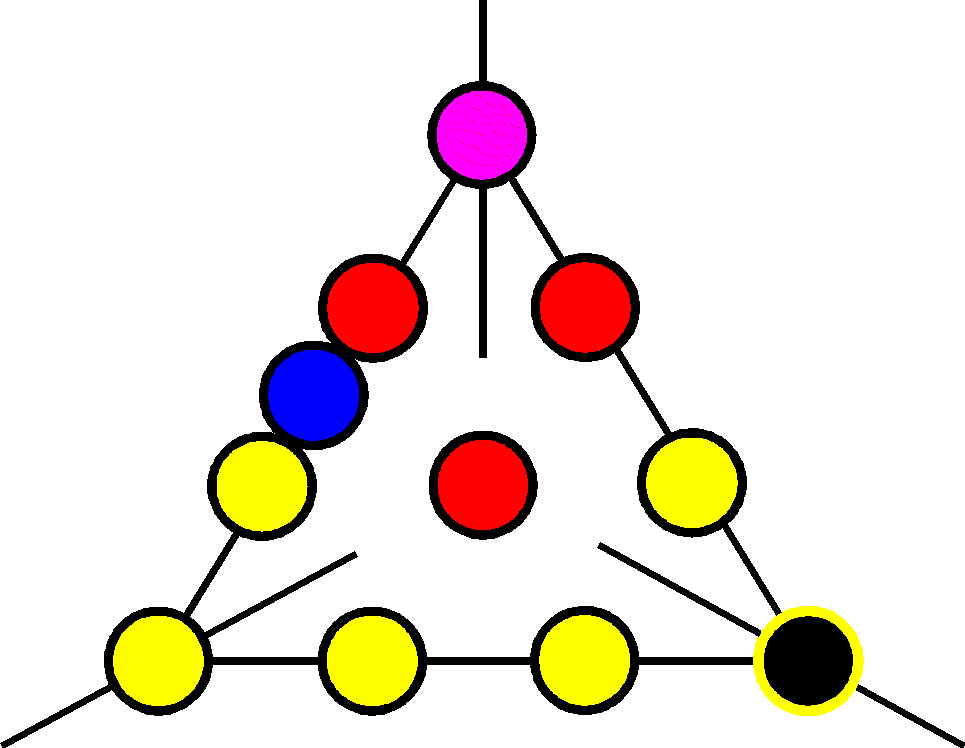
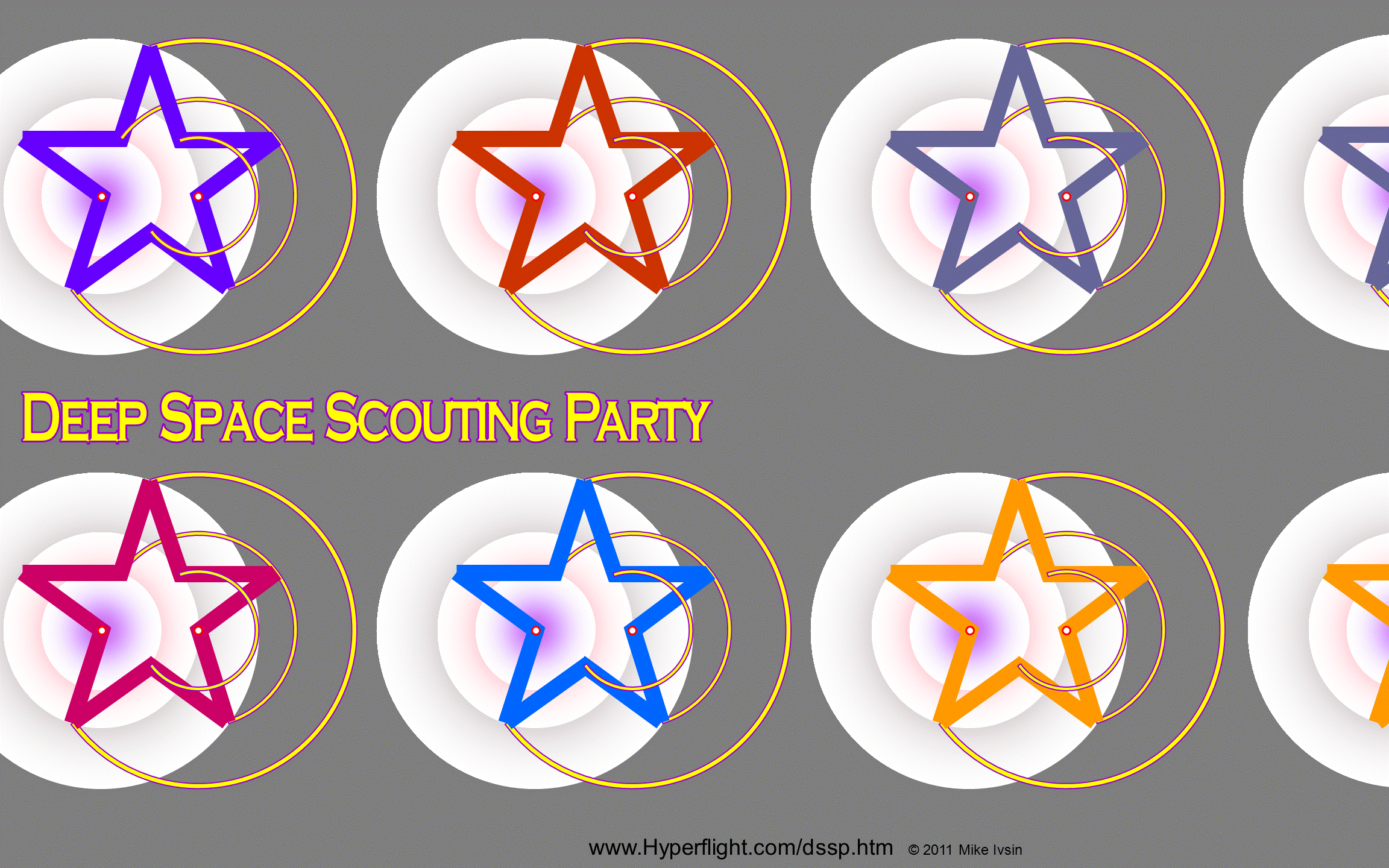
![]()
 More
..
More
..![]()
![]() Every star is a sun-planets system (a solar system) or a sun-sun
(binary sun) system
Every star is a sun-planets system (a solar system) or a sun-sun
(binary sun) system![]() Particular sun's mass can significantly decrease or increase in less
than a decade
Particular sun's mass can significantly decrease or increase in less
than a decade![]() Particular sun's angular momentum which, for our solar system is
about 2% of the total, can increase significantly as well
Particular sun's angular momentum which, for our solar system is
about 2% of the total, can increase significantly as well![]() Star color or size is not linked to star's age
Star color or size is not linked to star's age![]() If a galaxy's axis of rotation is nearly identical to another
galaxy's axis of rotation (two galaxy subsystem) then these two
galaxies will spin in opposition — one cw and the other ccw
— and, in addition, both galaxies will rotate in a plane
perpendicular to the axis. Both galaxies will cup slightly forming
two caps of a sphere
If a galaxy's axis of rotation is nearly identical to another
galaxy's axis of rotation (two galaxy subsystem) then these two
galaxies will spin in opposition — one cw and the other ccw
— and, in addition, both galaxies will rotate in a plane
perpendicular to the axis. Both galaxies will cup slightly forming
two caps of a sphere![]() Planet is created when it spins off the sun after a 2D solar angular
momentum buildup
Planet is created when it spins off the sun after a 2D solar angular
momentum buildup![]() Planetary (and multiple moon) separation orbits are in ratios of
notes of the musical octave. (Real numbers have finite mantissa and
notes of the octave have the smallest/shortest mantissa.)
Planetary (and multiple moon) separation orbits are in ratios of
notes of the musical octave. (Real numbers have finite mantissa and
notes of the octave have the smallest/shortest mantissa.)![]() The ability to interchange linear and angular momentum within each
solar system and among neighboring solar systems accounts for the
stiffness of a galaxy — that is:
The ability to interchange linear and angular momentum within each
solar system and among neighboring solar systems accounts for the
stiffness of a galaxy — that is:![]() The expansion of the universe is a direct reflection of its increase
in organization
The expansion of the universe is a direct reflection of its increase
in organization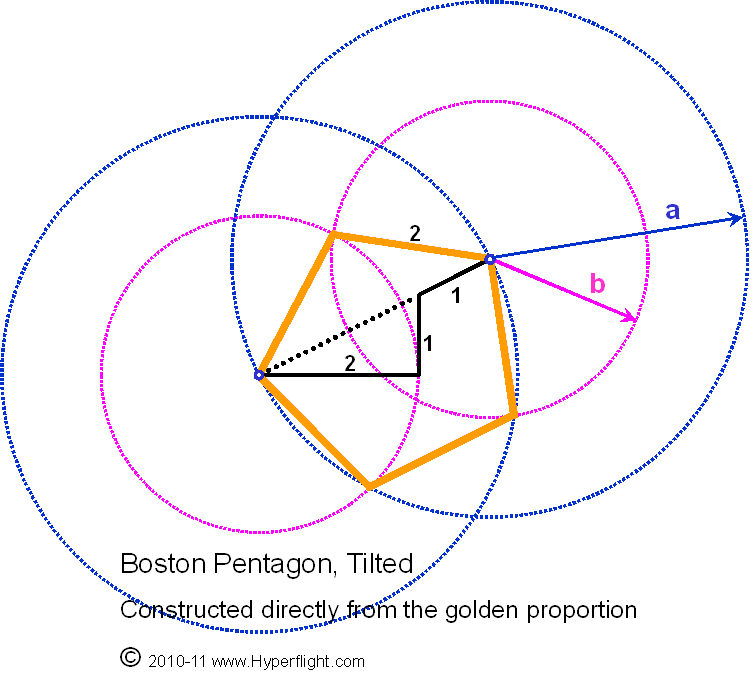 So
now
So
now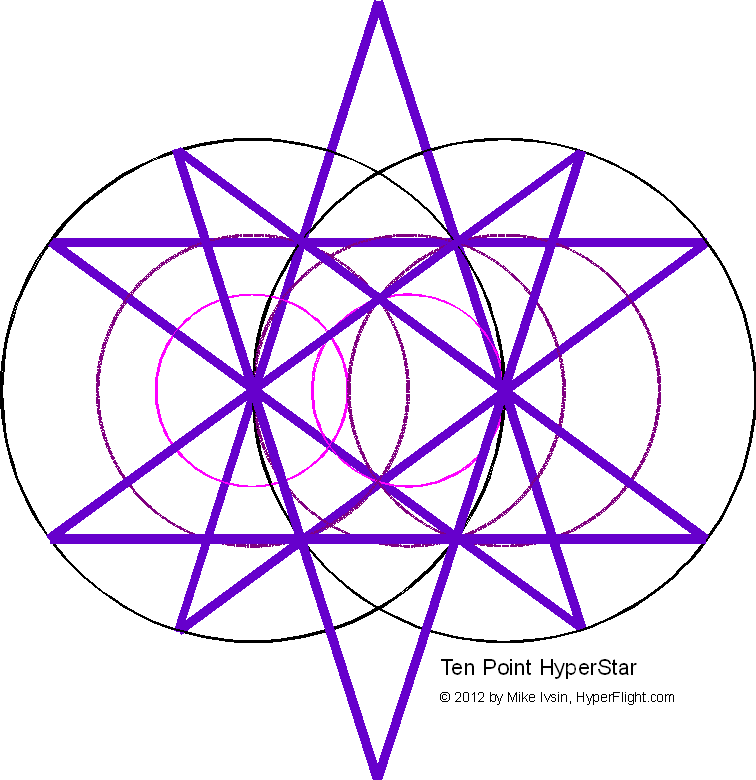 Hyperstar
Hyperstar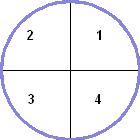 The
circle quadrant pairs 1&3 as well as 2&4 have odd symmetry.
A nice part is that pairs 1&2 as well as 3&4 have even
symmetry and so the circle is not exclusively even or odd. Lao Tzu
(the author of Te Tao Ching) goes as far as to call a circle the
'undifferentiated whole.' This also works but, as is the case with
Tao, it takes a lot of right brain work. [Yes, scientists do not have
the right brain.]
The
circle quadrant pairs 1&3 as well as 2&4 have odd symmetry.
A nice part is that pairs 1&2 as well as 3&4 have even
symmetry and so the circle is not exclusively even or odd. Lao Tzu
(the author of Te Tao Ching) goes as far as to call a circle the
'undifferentiated whole.' This also works but, as is the case with
Tao, it takes a lot of right brain work. [Yes, scientists do not have
the right brain.] A
Wave
A
Wave Yes,
we have a picture. I count the points in a convention that goes
clockwise starting at the top and then you have to skip six points to
get this harmonious ten pointed star. In Wicca or on this site, this
ten pointed star could also be classified as
"couterclockwise," because connecting the first two points
looks as going CCW.
Yes,
we have a picture. I count the points in a convention that goes
clockwise starting at the top and then you have to skip six points to
get this harmonious ten pointed star. In Wicca or on this site, this
ten pointed star could also be classified as
"couterclockwise," because connecting the first two points
looks as going CCW. Background
Background Folded
Up
Folded
Up
 The
Hyperstar
The
Hyperstar While
the basic hyperstar is five pointed, two of them can be put together
180 degrees out of phase by overlapping the circles.
While
the basic hyperstar is five pointed, two of them can be put together
180 degrees out of phase by overlapping the circles.  The
result is a ten pointed hyperstar. Technically, this star is not
regular. However, it is quite useful and that is one reason why I am
proposing the NC Star category here.
The
result is a ten pointed hyperstar. Technically, this star is not
regular. However, it is quite useful and that is one reason why I am
proposing the NC Star category here. Here
is a pentacle. The two circles are concentric with the sun in the
center. Yes, they are the orbits of actual two planets. If drawn as
shown with the sequence 1-2-etc., the star is harmonious. In our
definition it is a CC star with five extreme points. CC (concentric
circles) star means it skips the same number of points during its
creation and, in this case the star's construction skips 2 points
going (always) clockwise. The numerical characterization (explained
in the book) is (5+3)/5 and this also tells you whether the
star is cw or ccw and if it is harmonious. Now, this picture is a
simplification of a real two-planet merged orbit because the points
are connected in straight lines (in order the points are made). So
how does a real and actual merged-planet orbit look like?
Here
is a pentacle. The two circles are concentric with the sun in the
center. Yes, they are the orbits of actual two planets. If drawn as
shown with the sequence 1-2-etc., the star is harmonious. In our
definition it is a CC star with five extreme points. CC (concentric
circles) star means it skips the same number of points during its
creation and, in this case the star's construction skips 2 points
going (always) clockwise. The numerical characterization (explained
in the book) is (5+3)/5 and this also tells you whether the
star is cw or ccw and if it is harmonious. Now, this picture is a
simplification of a real two-planet merged orbit because the points
are connected in straight lines (in order the points are made). So
how does a real and actual merged-planet orbit look like?  More
examples
More
examples All
concentric stars are unicursal. This means the trace goes on without
stopping or jumping and eventually ends up at the starting point.
This is yet another outcome from the orbital application and the
planetary real world tie-in. A trace can take any-some-such path to
get from one point to the next. However, because the star is tied to
the real world application the path from one point to the next will
always have the same distance. Another way of saying it is that if a
star's trace skips a point then it continues skipping but one point
going around the circle (and cannot suddenly skip two points). In yet
another way of saying it, the star is regular during its creation,
which means that going from one point to the next will take the same
angle. The star can then be simplified by connecting the points in
the sequence they are reached but much information can be lost. For
example, if we were to connect the above Neptune-Pluto points, they
would end up on a straight line.
All
concentric stars are unicursal. This means the trace goes on without
stopping or jumping and eventually ends up at the starting point.
This is yet another outcome from the orbital application and the
planetary real world tie-in. A trace can take any-some-such path to
get from one point to the next. However, because the star is tied to
the real world application the path from one point to the next will
always have the same distance. Another way of saying it is that if a
star's trace skips a point then it continues skipping but one point
going around the circle (and cannot suddenly skip two points). In yet
another way of saying it, the star is regular during its creation,
which means that going from one point to the next will take the same
angle. The star can then be simplified by connecting the points in
the sequence they are reached but much information can be lost. For
example, if we were to connect the above Neptune-Pluto points, they
would end up on a straight line. Background
Background





 Energy
and Geometry
Energy
and Geometry illustration
filename: hyperstar_free_spirit.gif
illustration
filename: hyperstar_free_spirit.gif illustration filename: hyperstar_north-south_escape.gif
illustration filename: hyperstar_north-south_escape.gif illustration
filename: hyperstar-pentacle-fancy.gif
illustration
filename: hyperstar-pentacle-fancy.gif

 illustration filename: photon-split.gif
illustration filename: photon-split.gif






















 Pythagoras
on a Greek coin (date of coin unstated).
Pythagoras
on a Greek coin (date of coin unstated).






